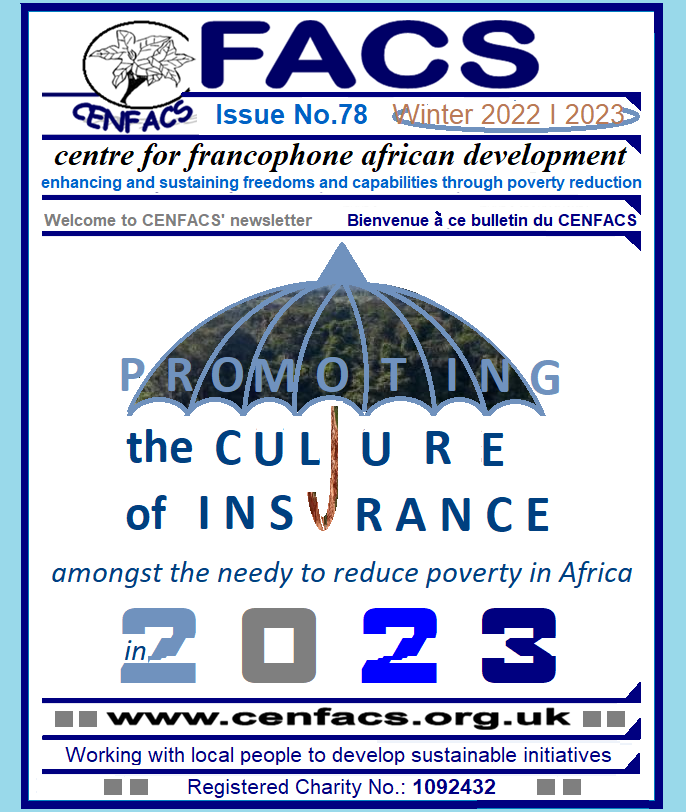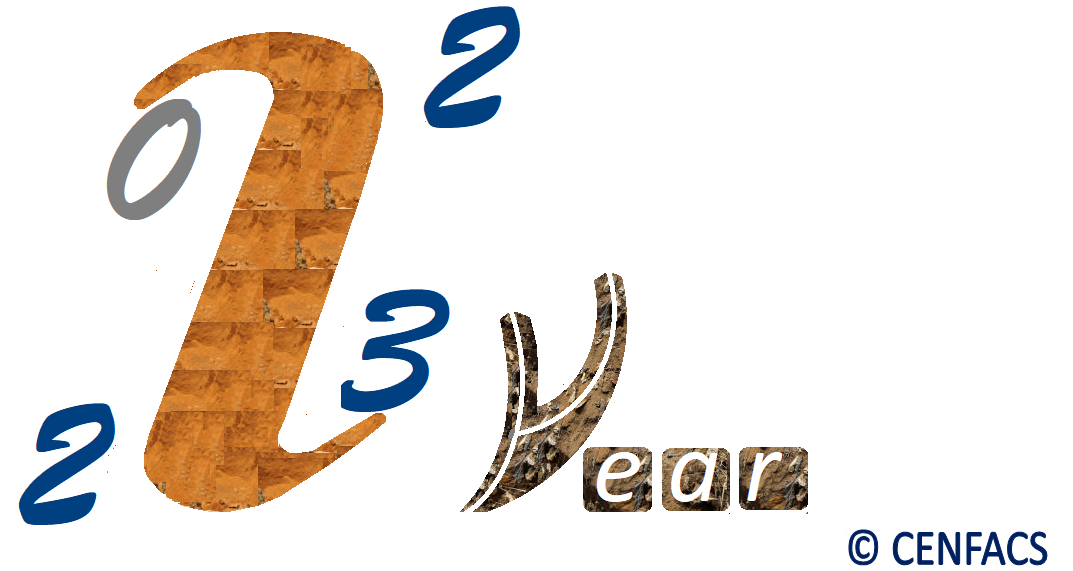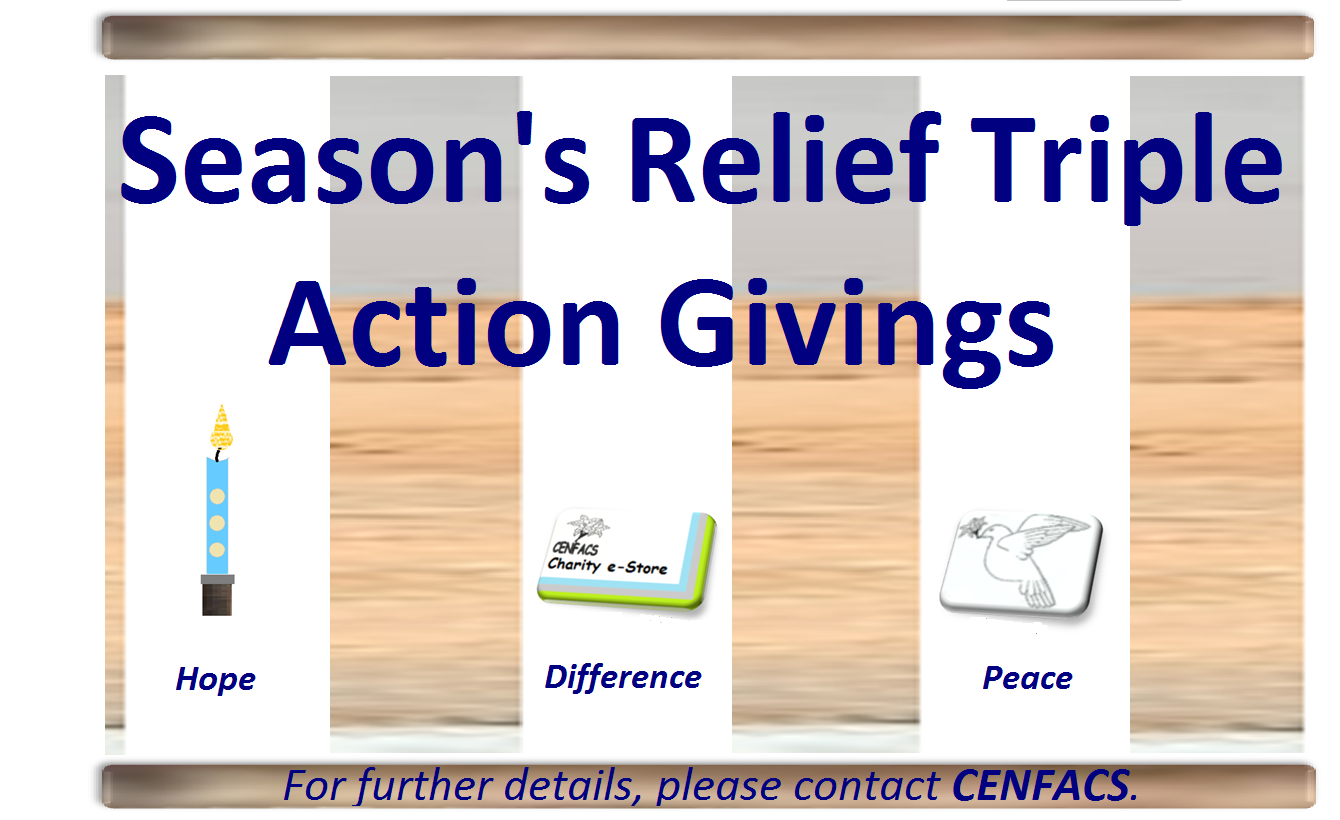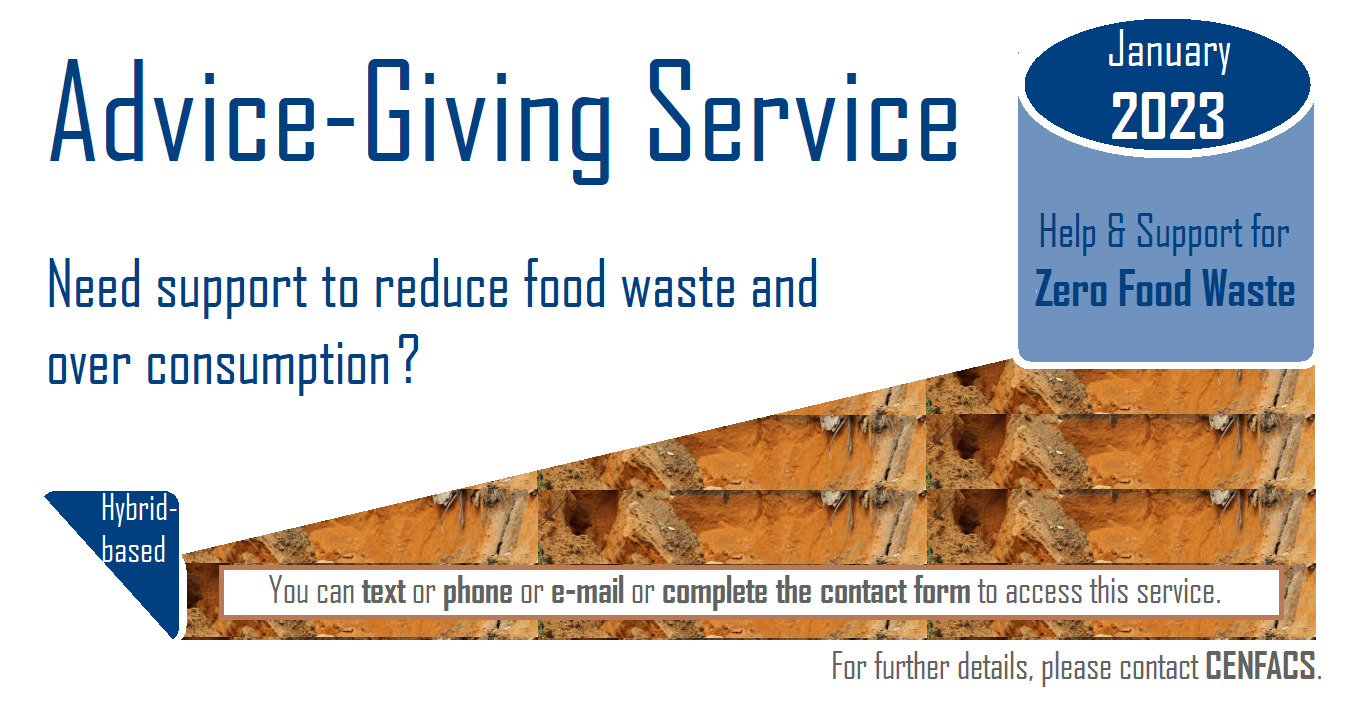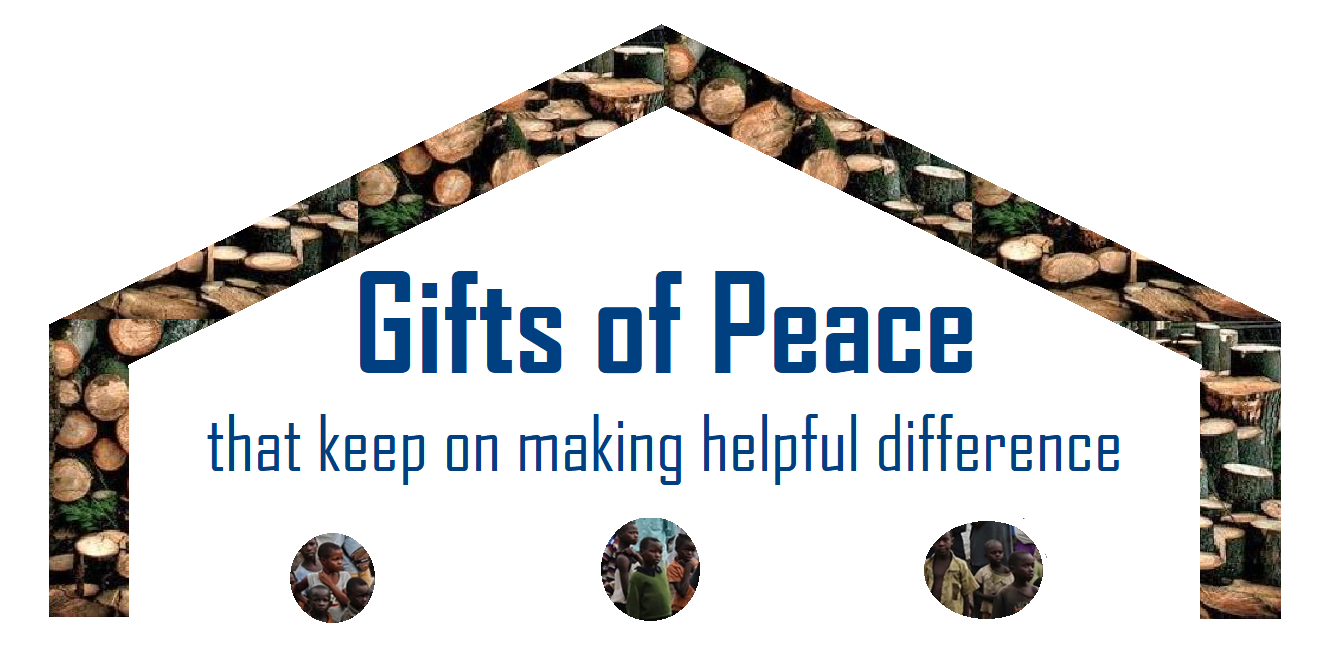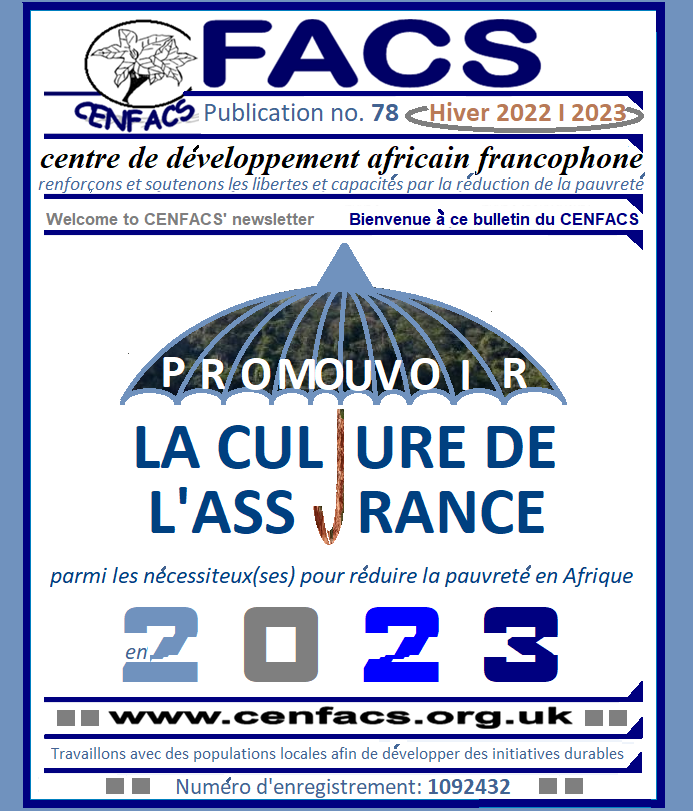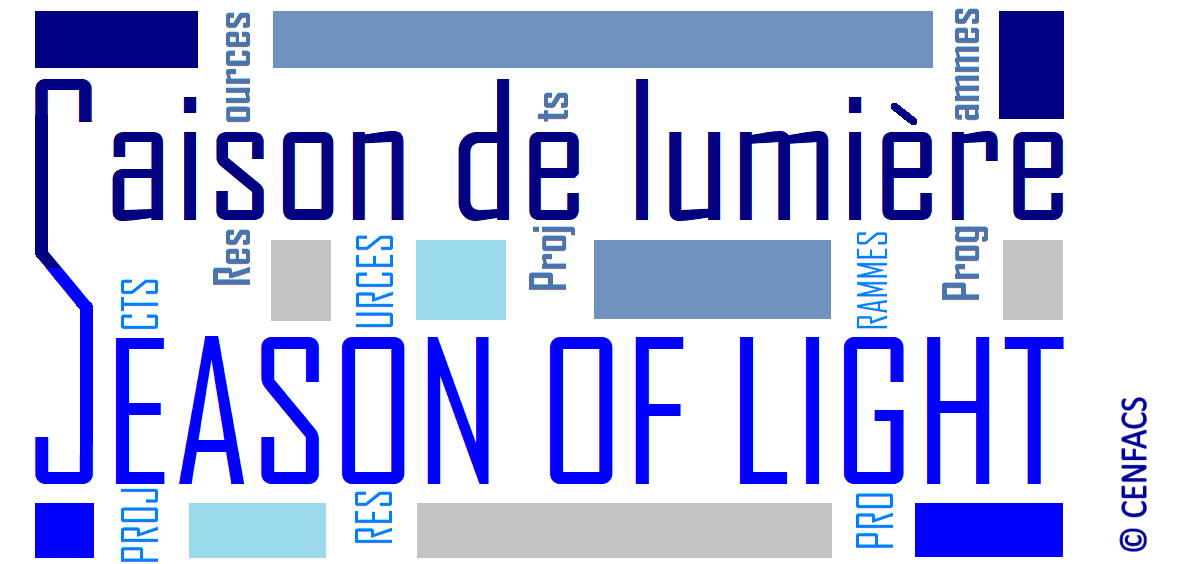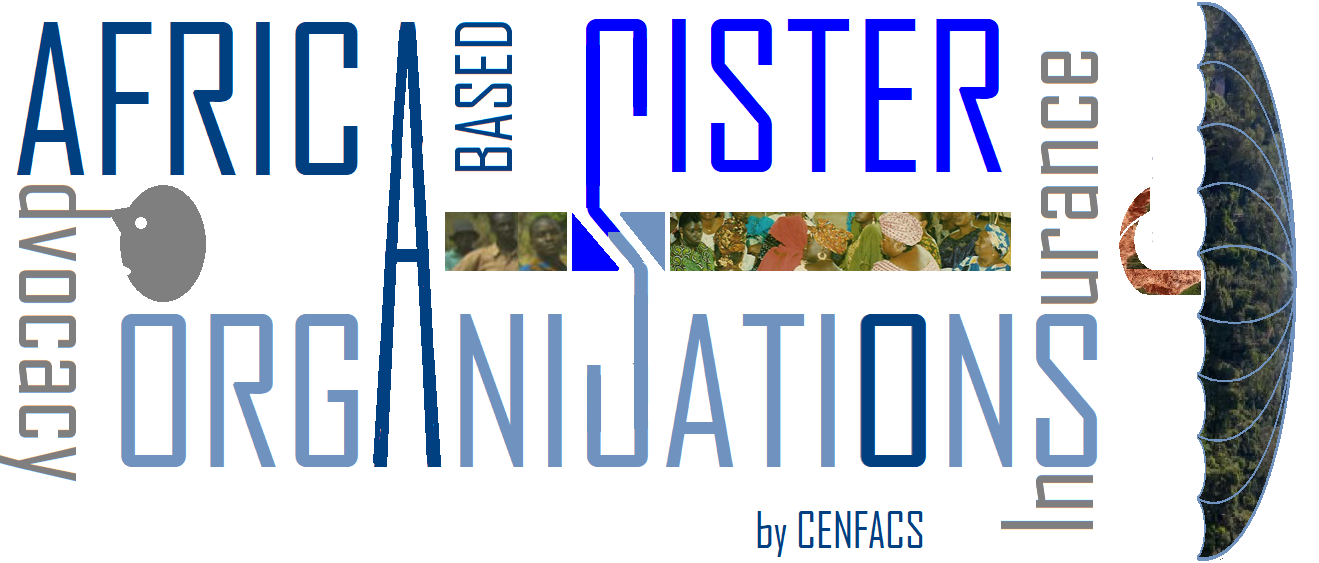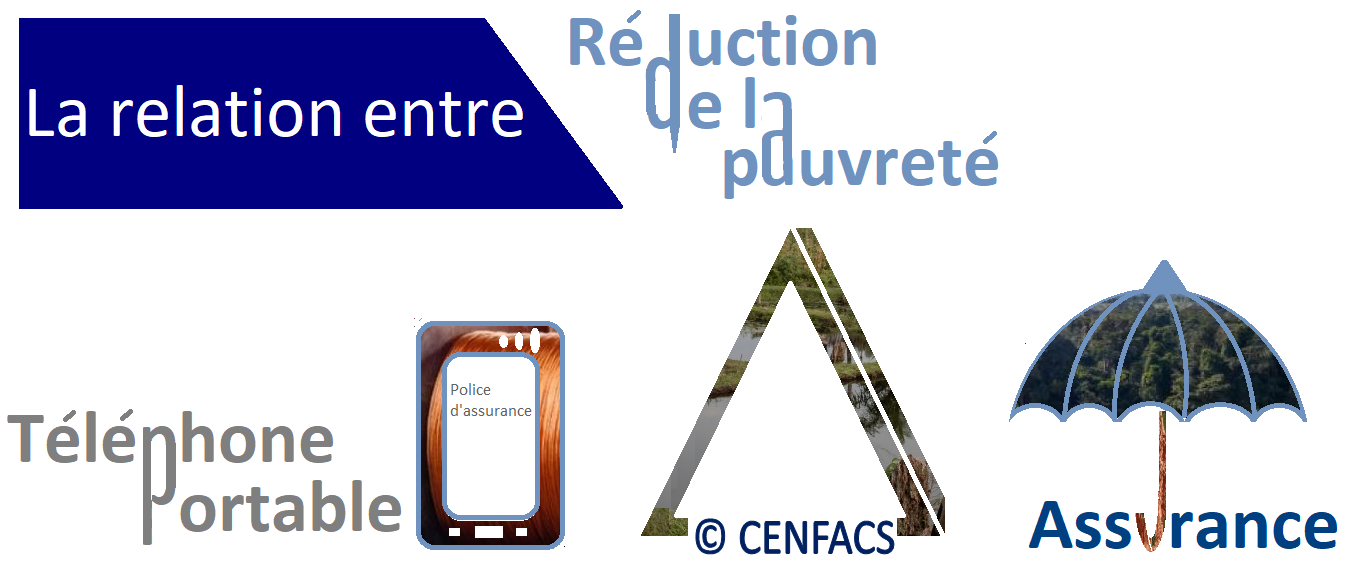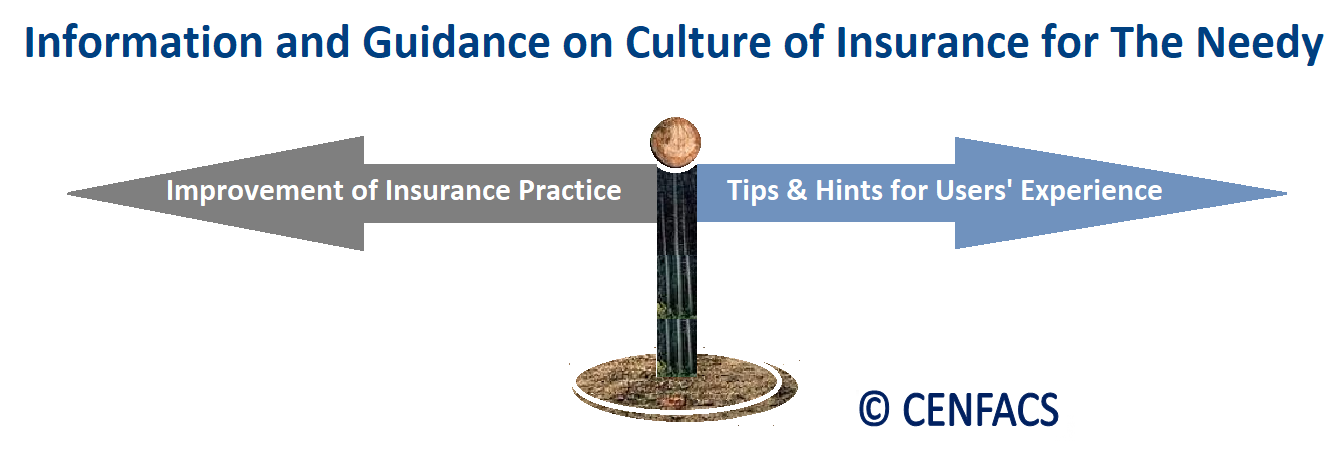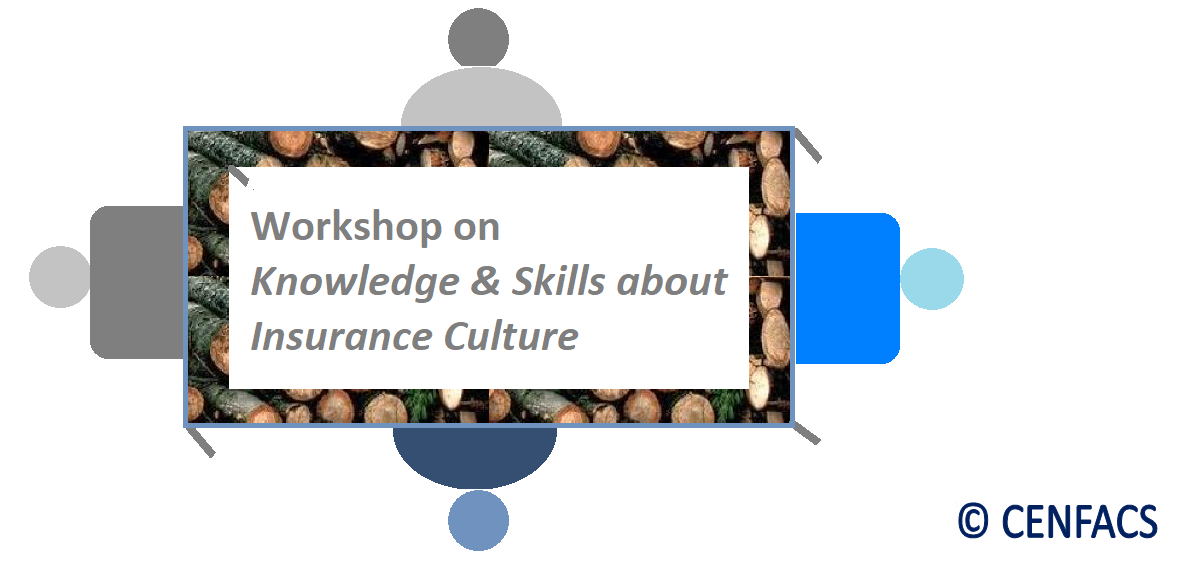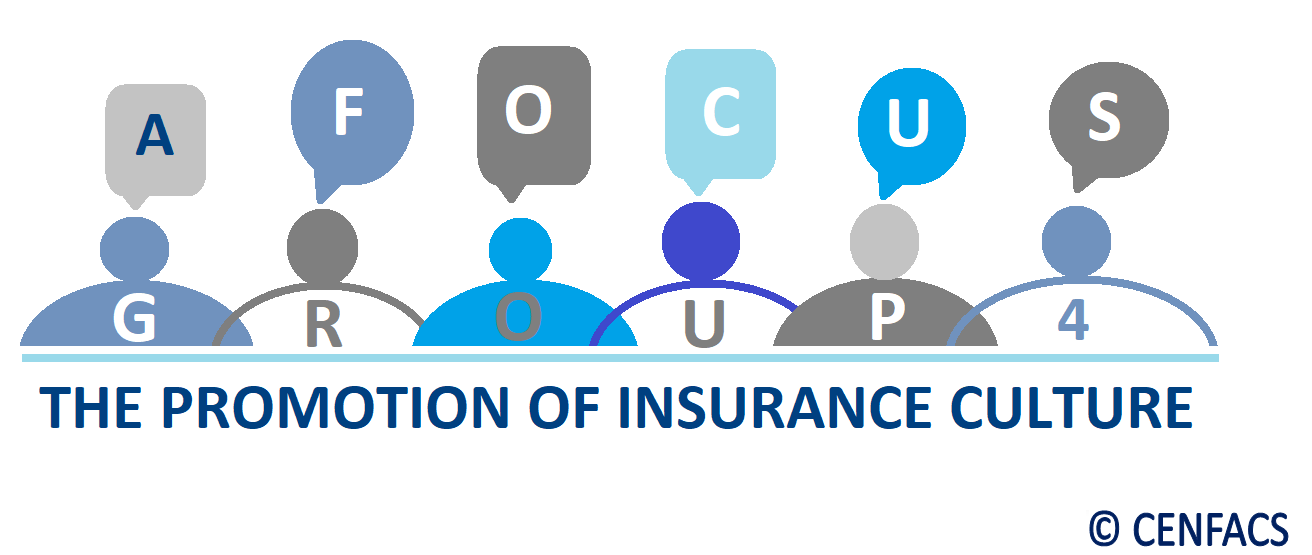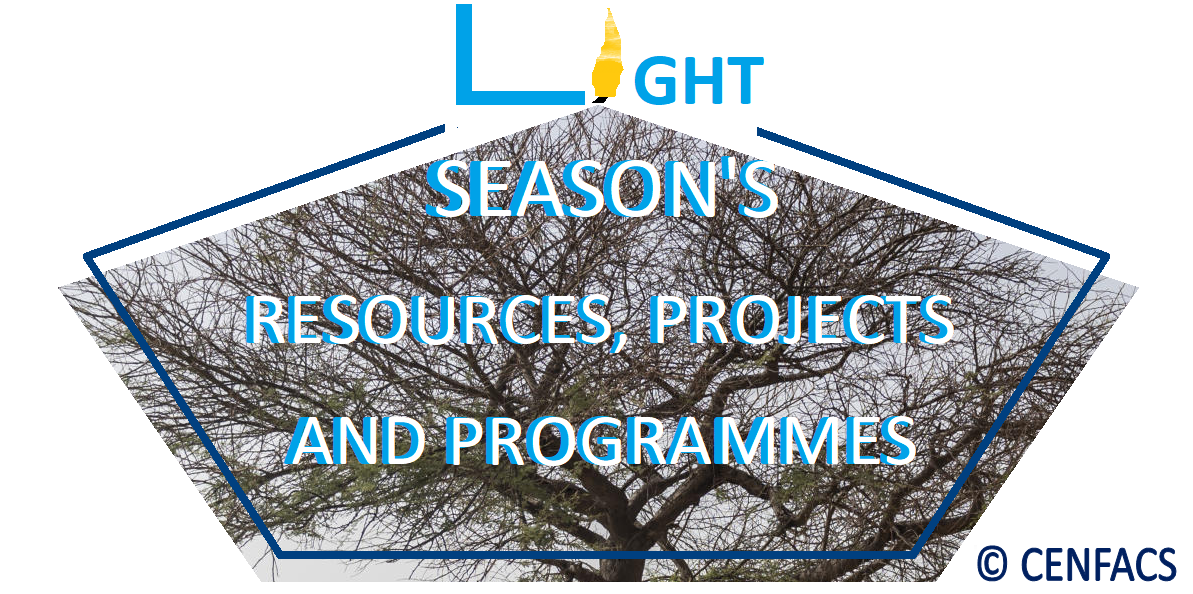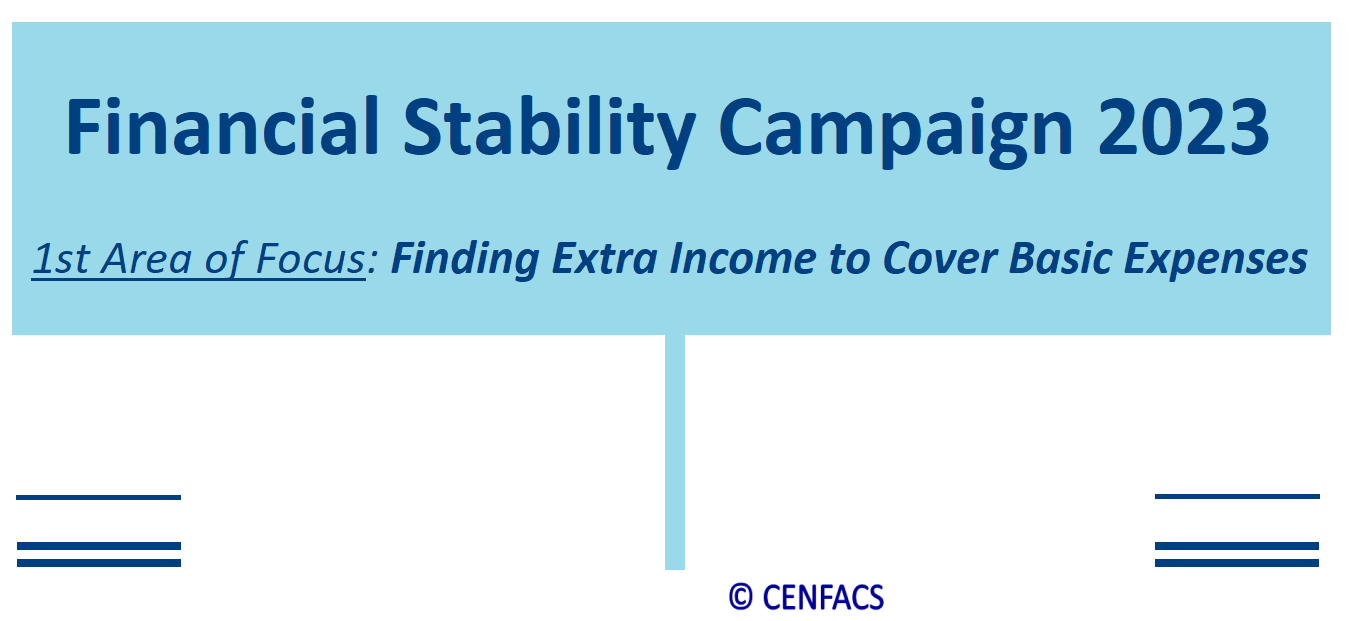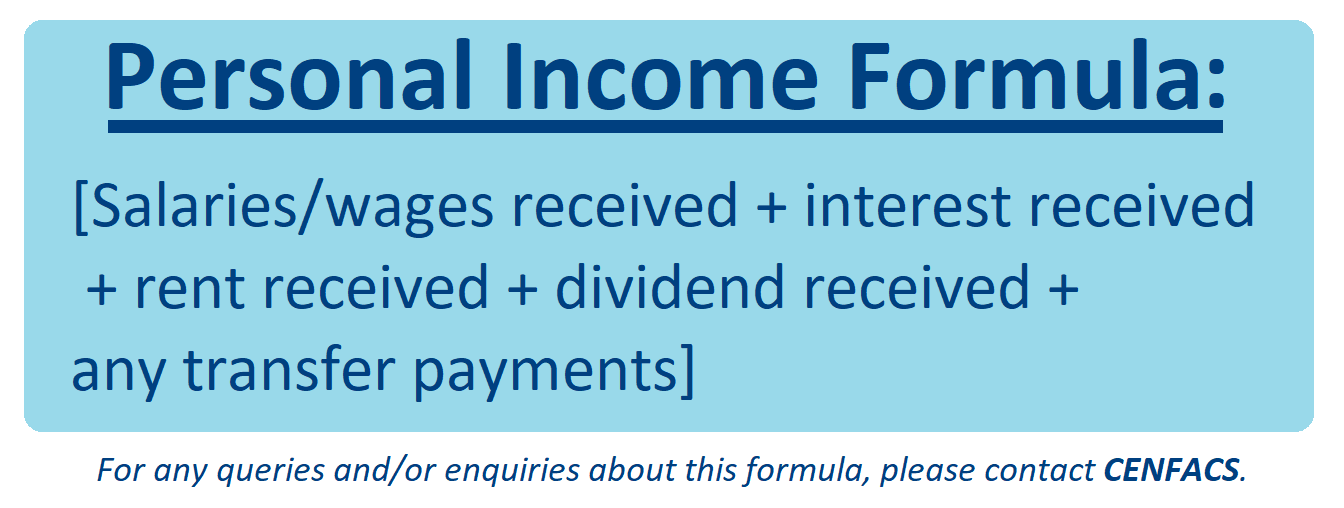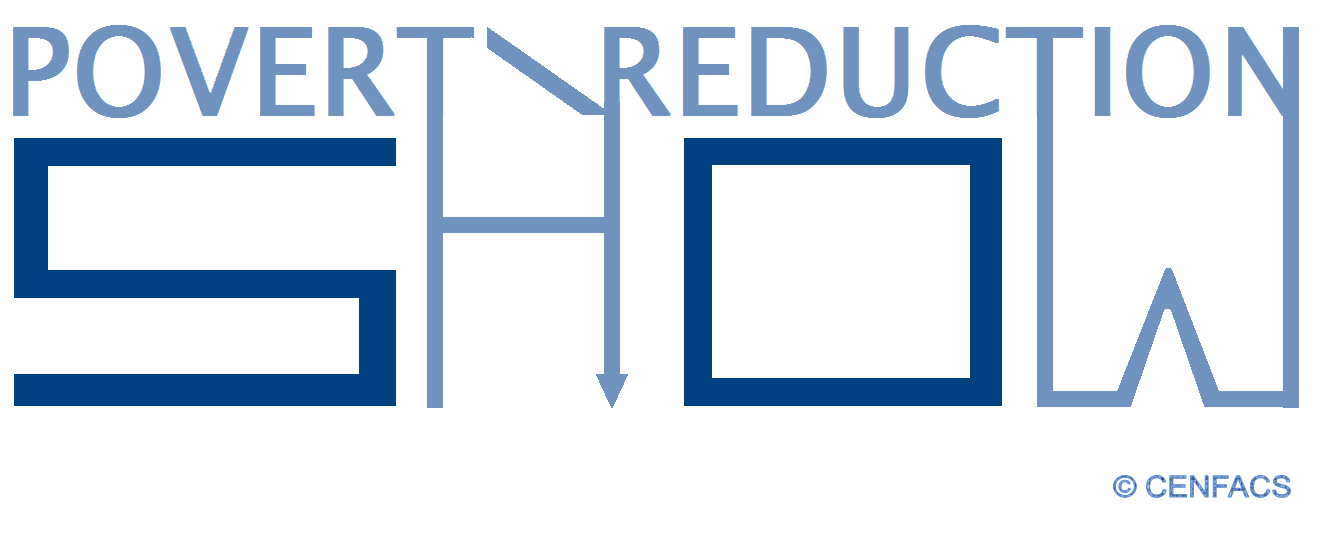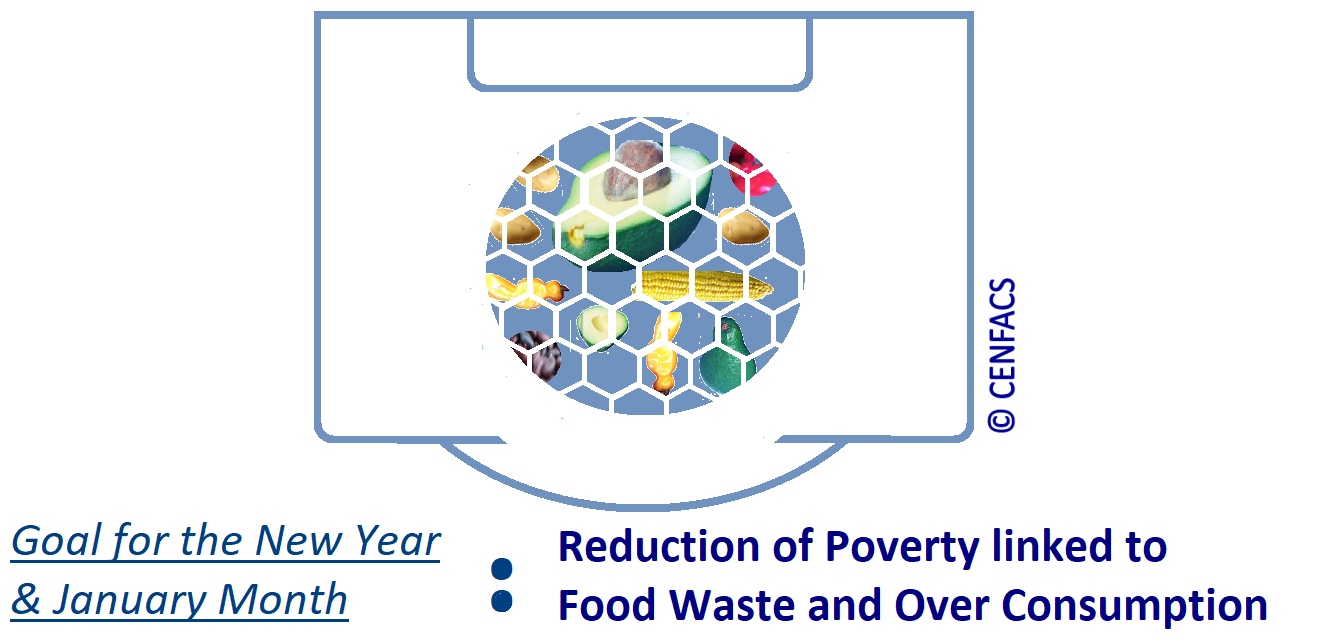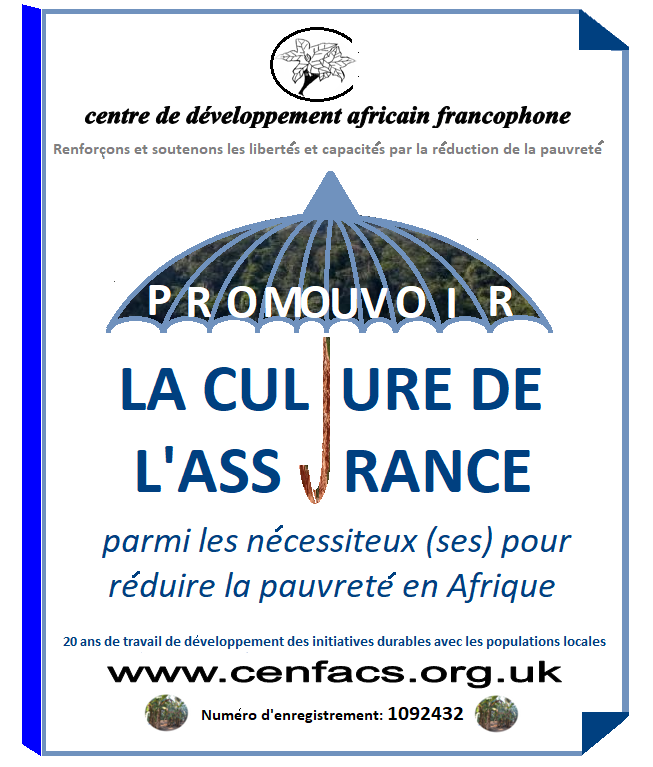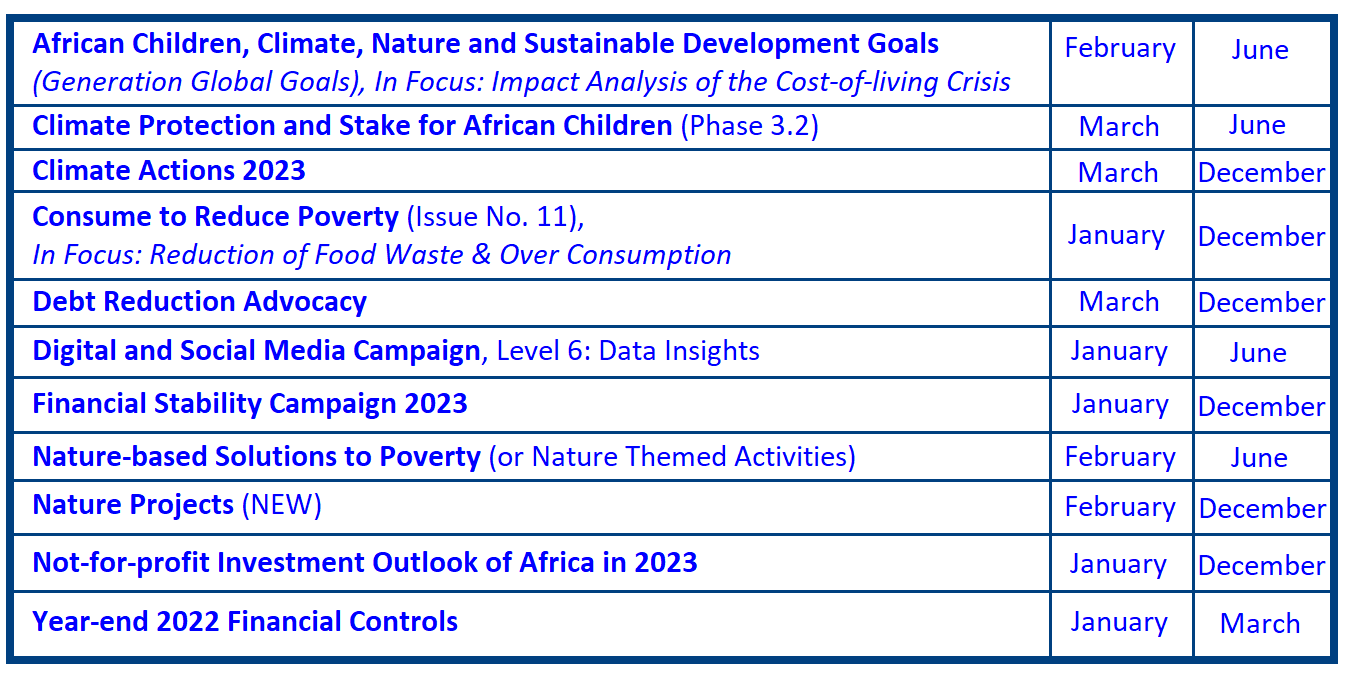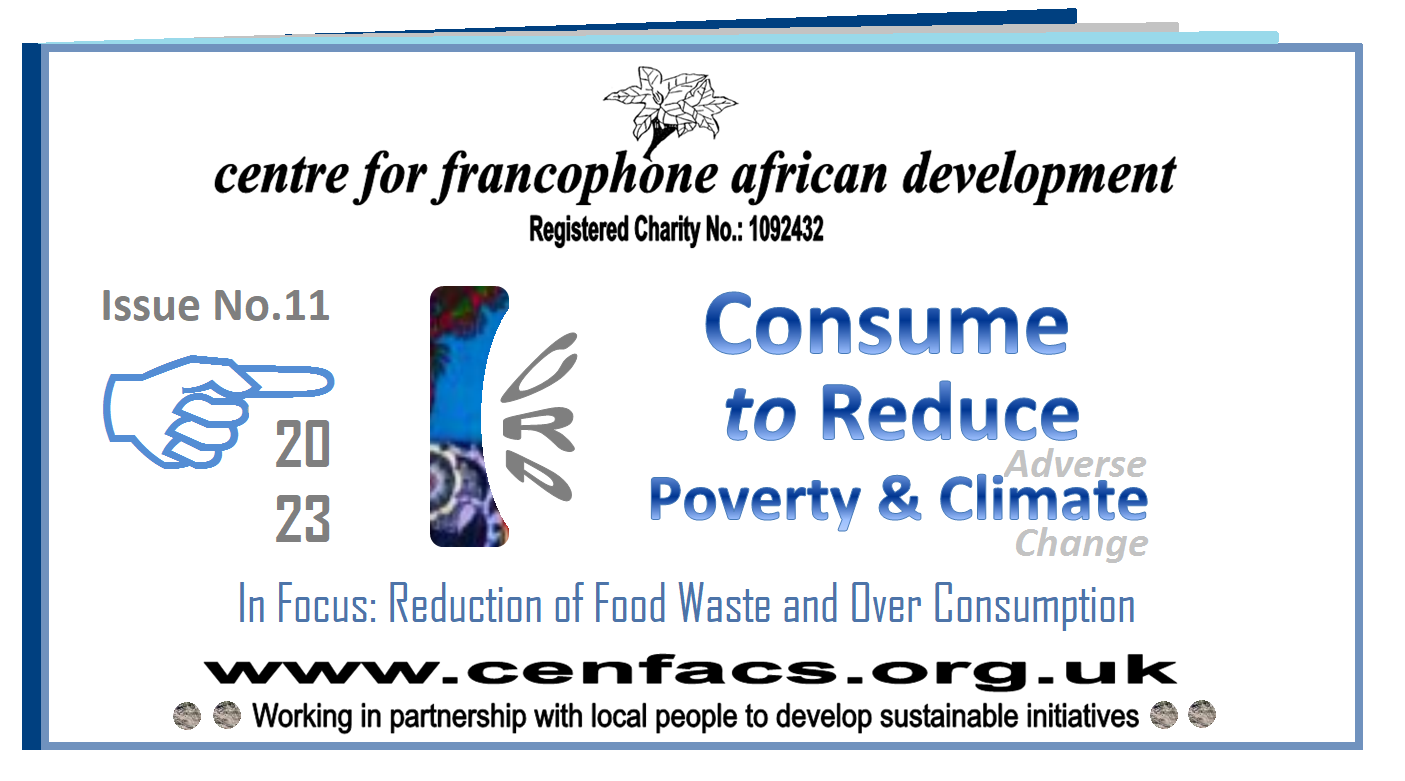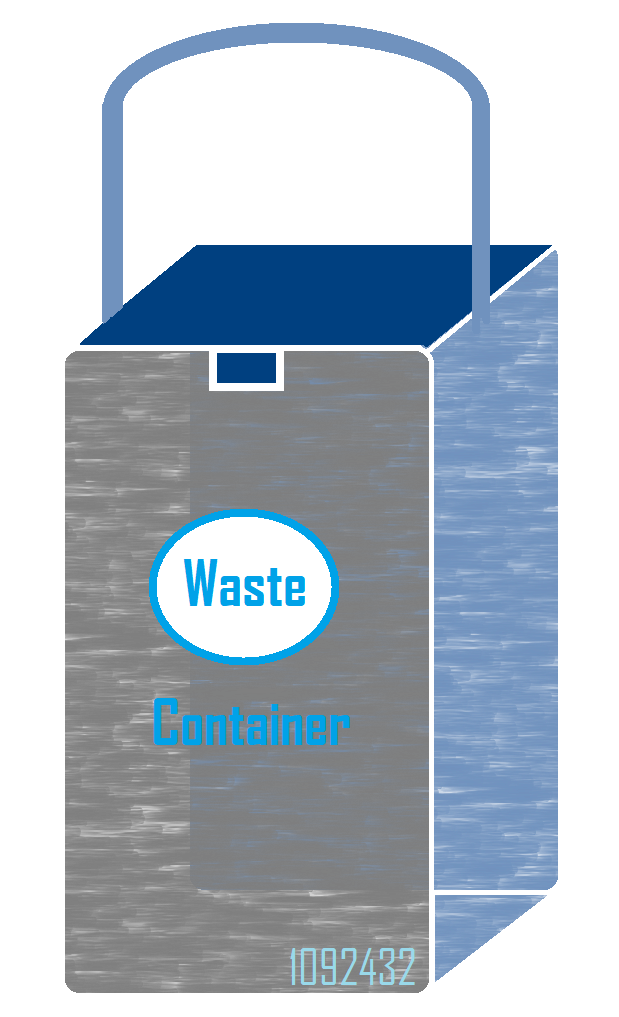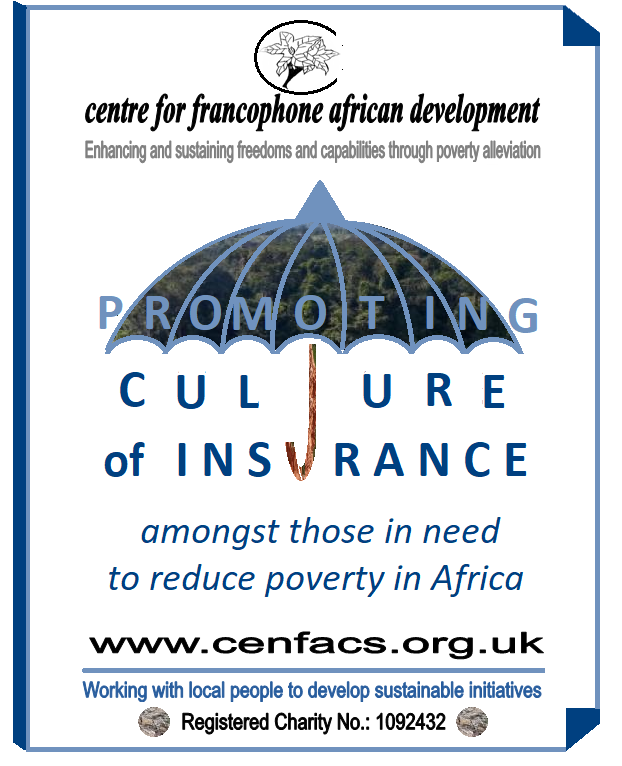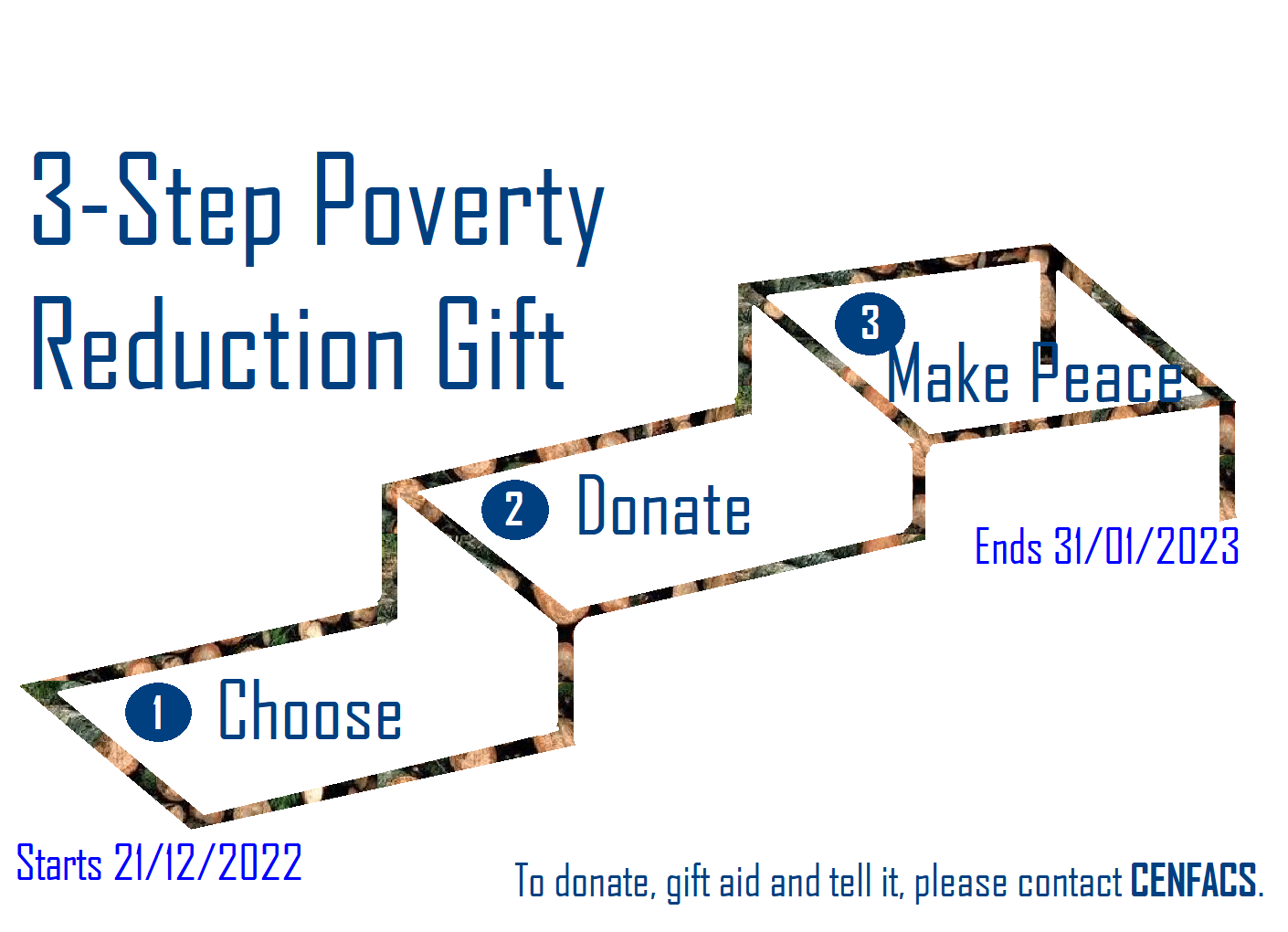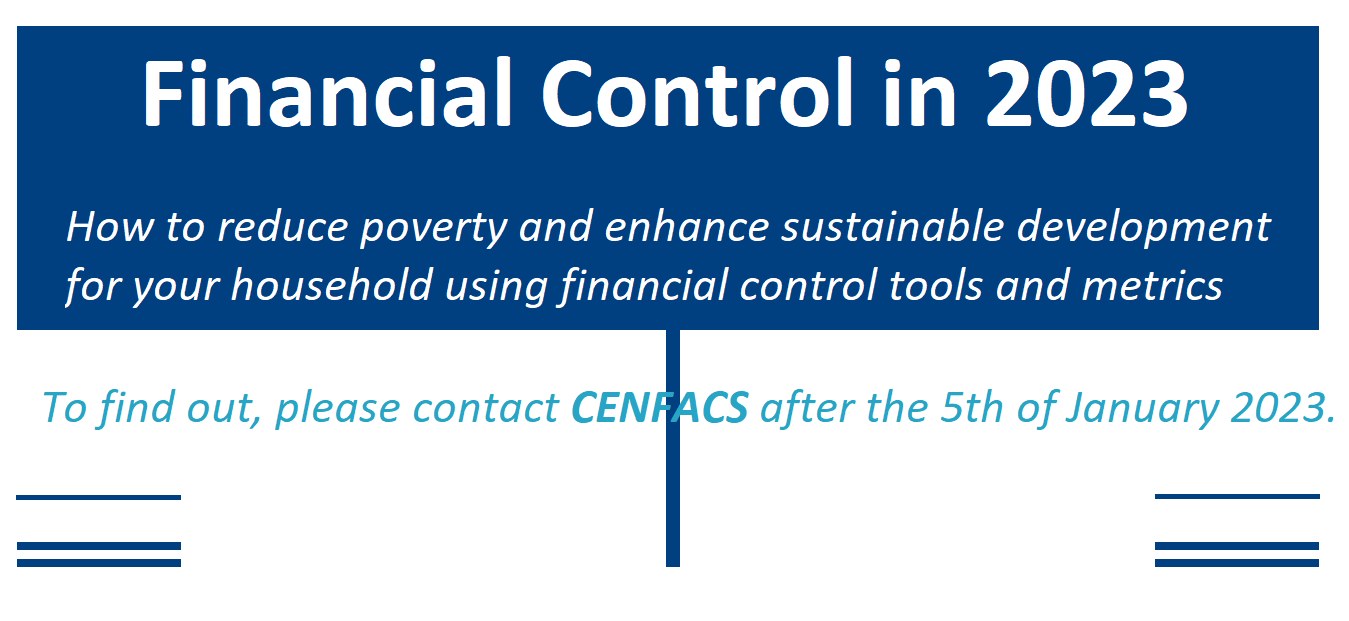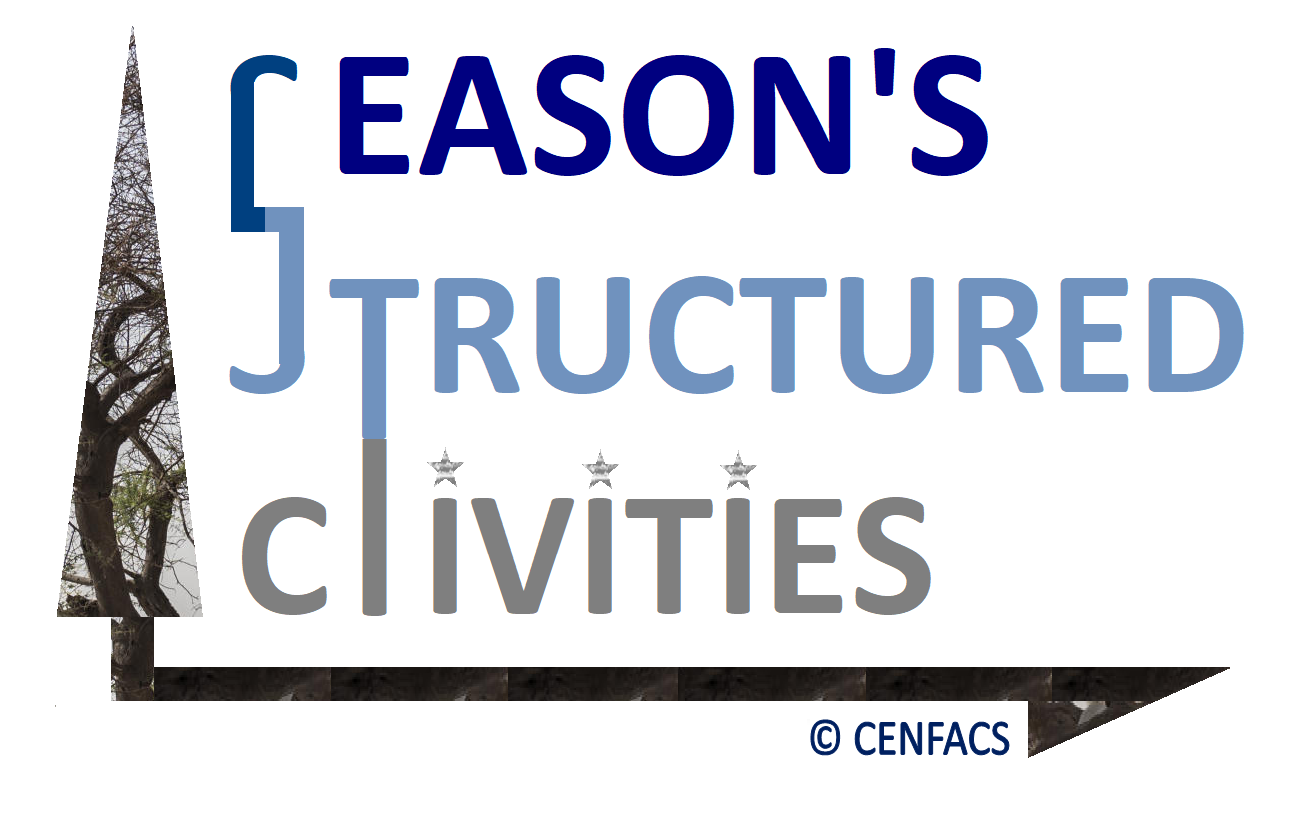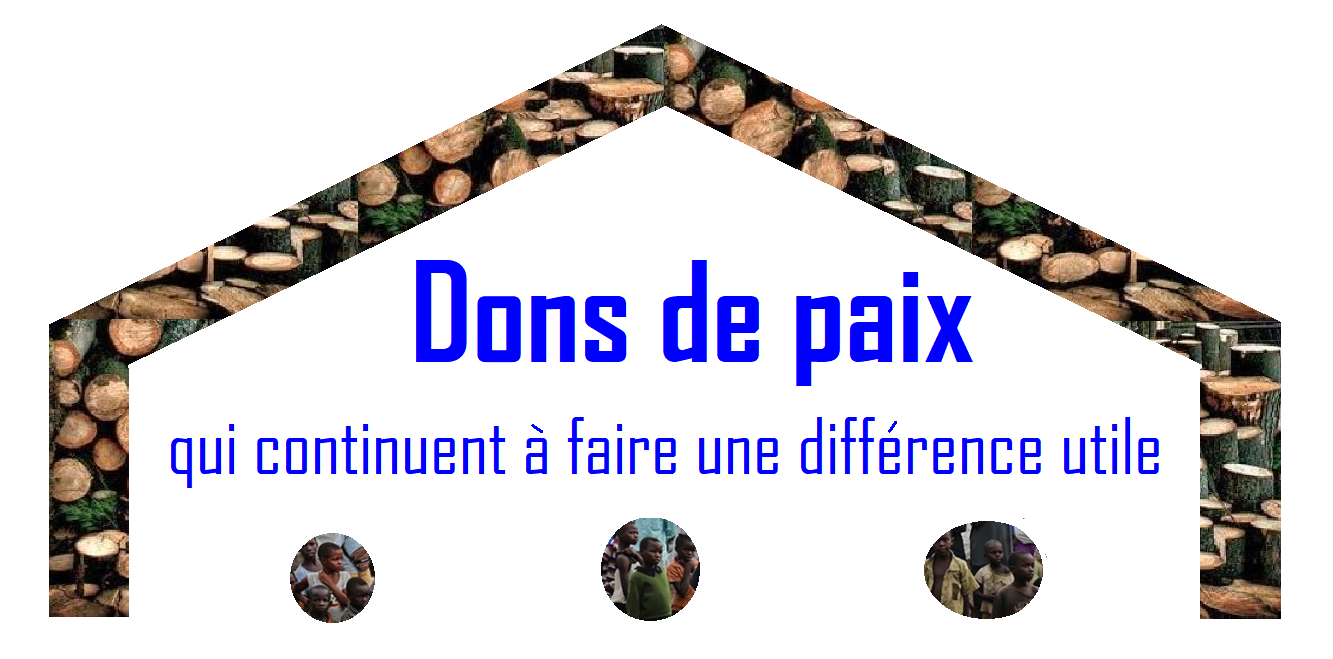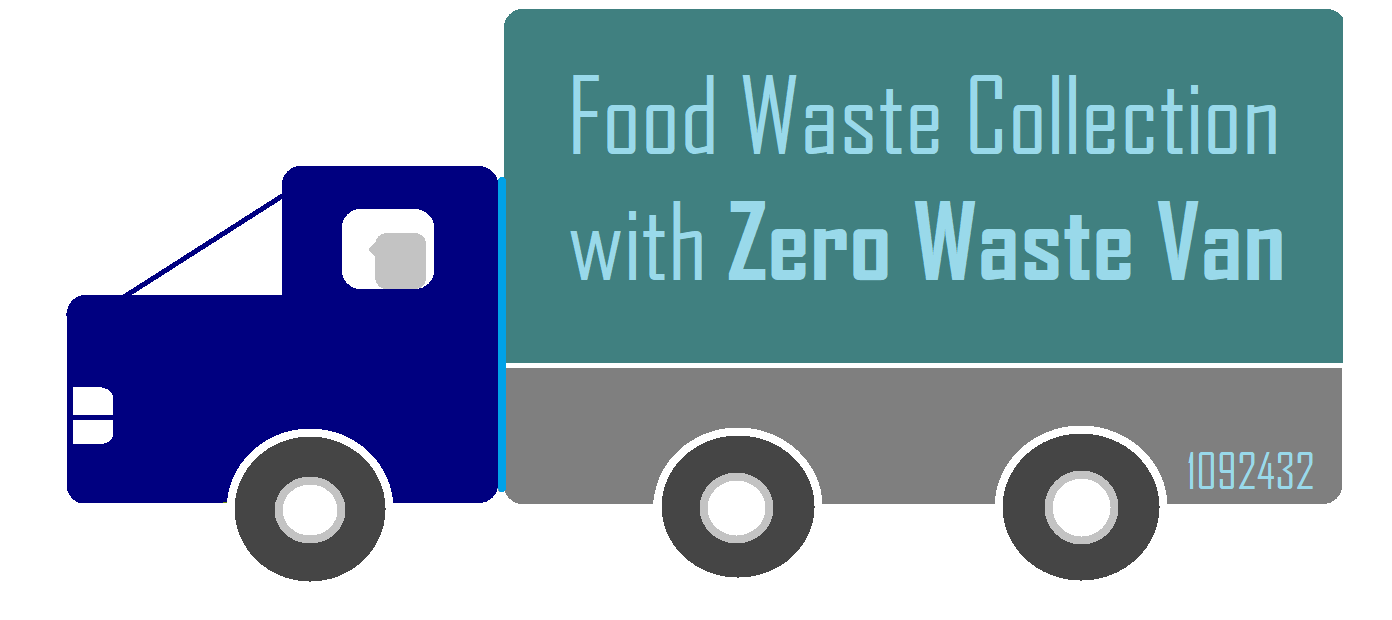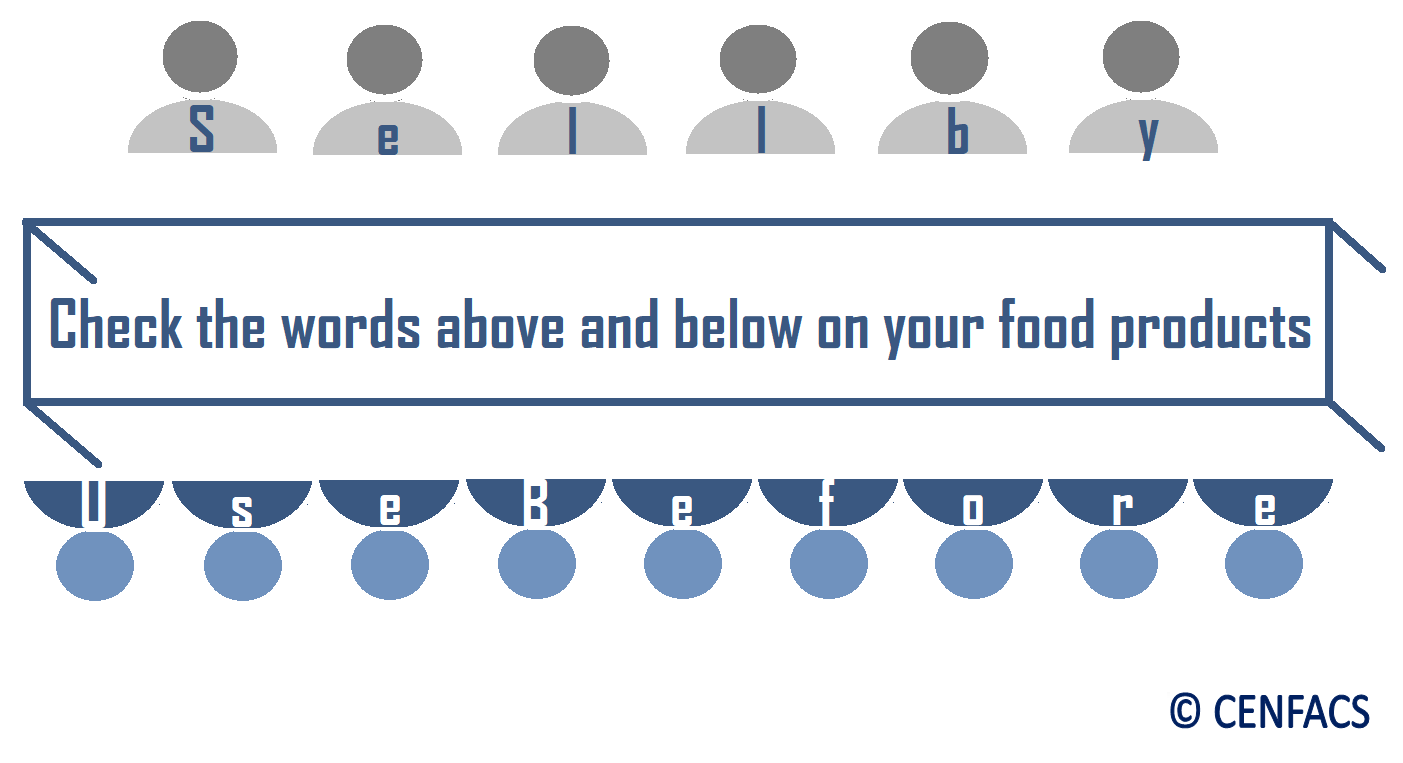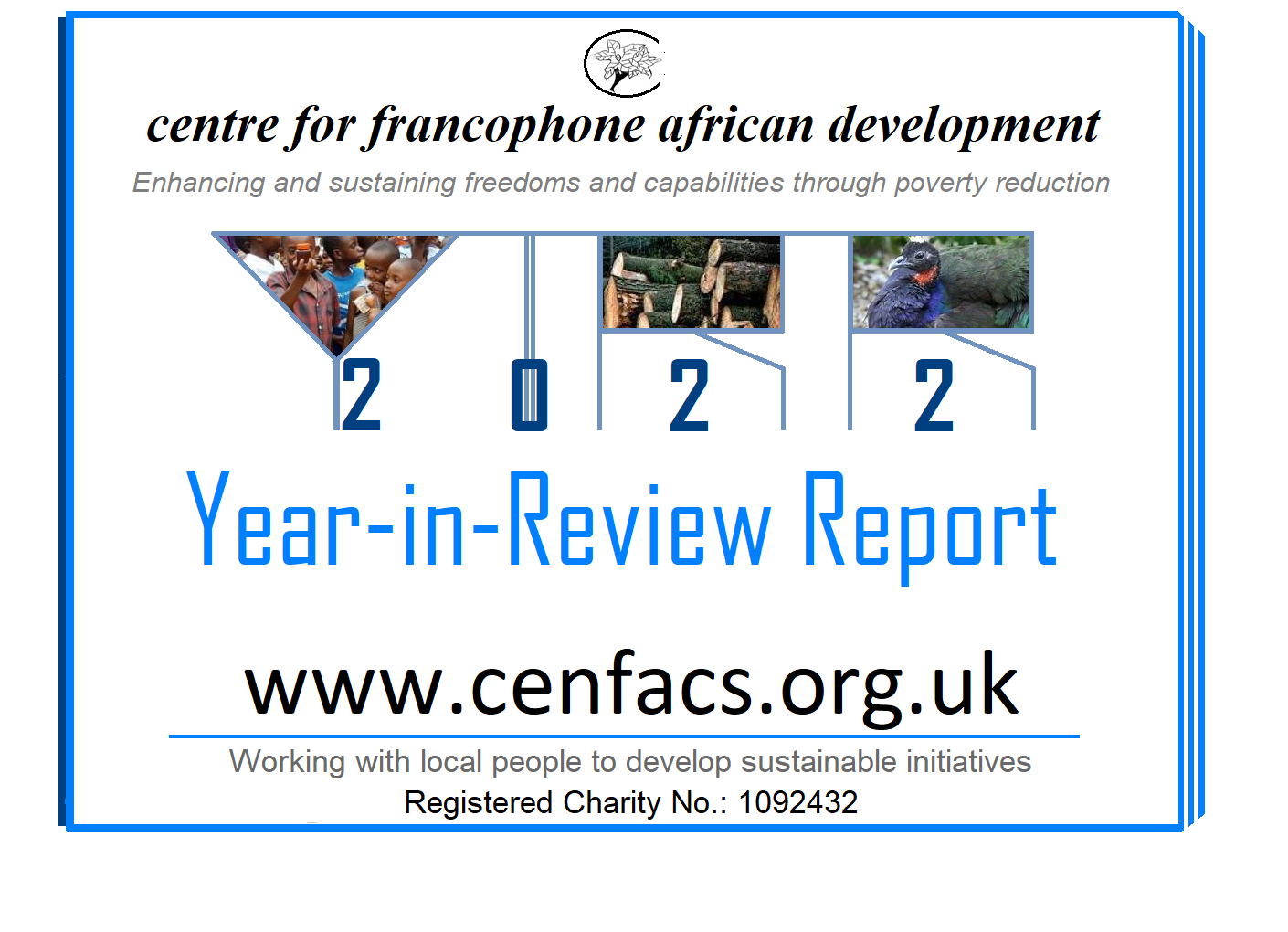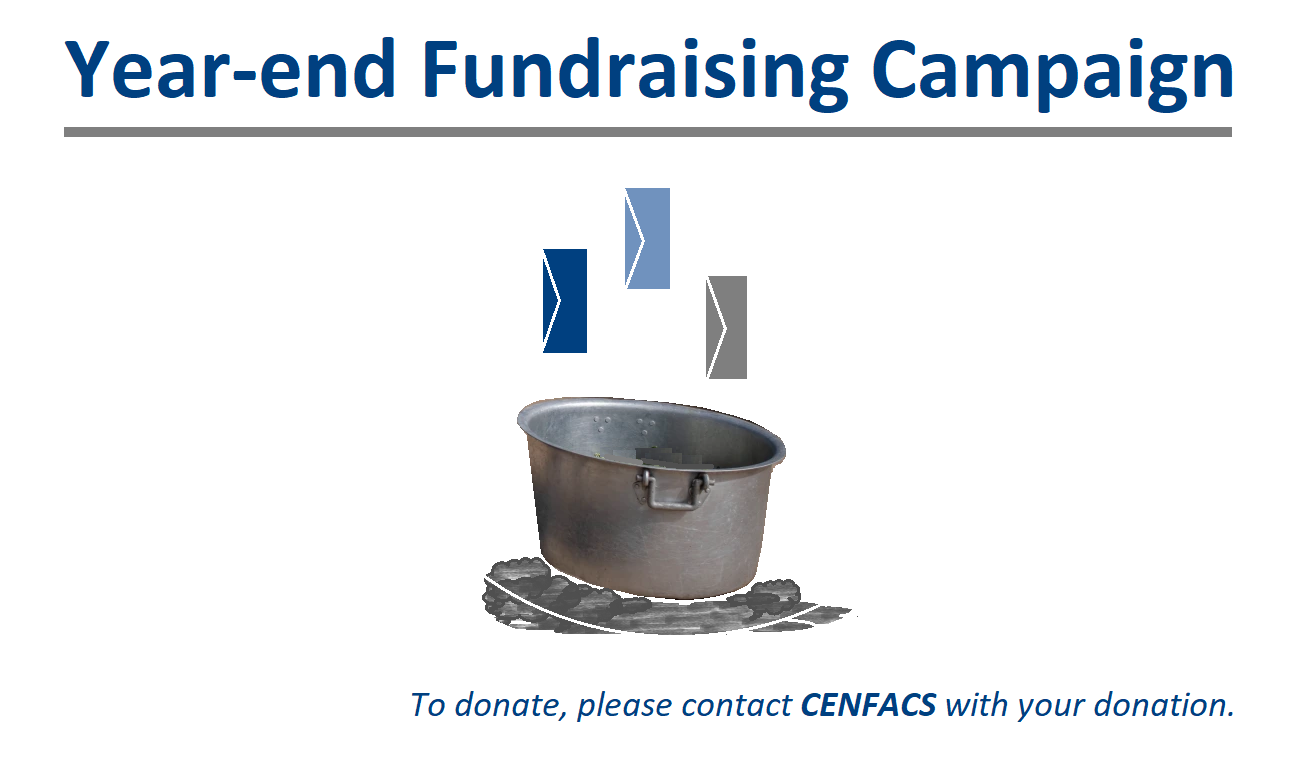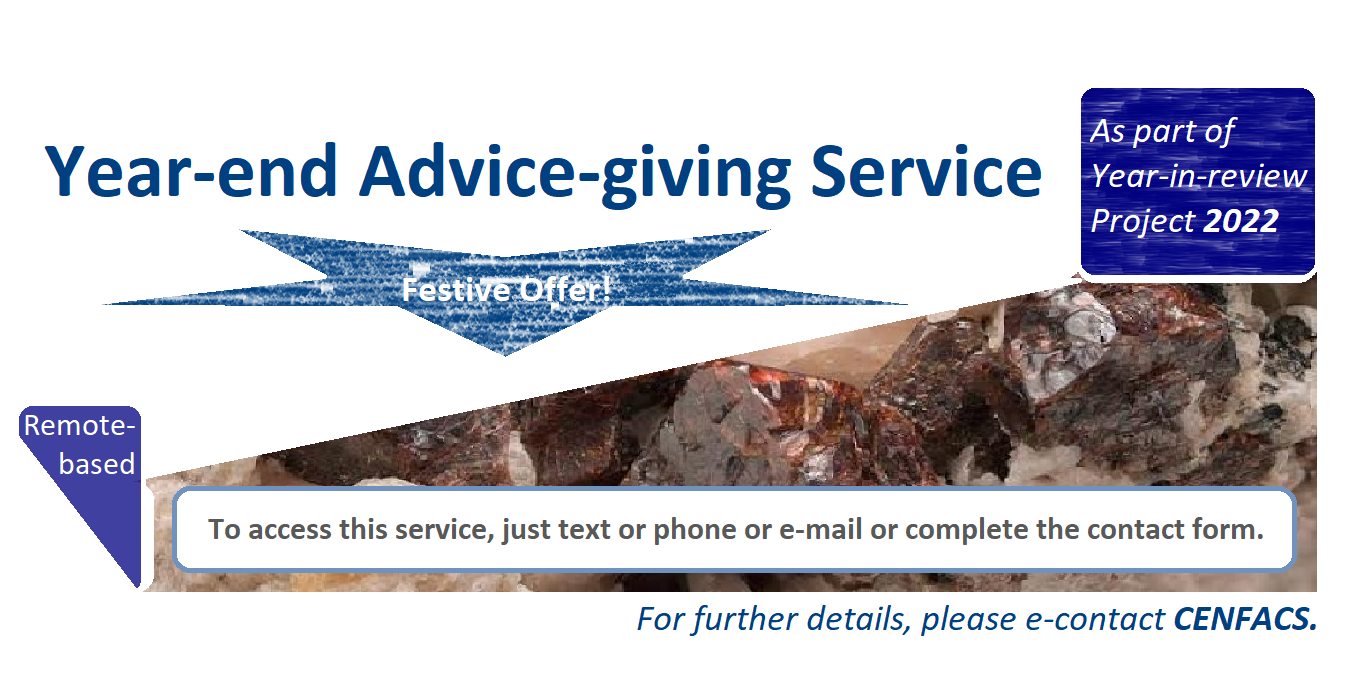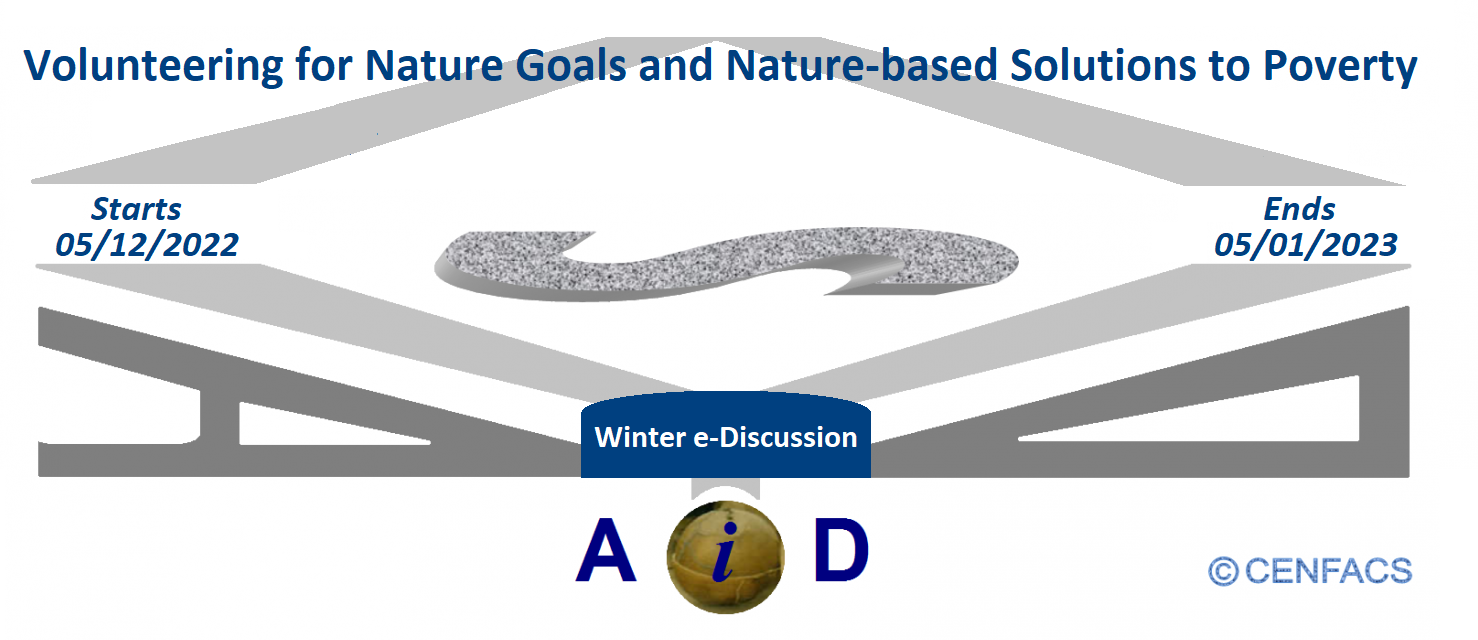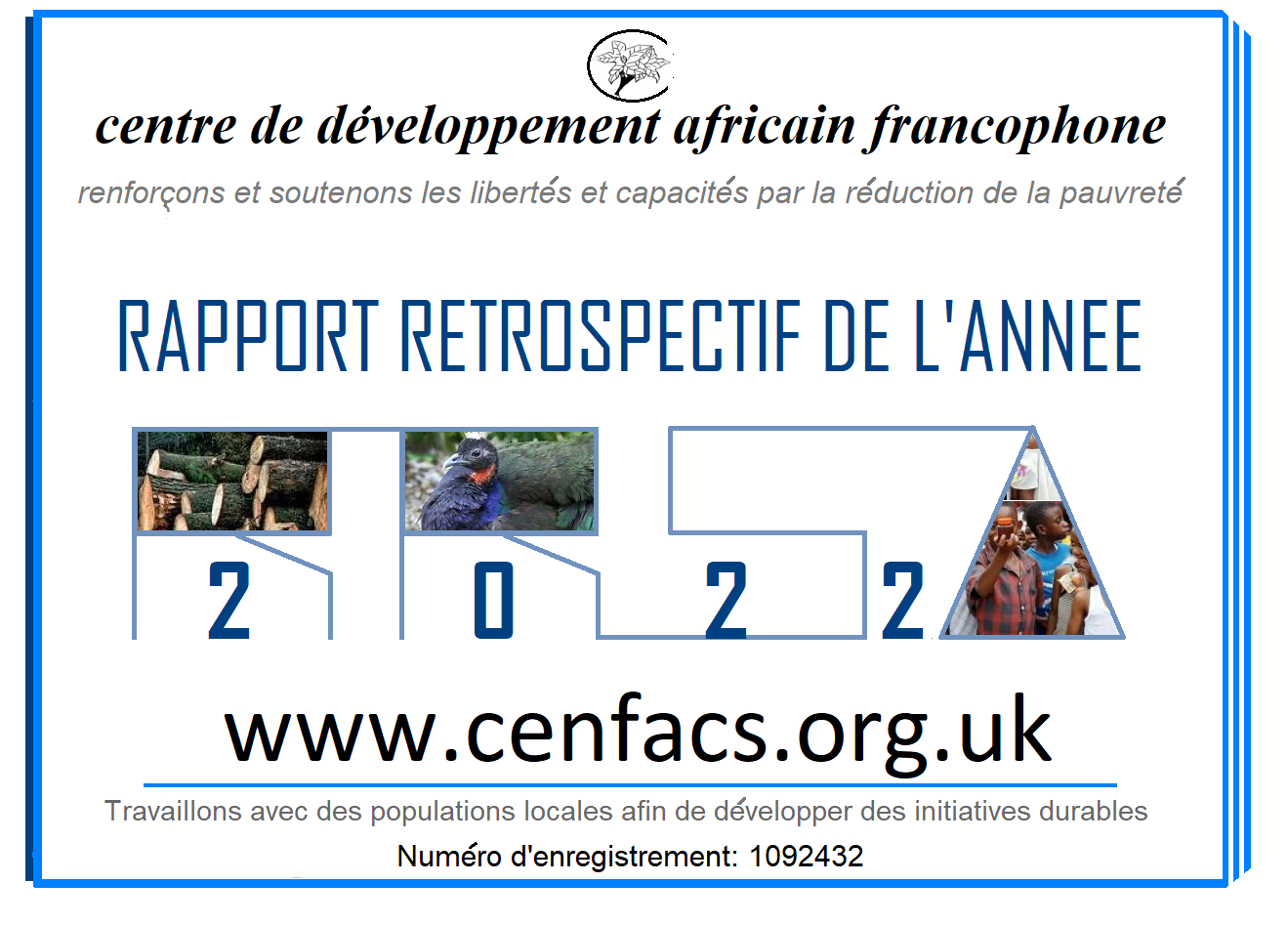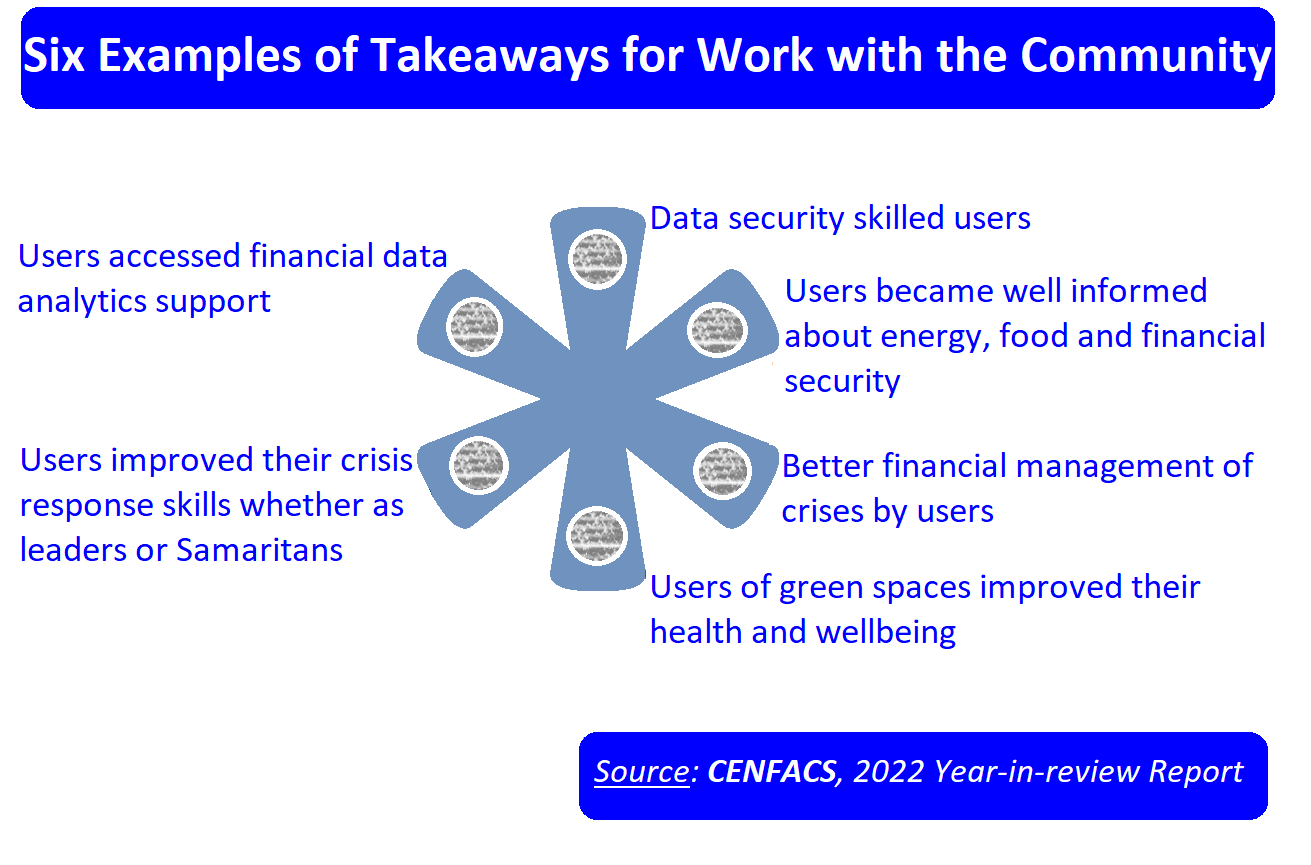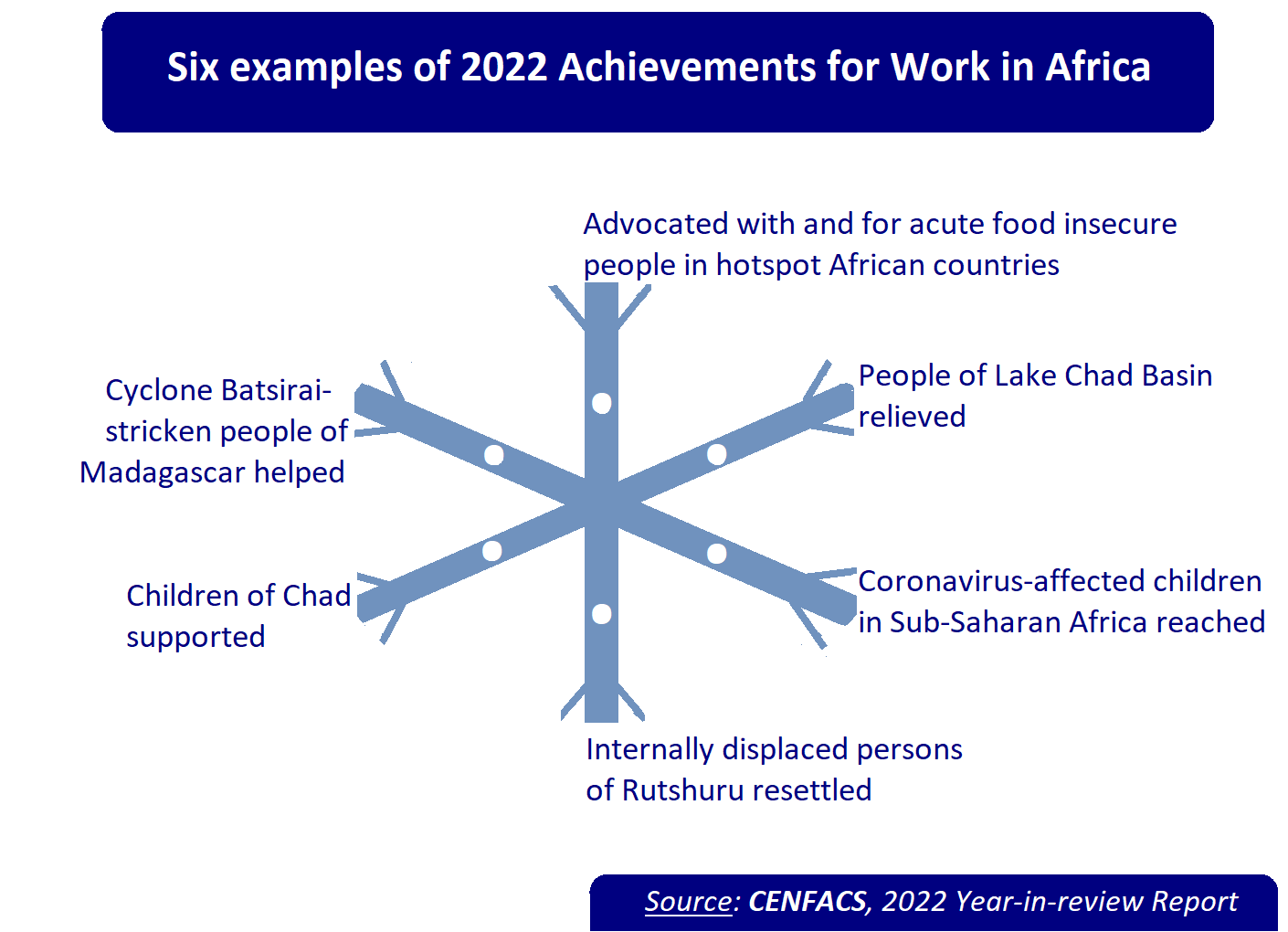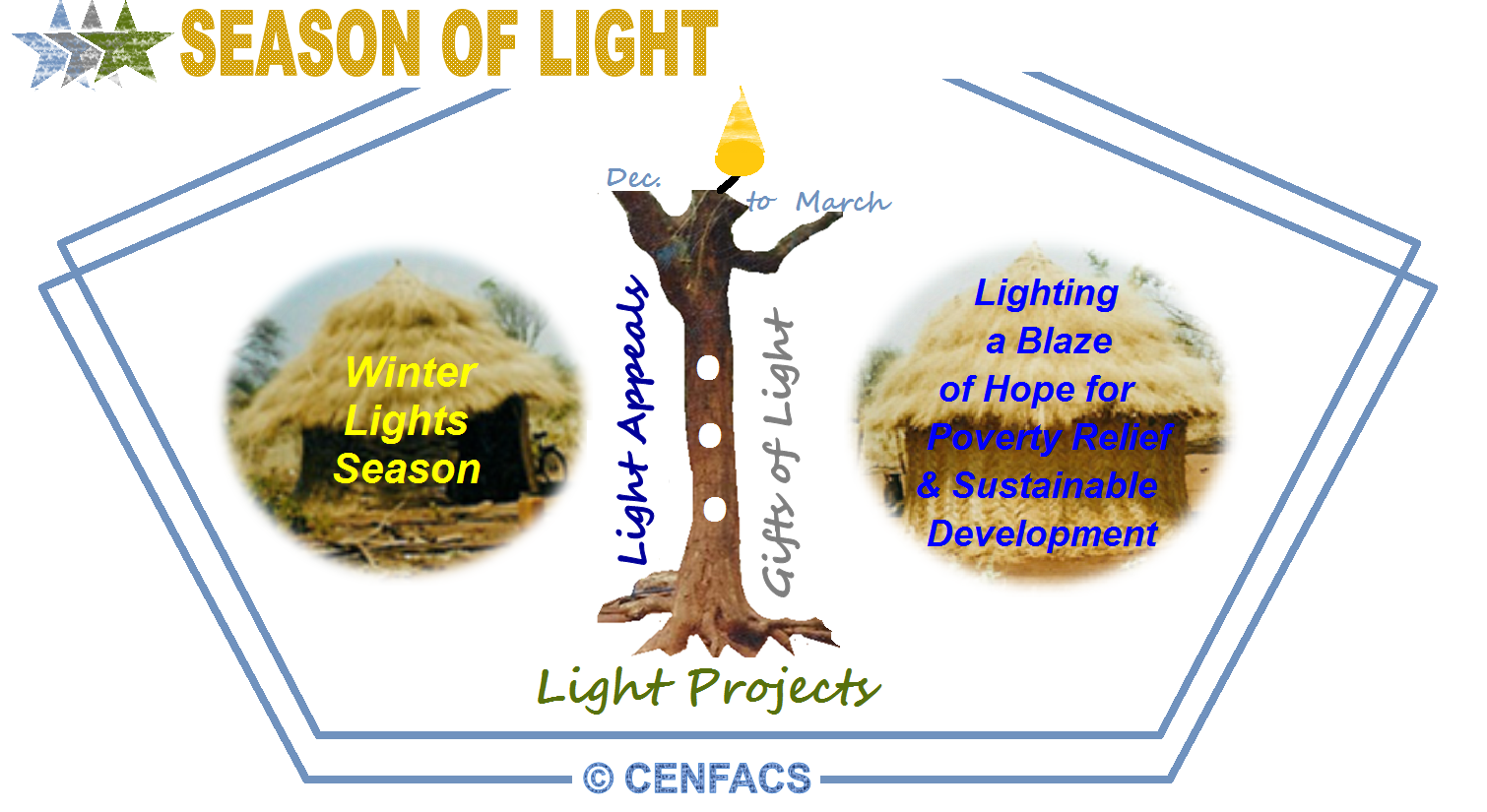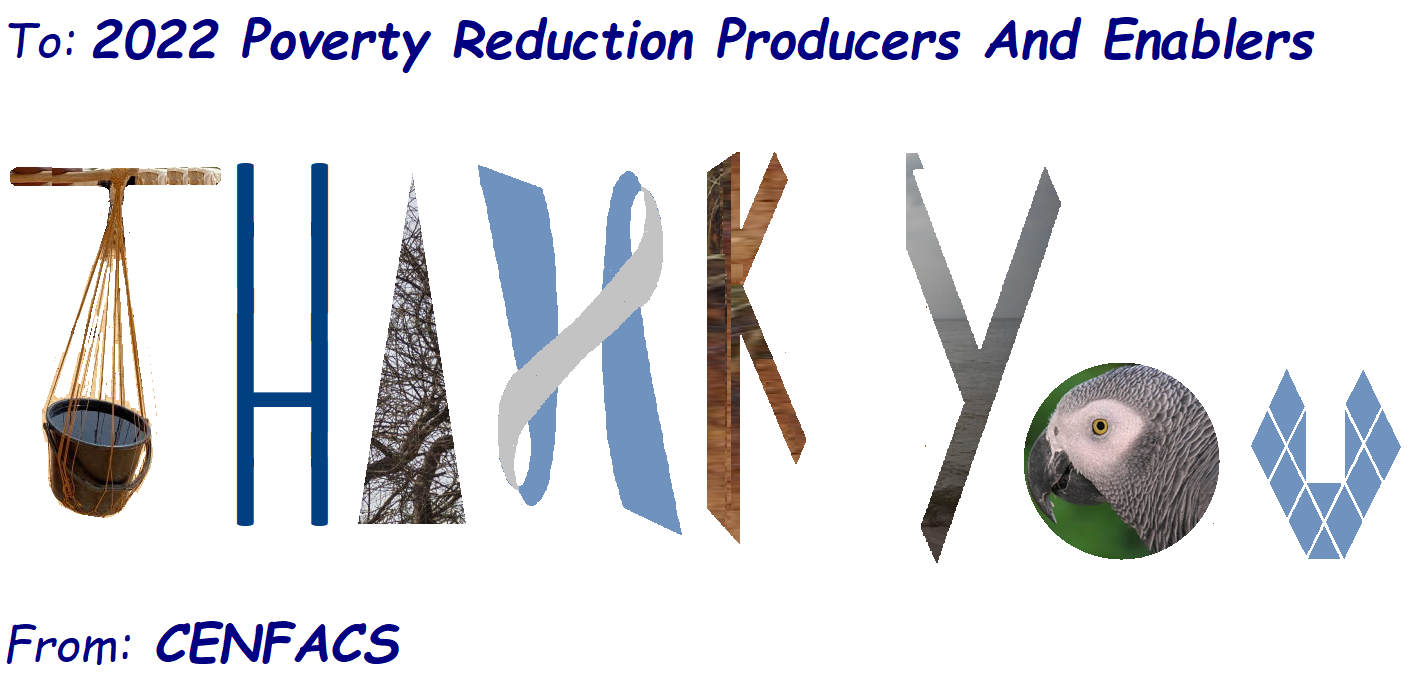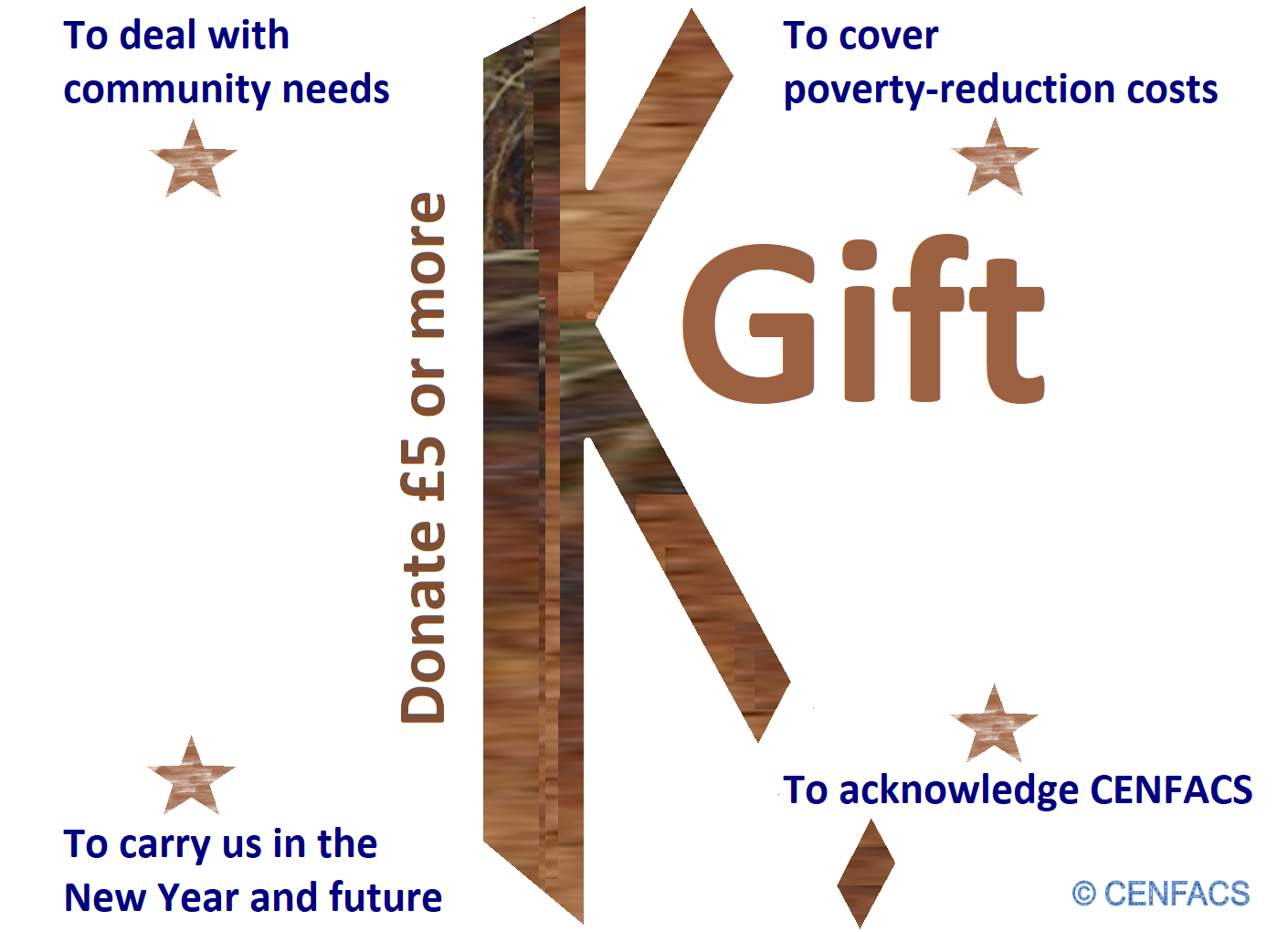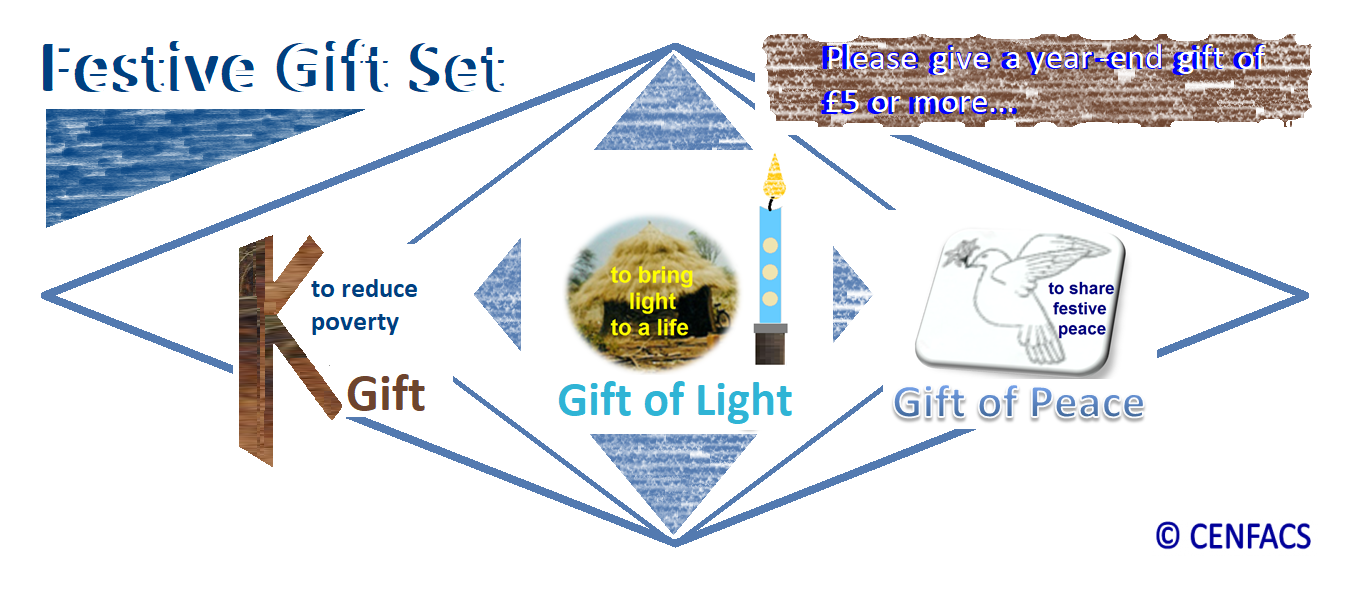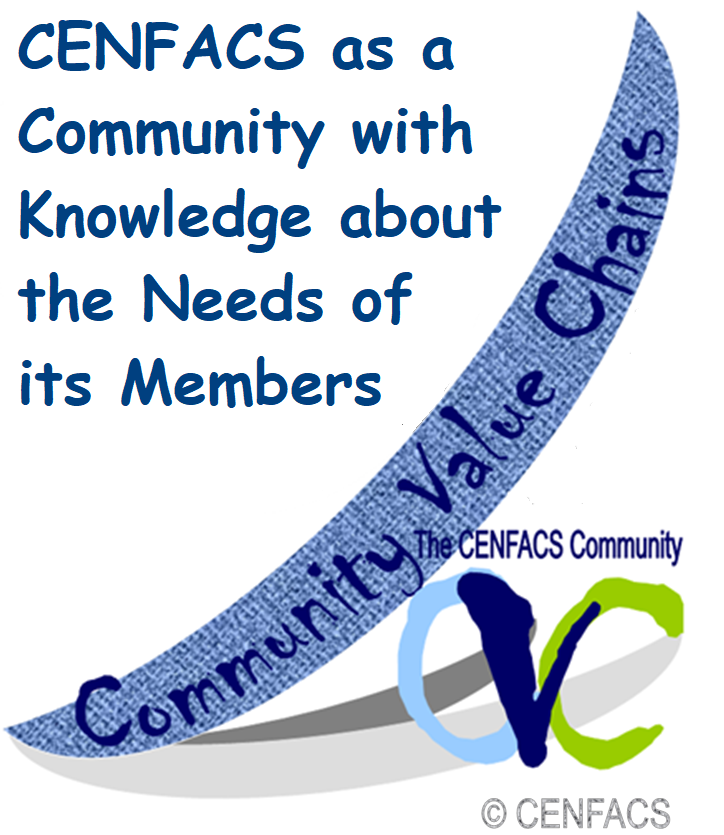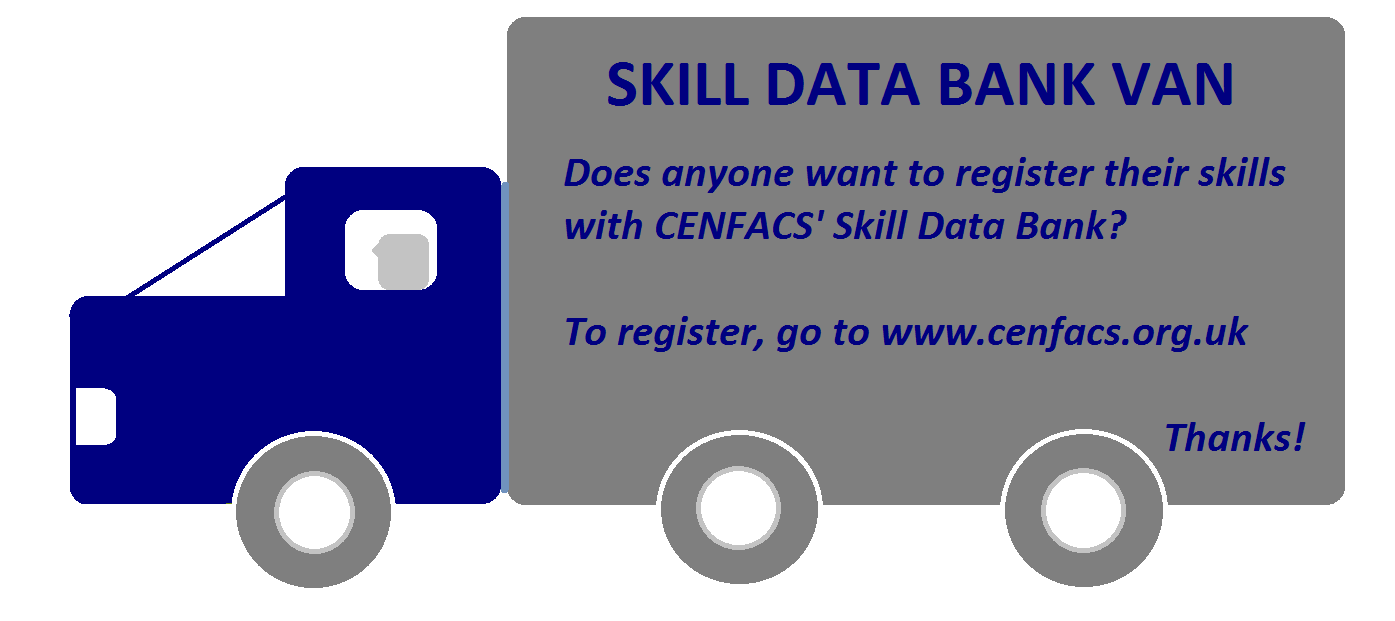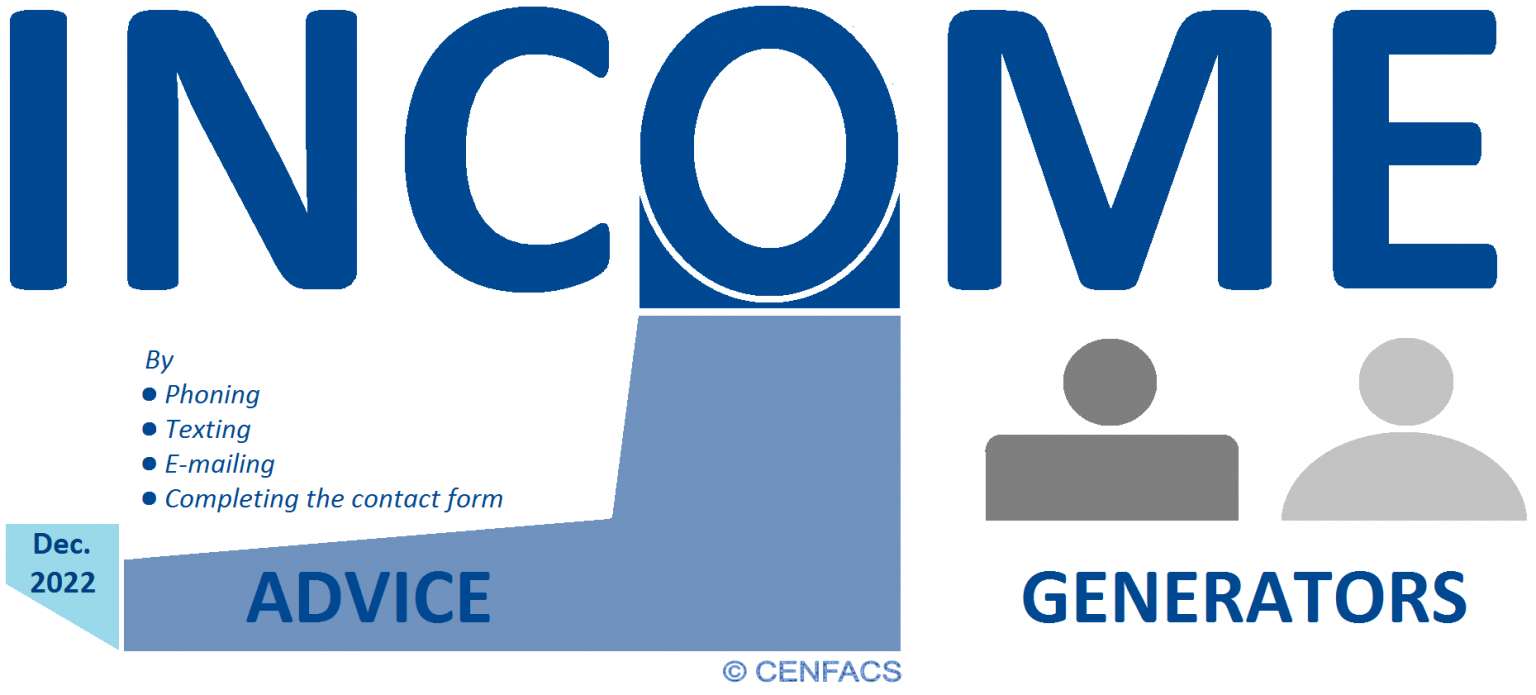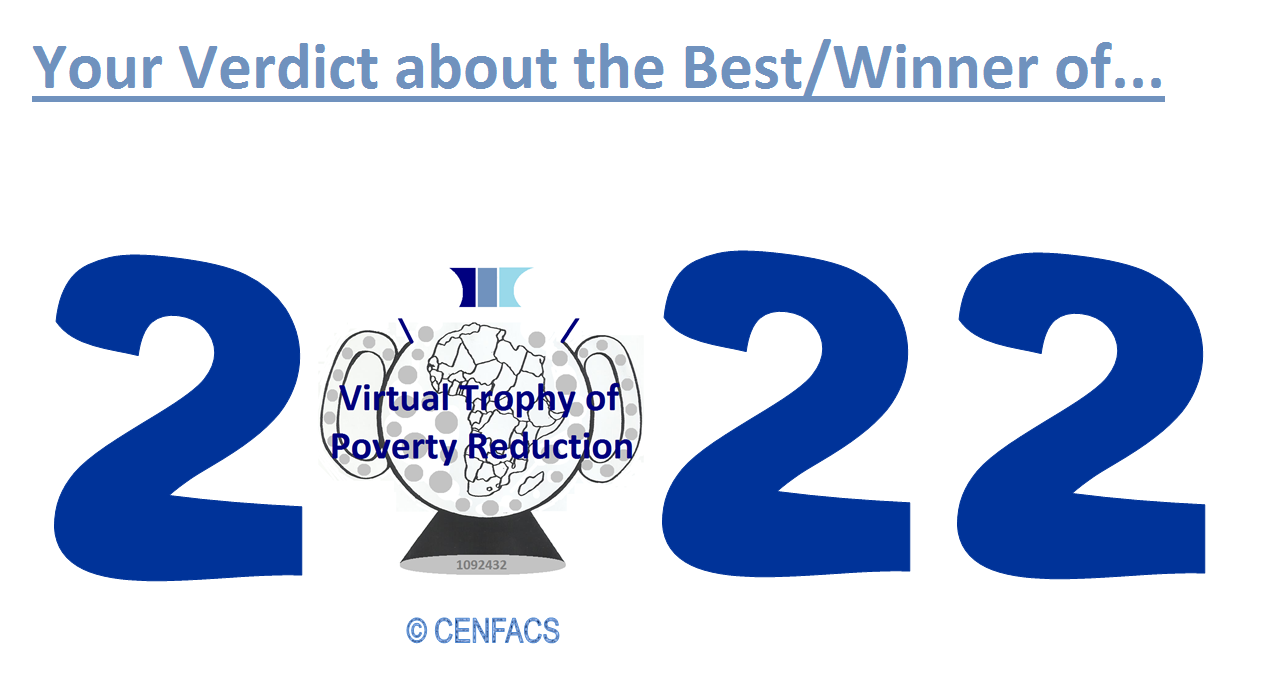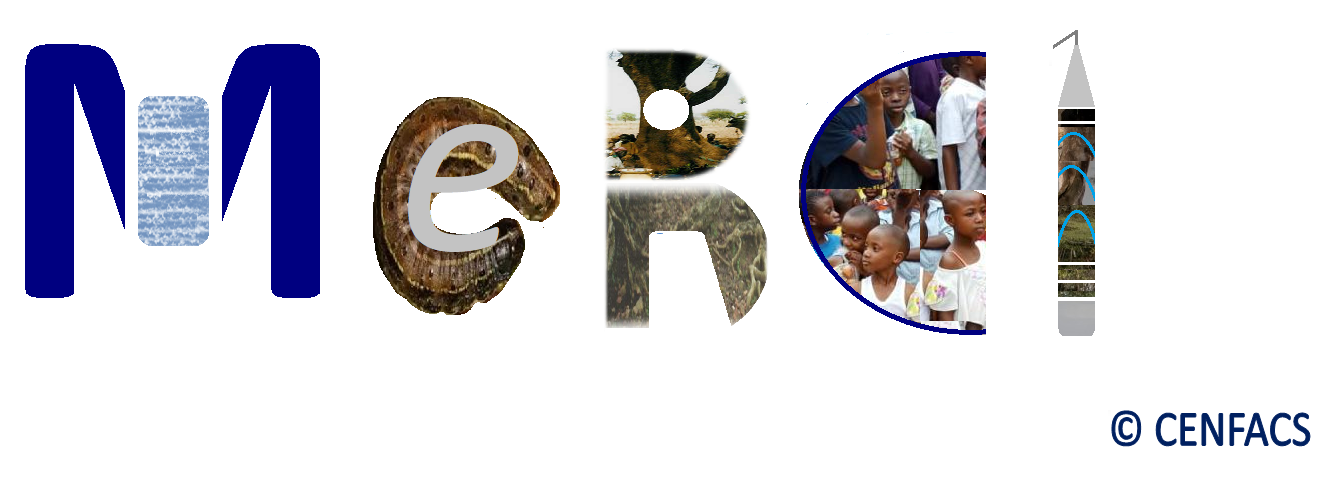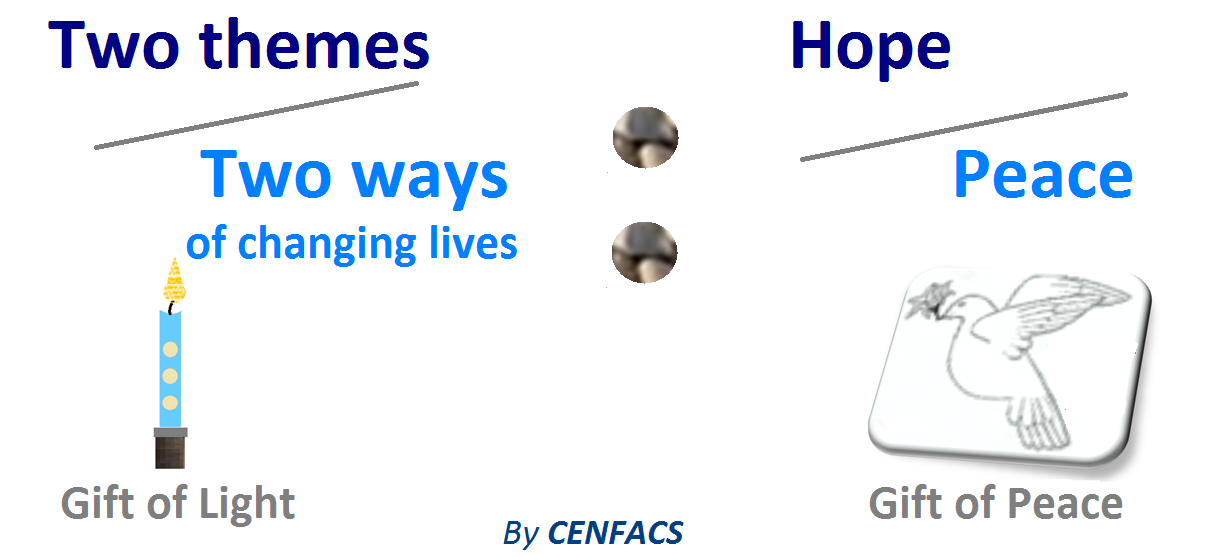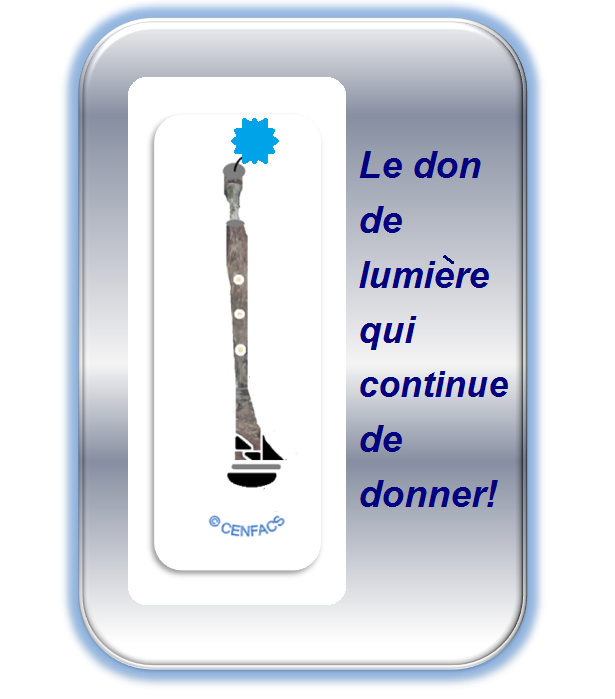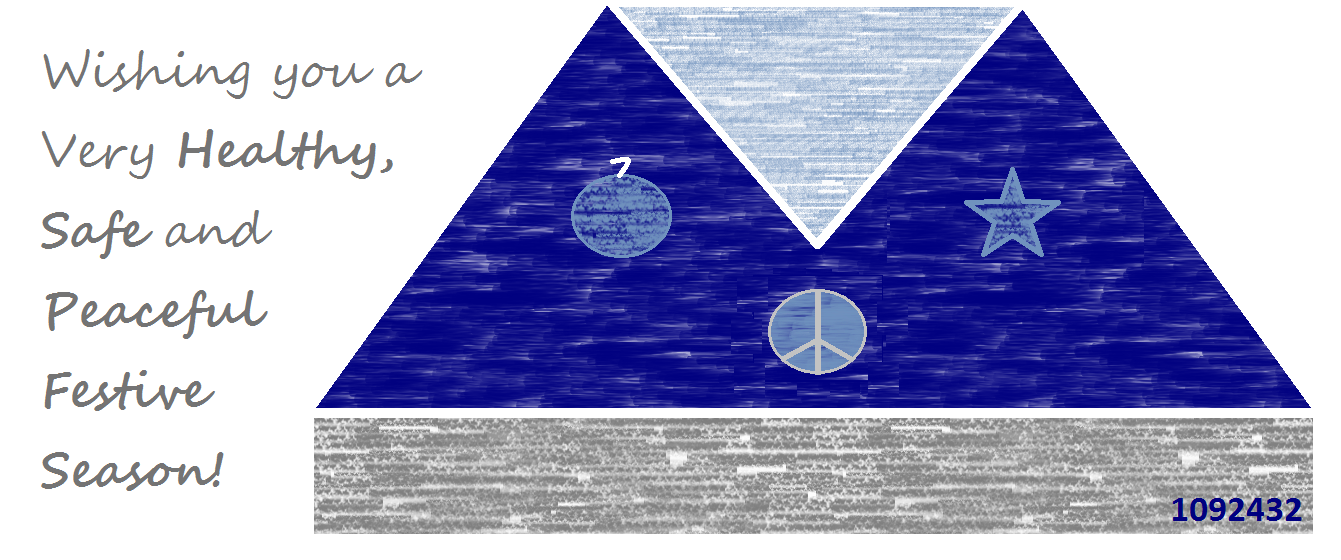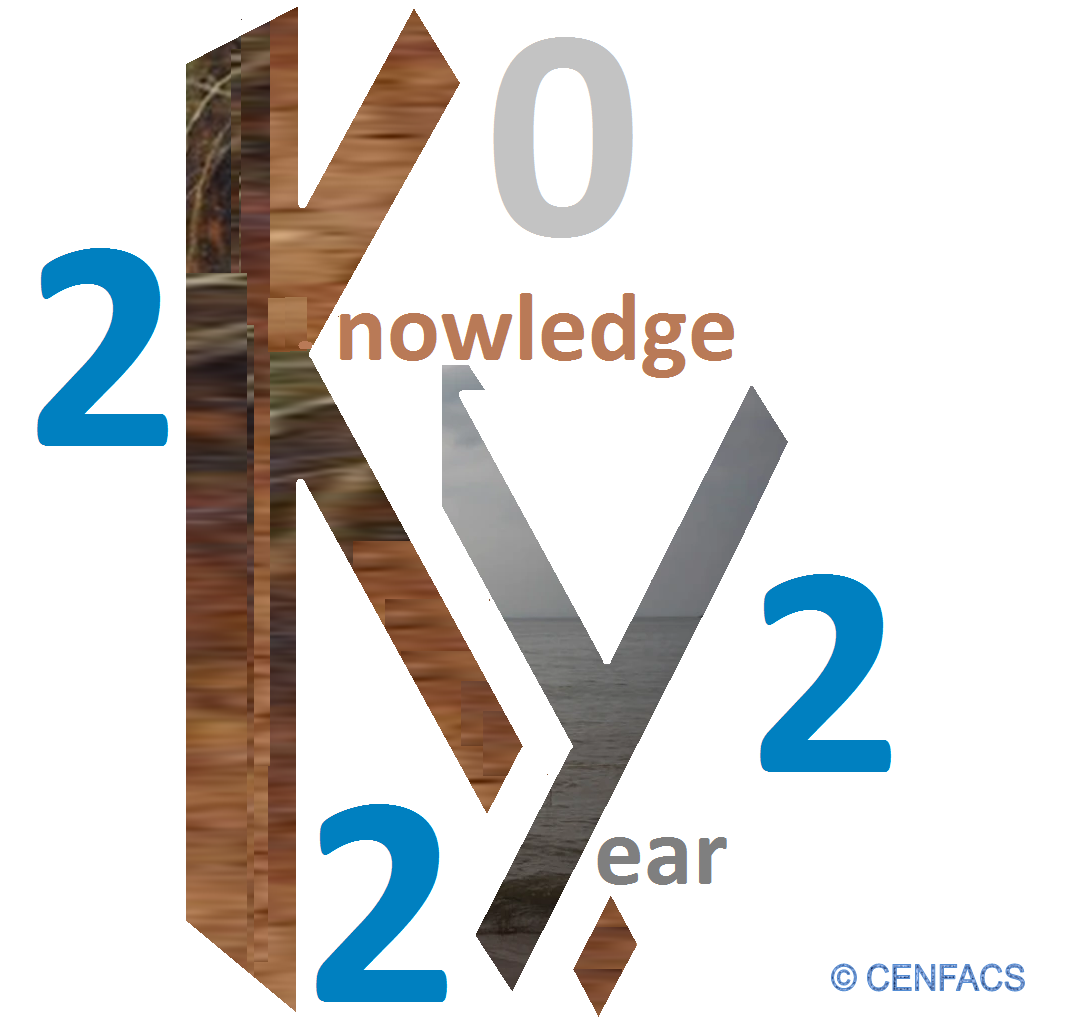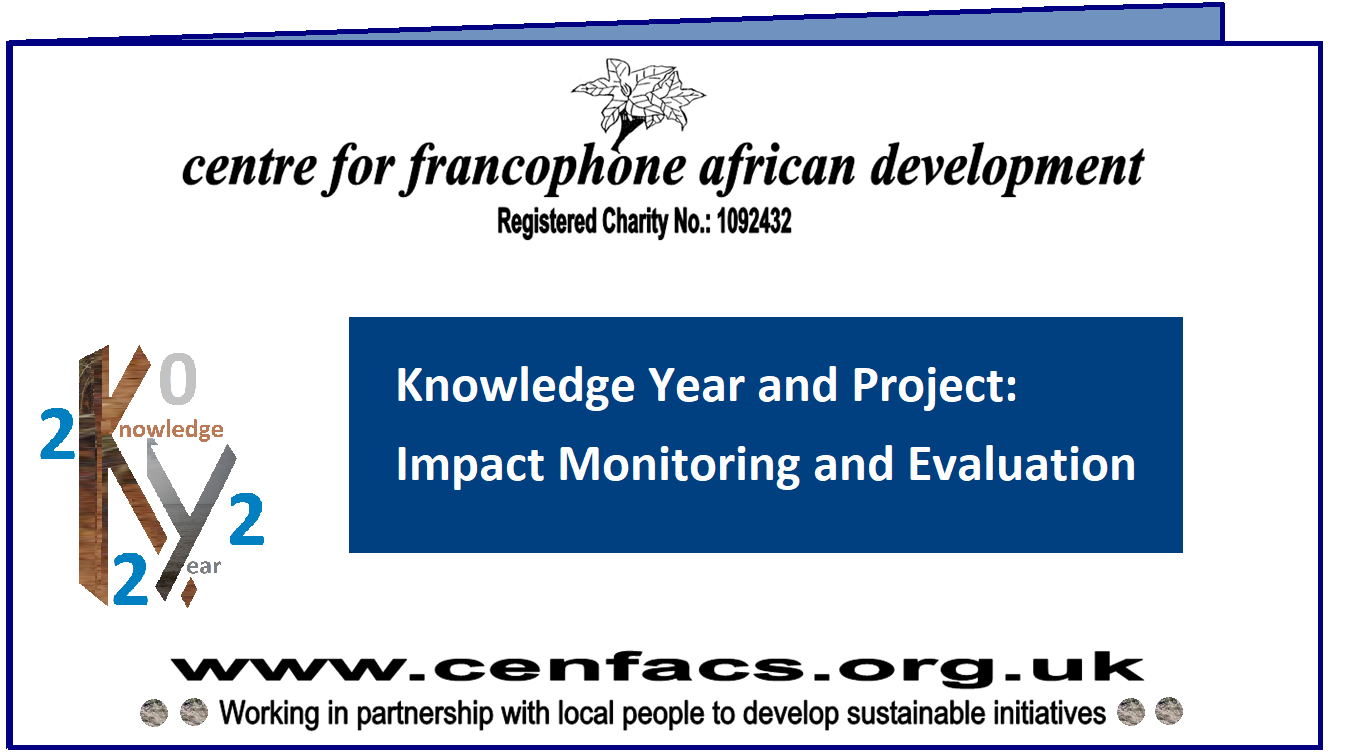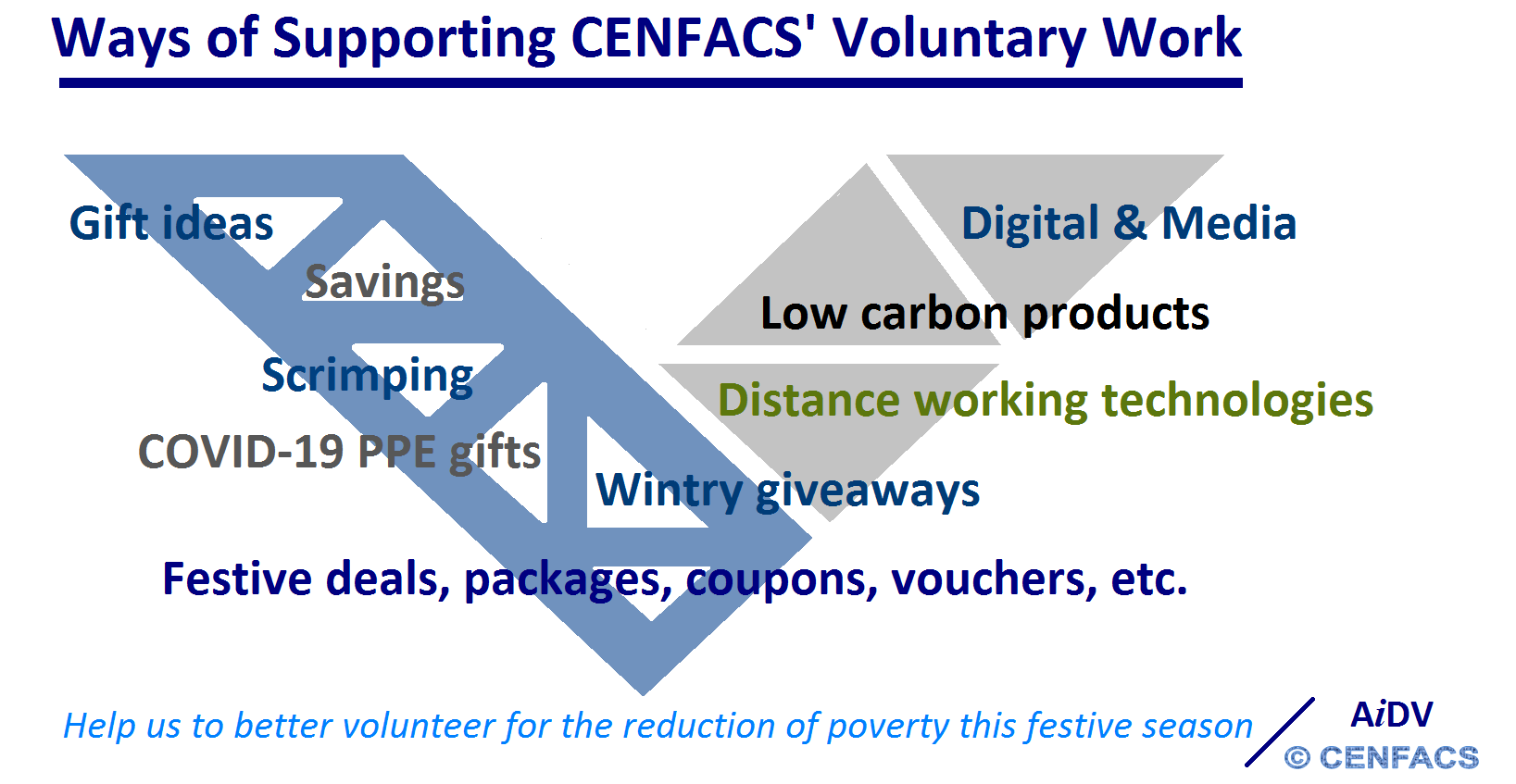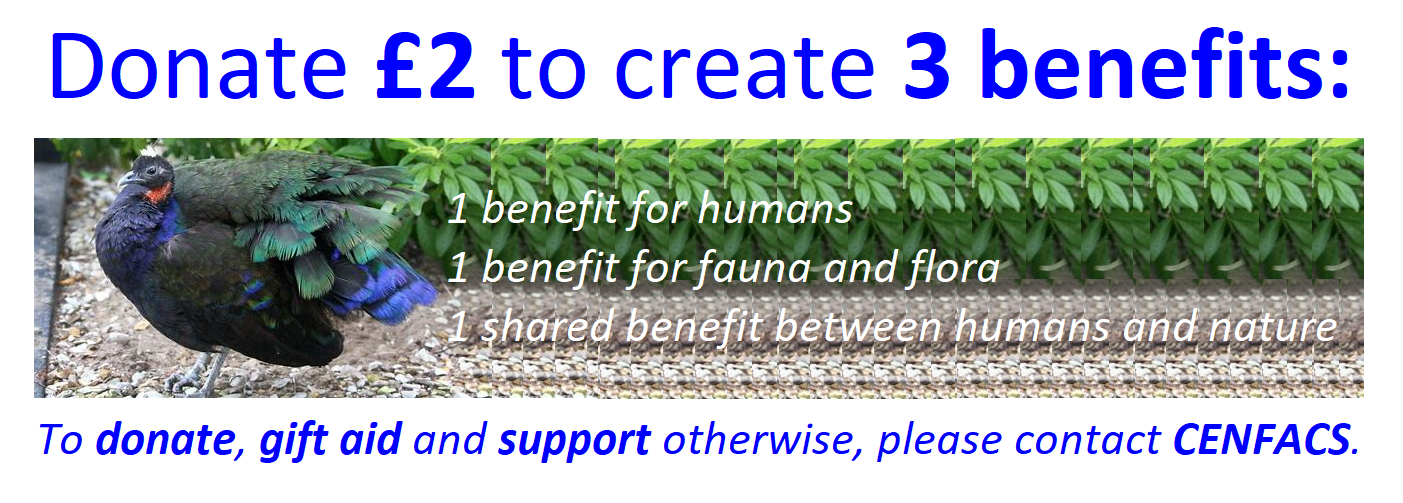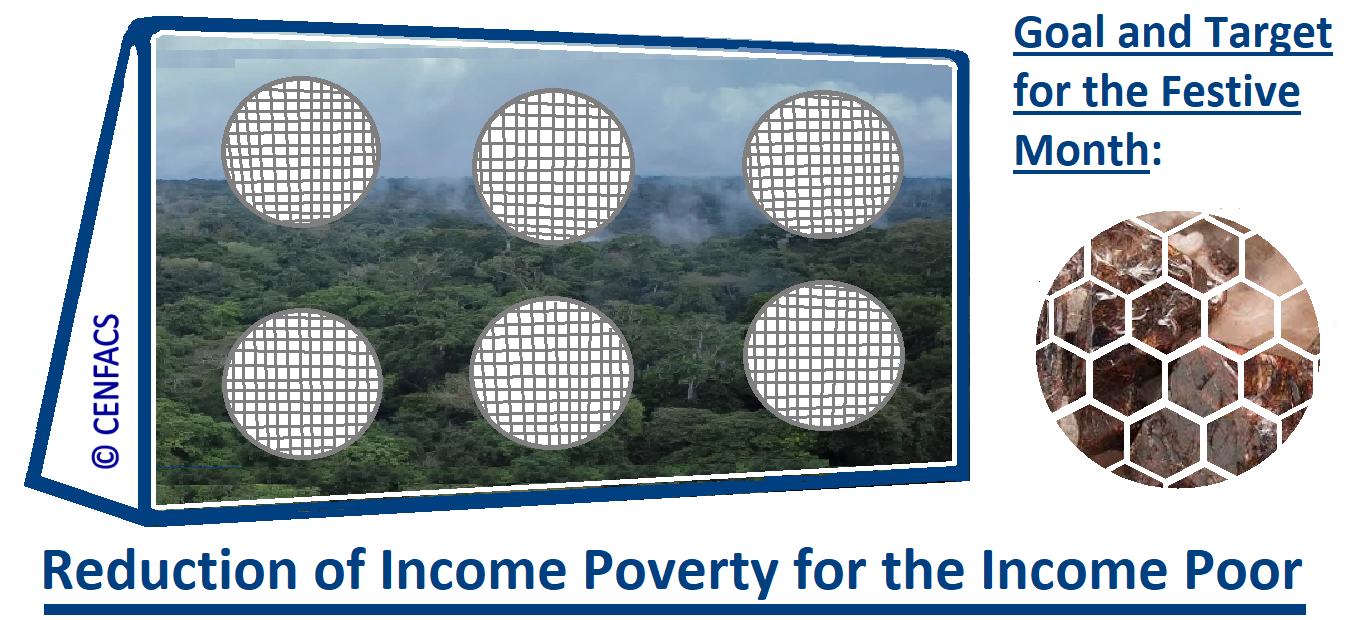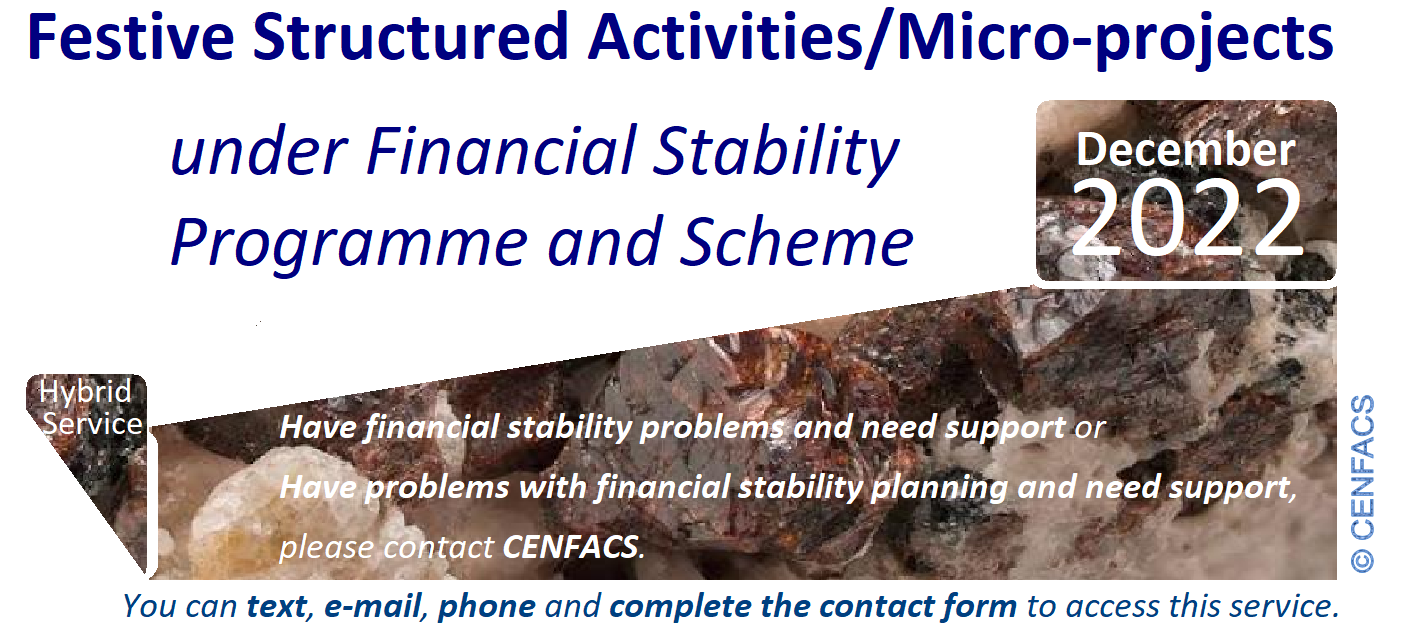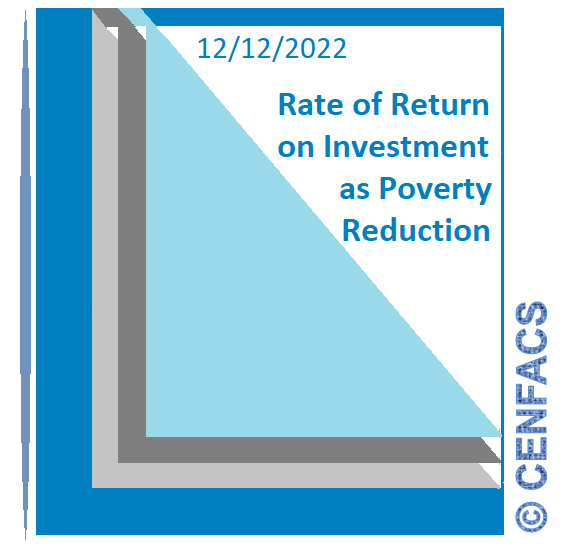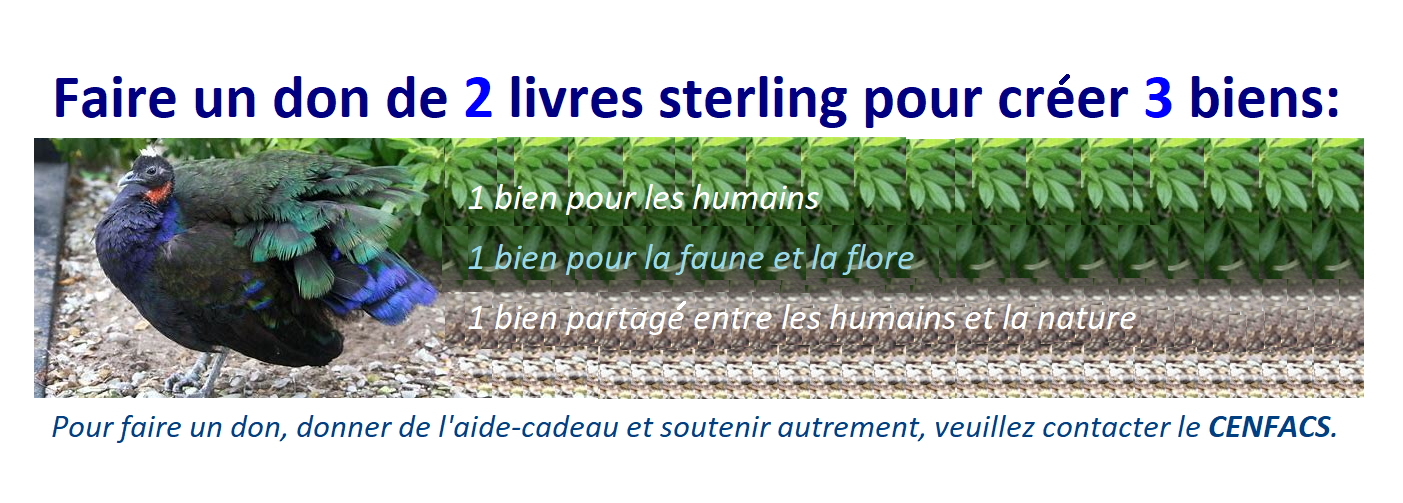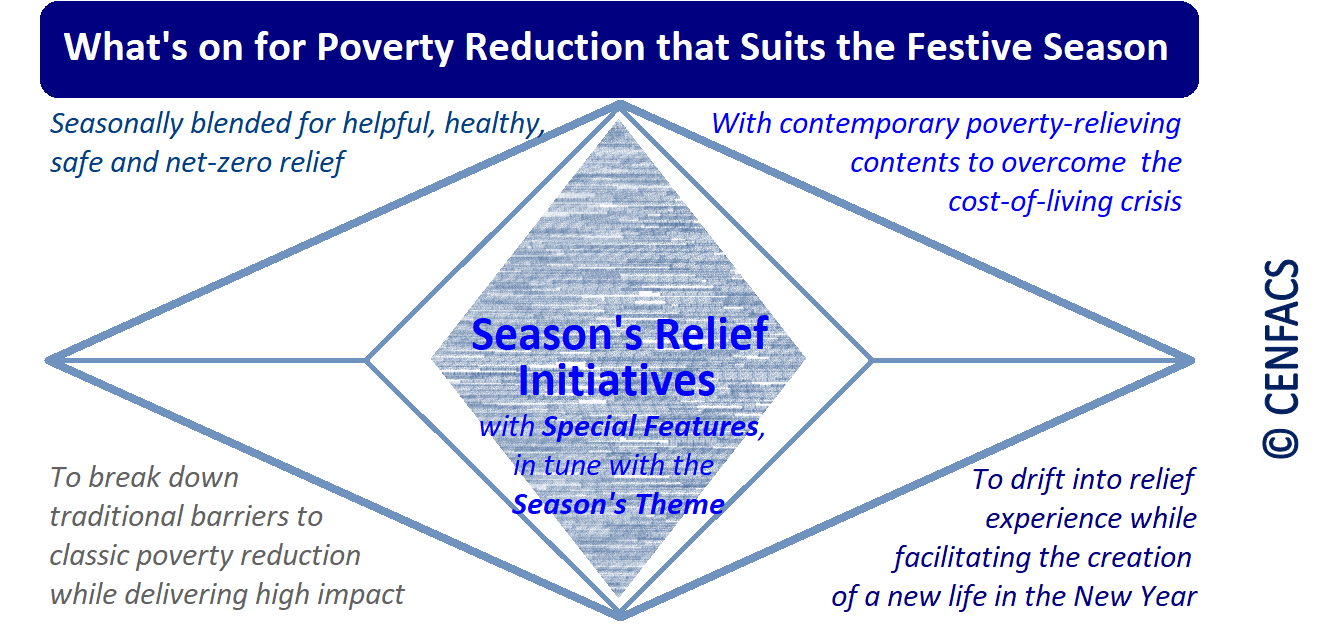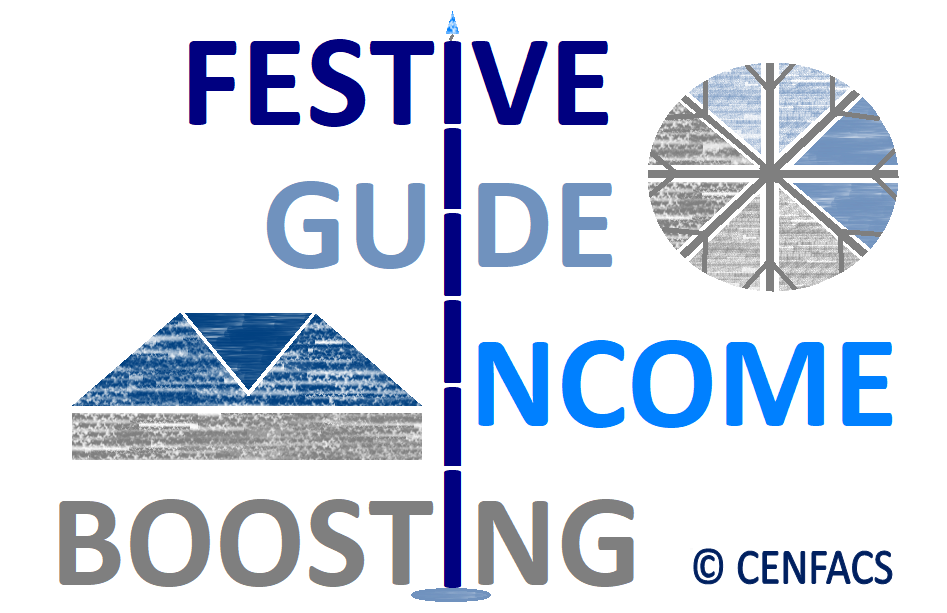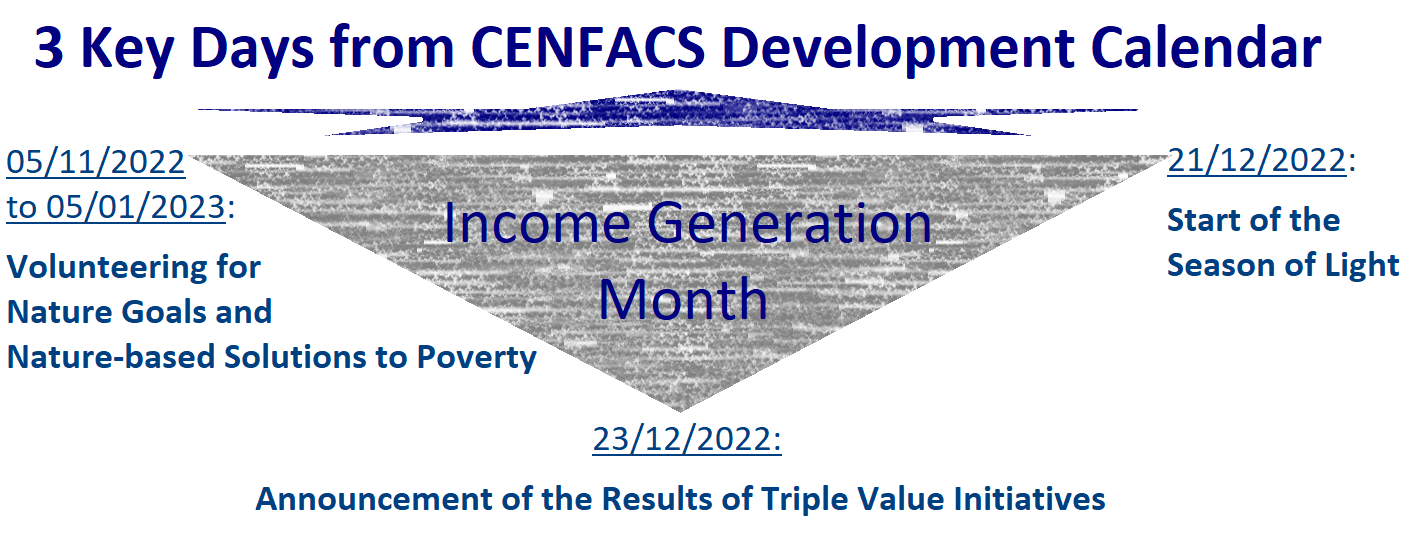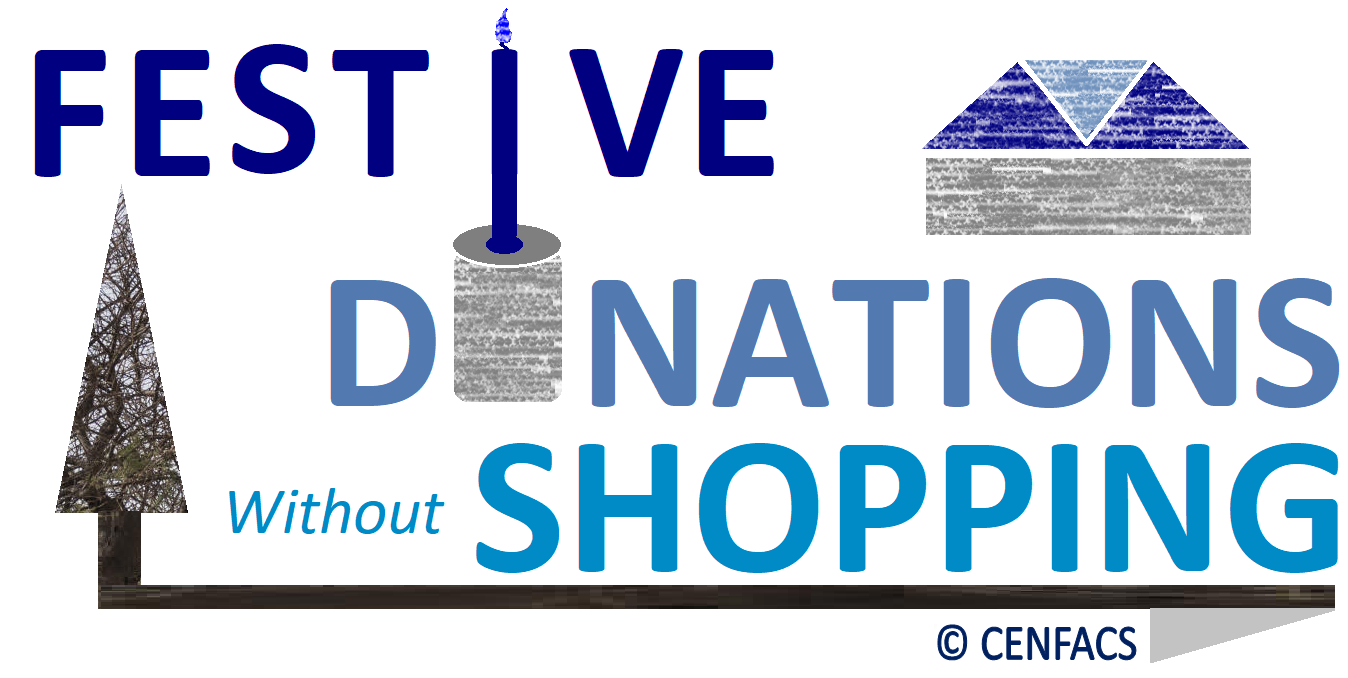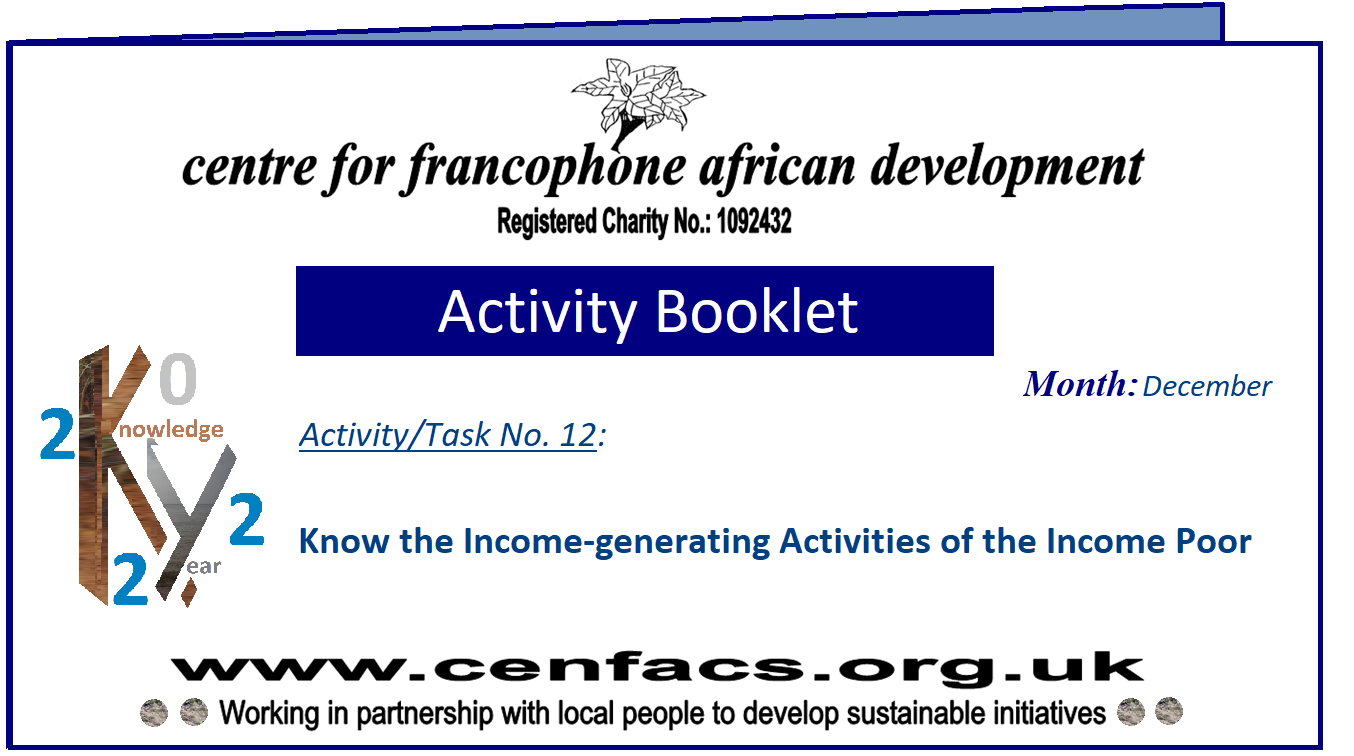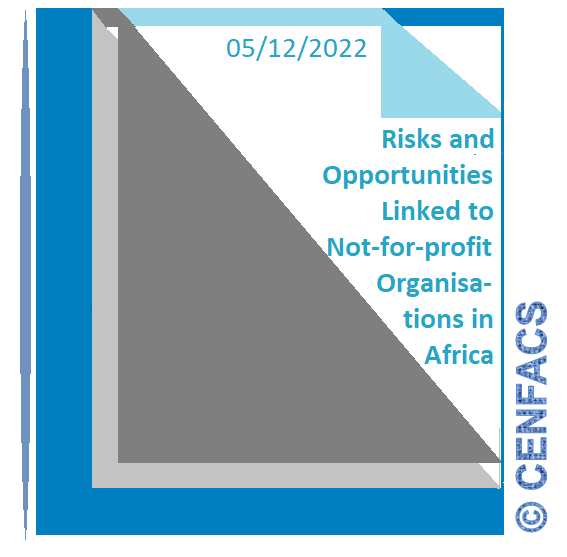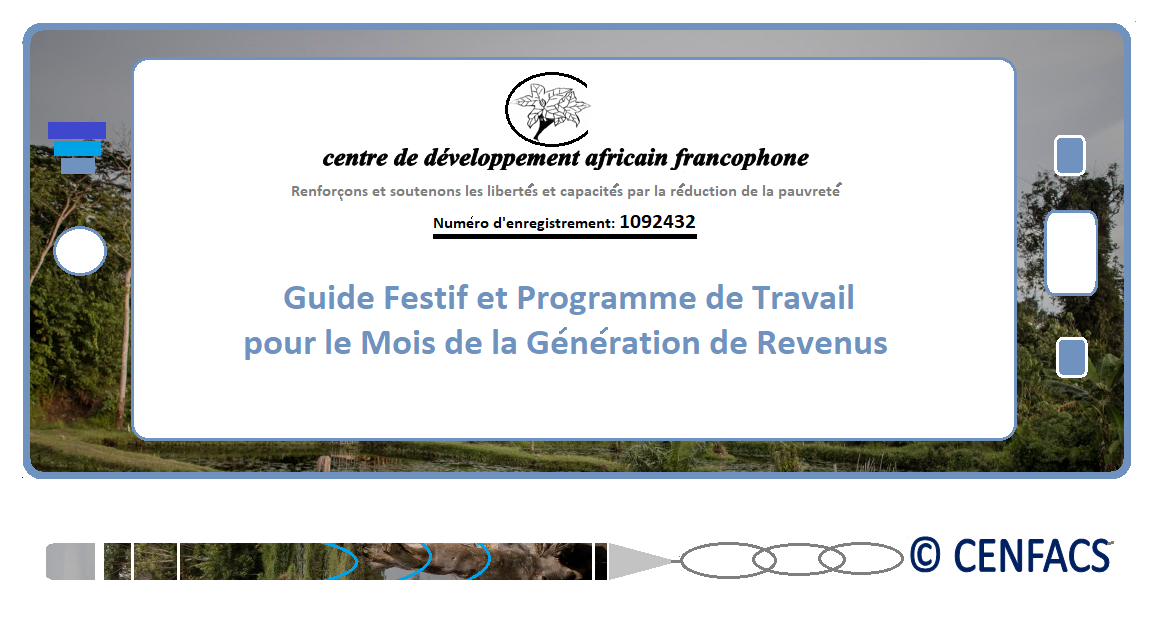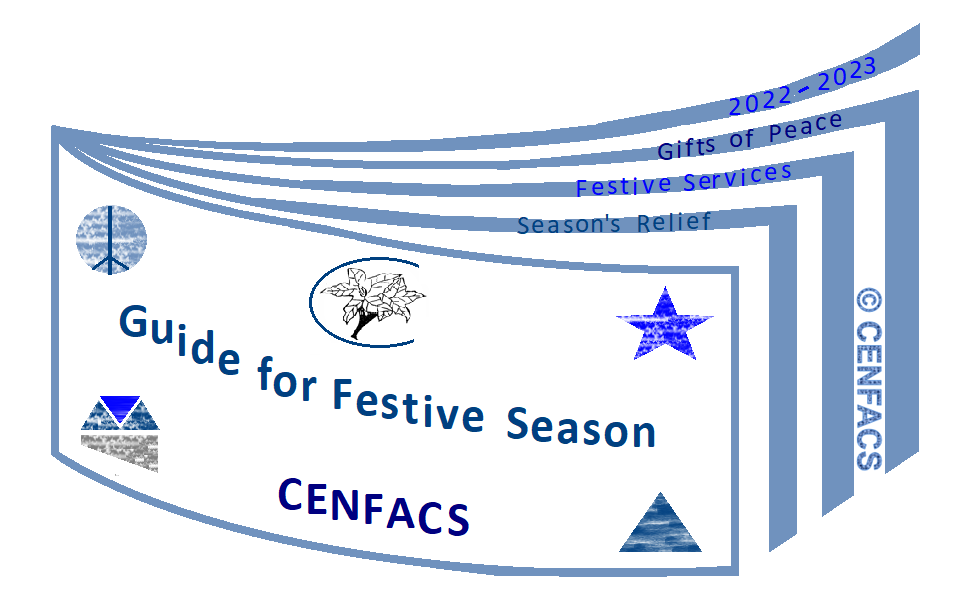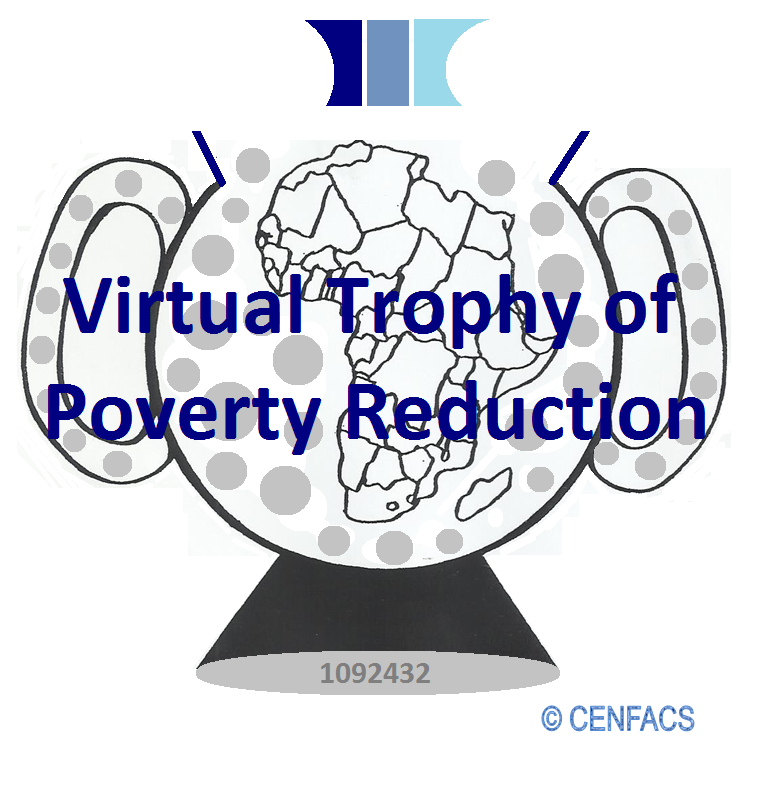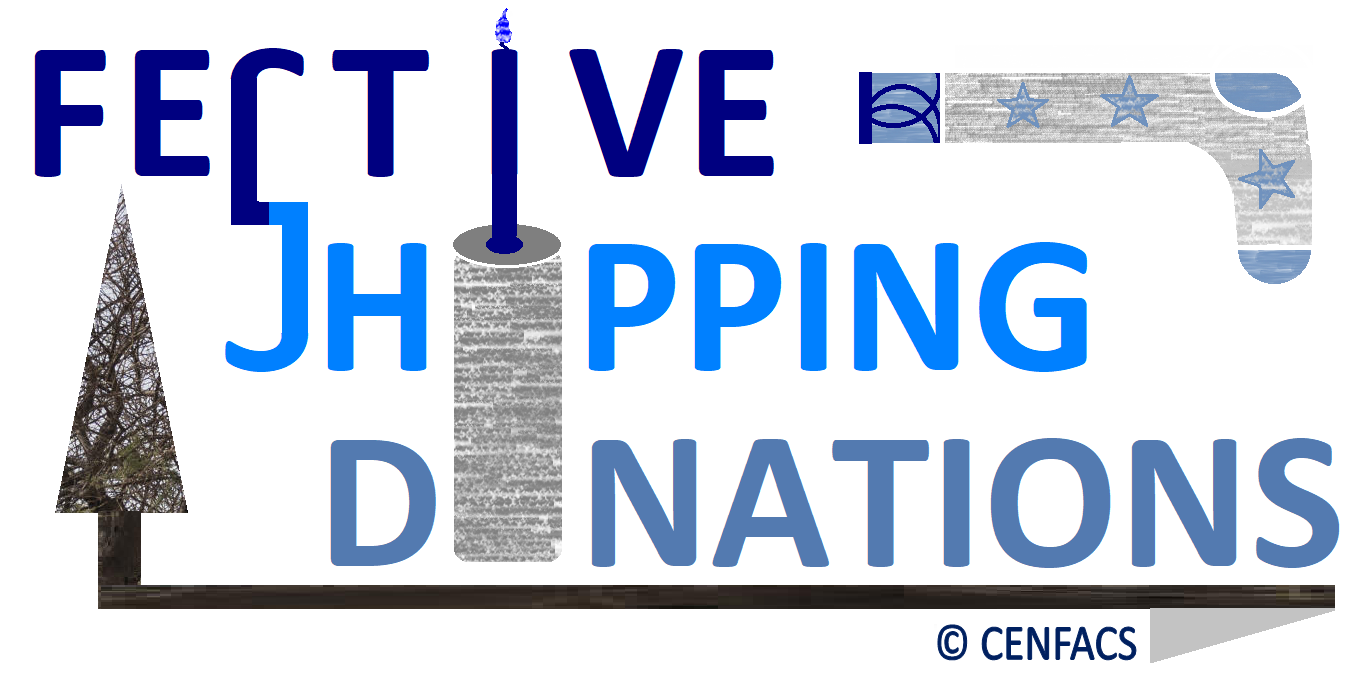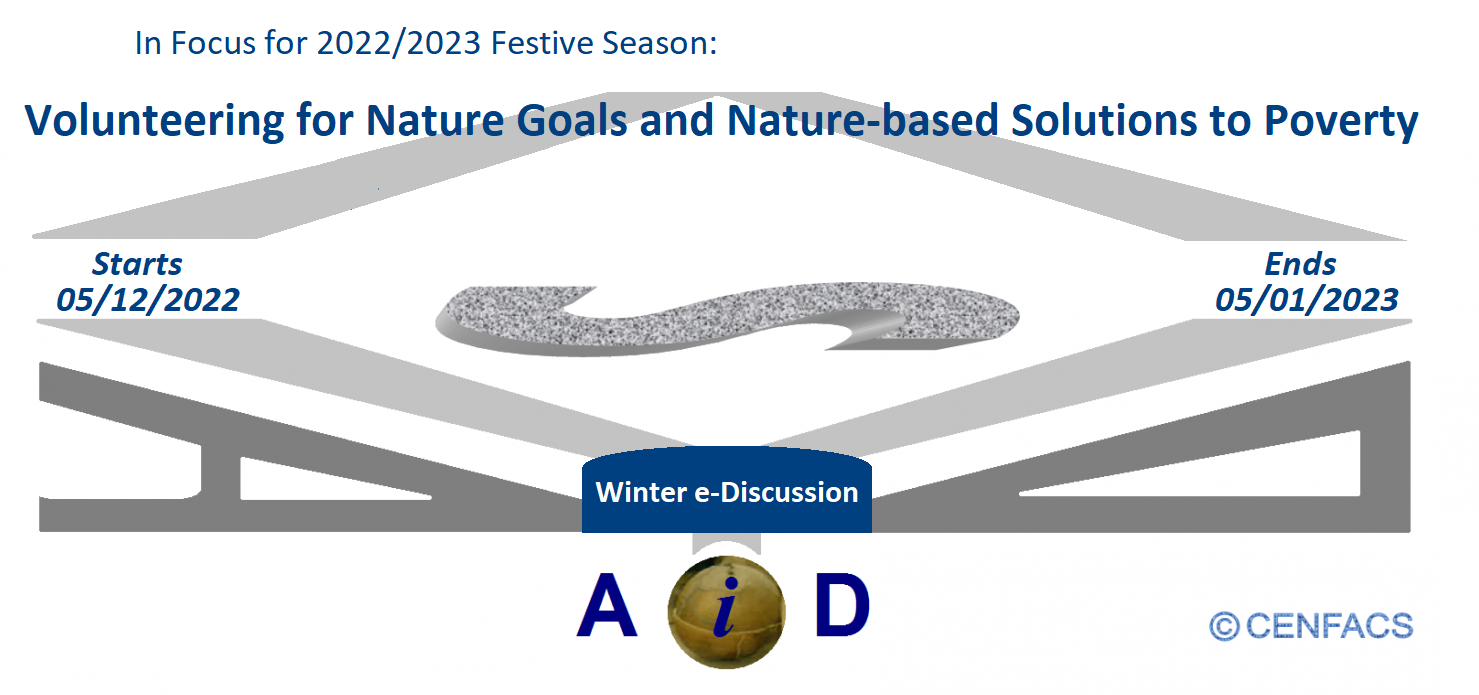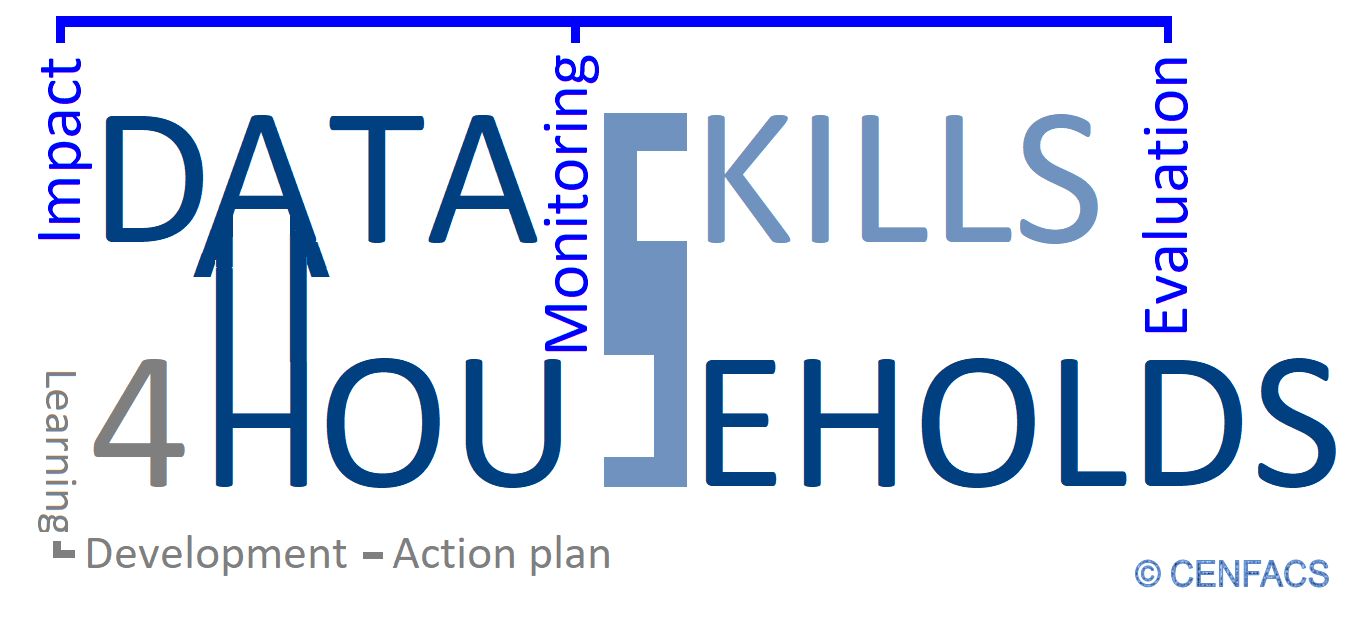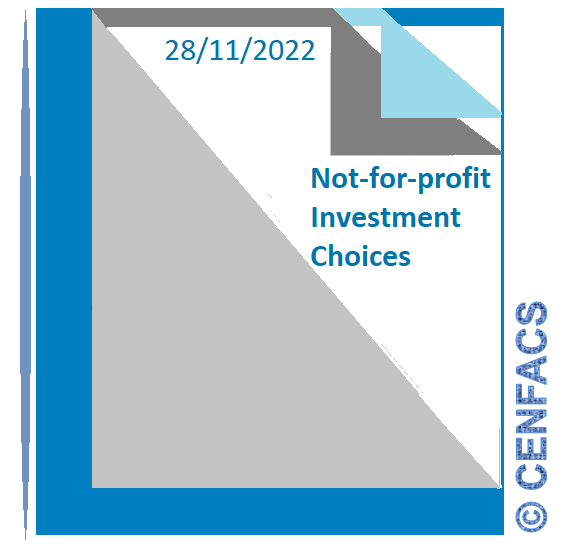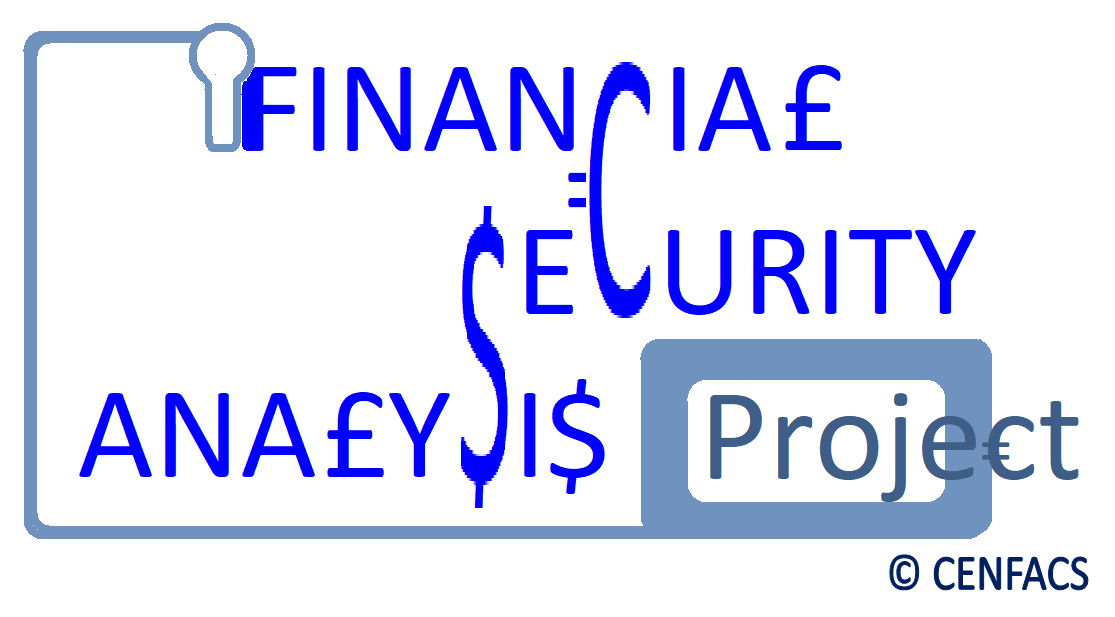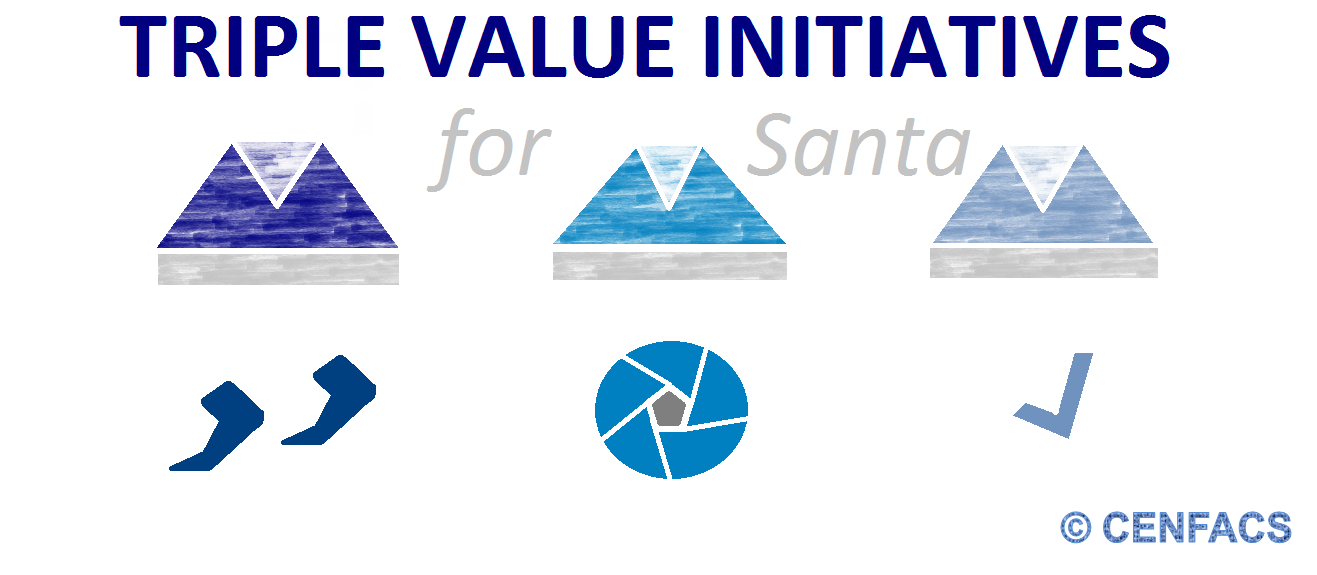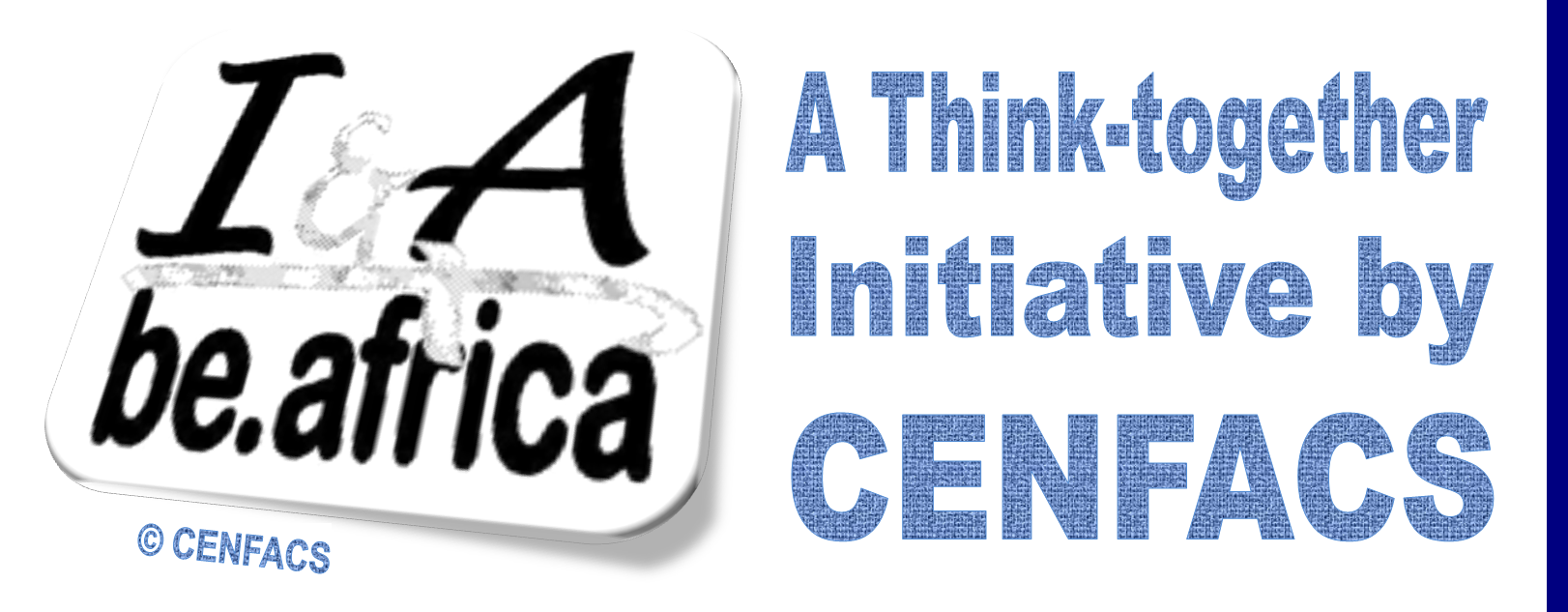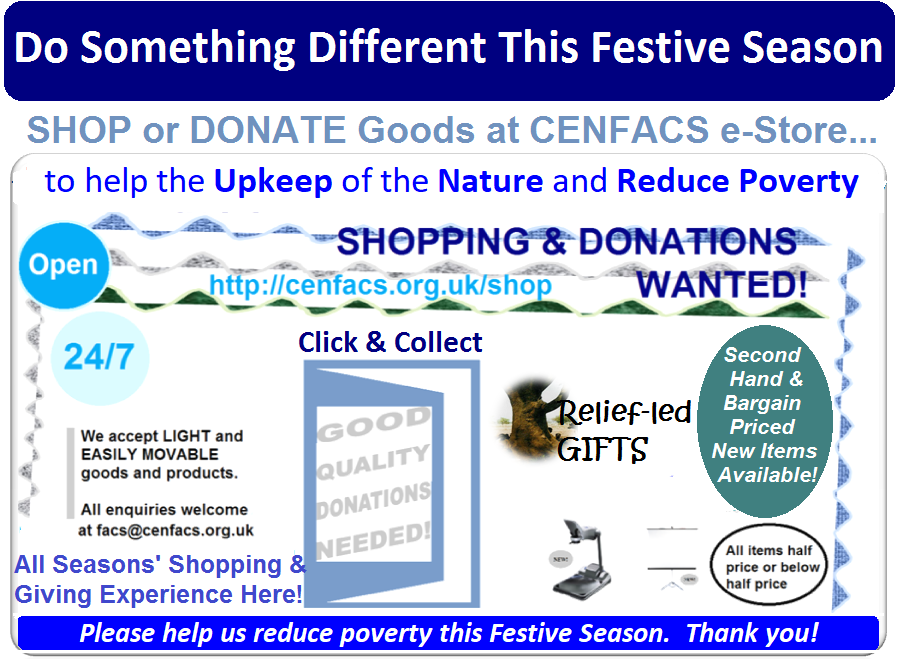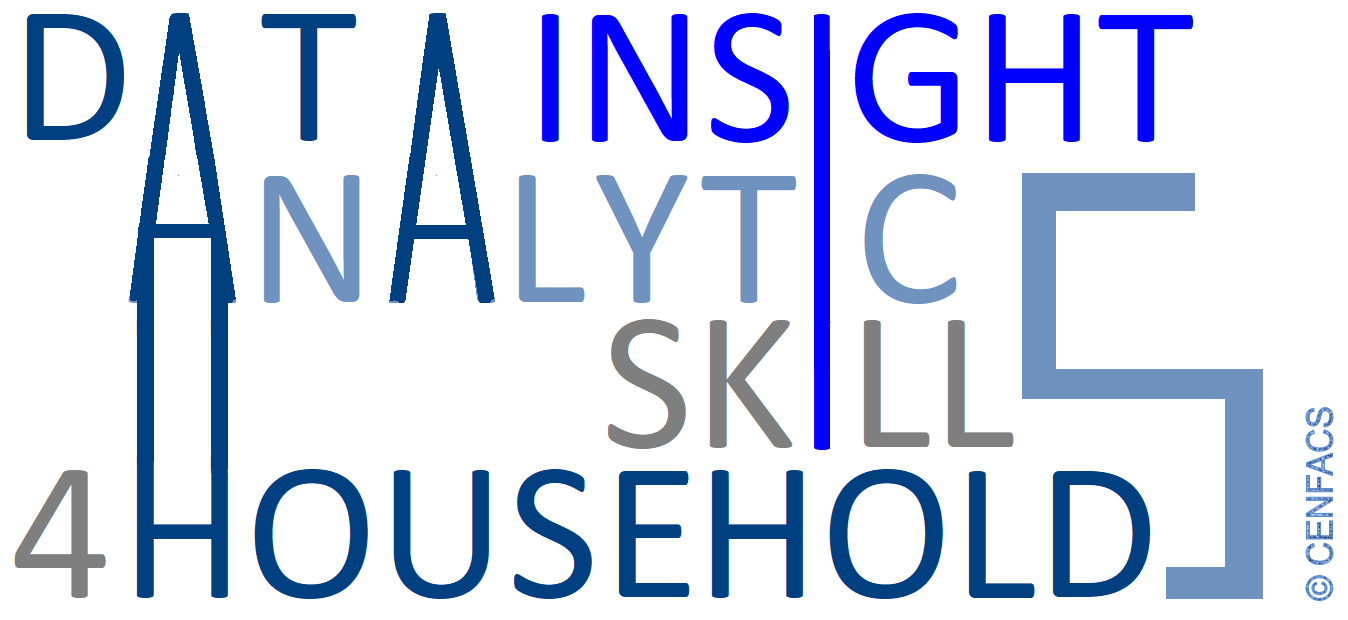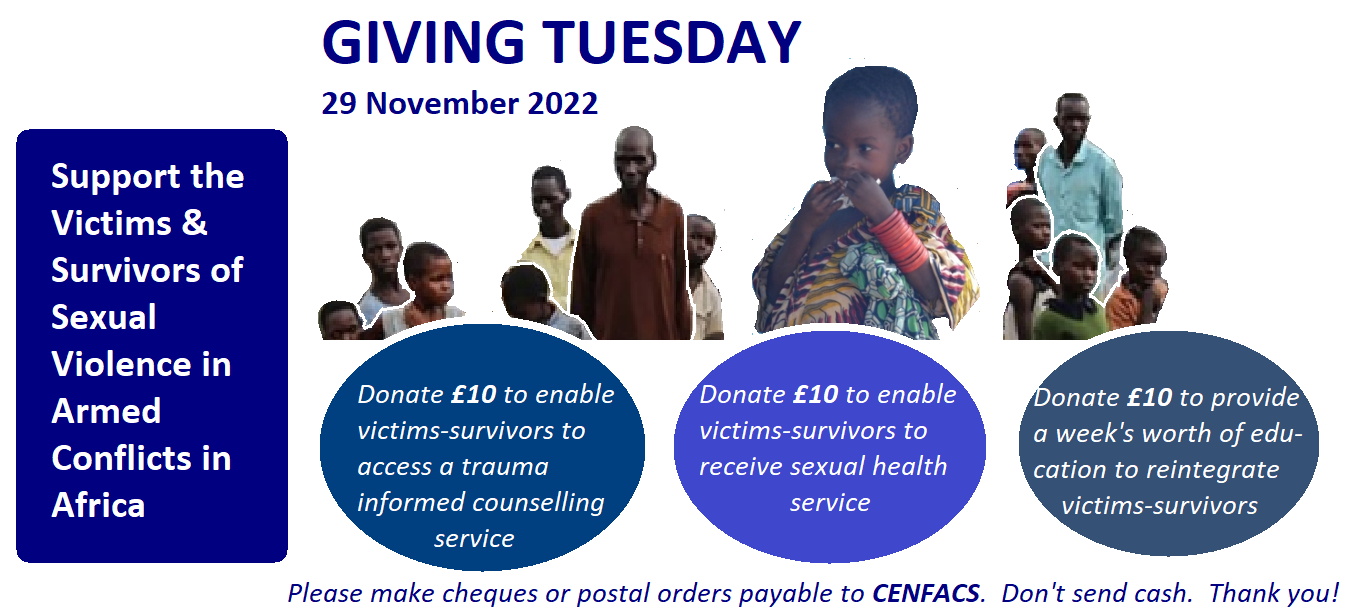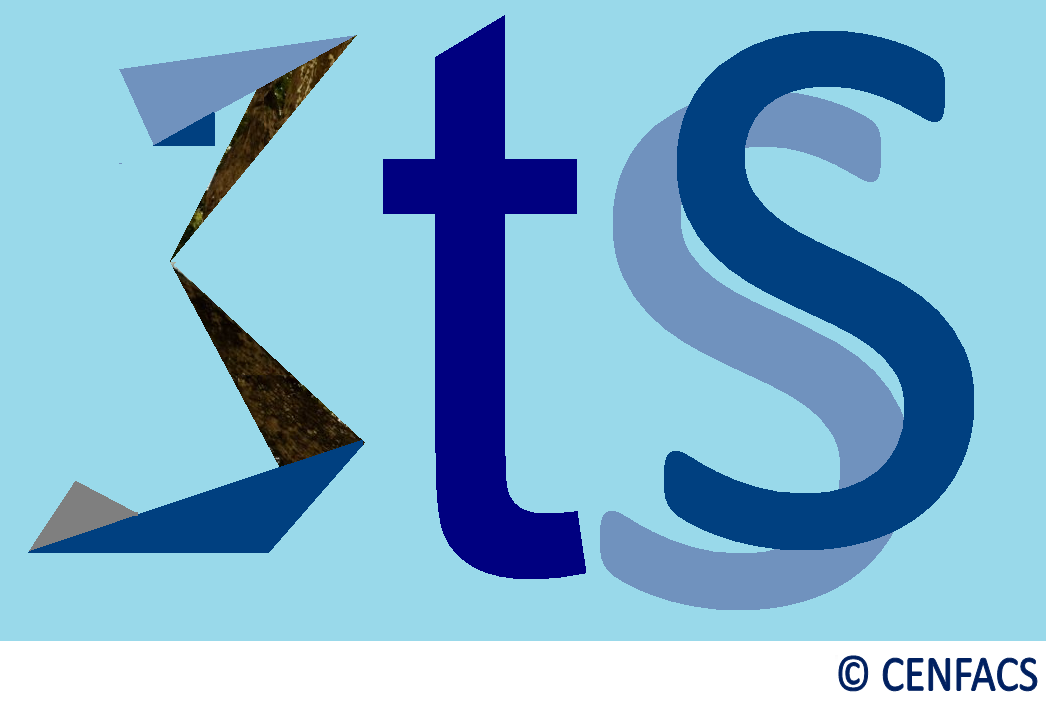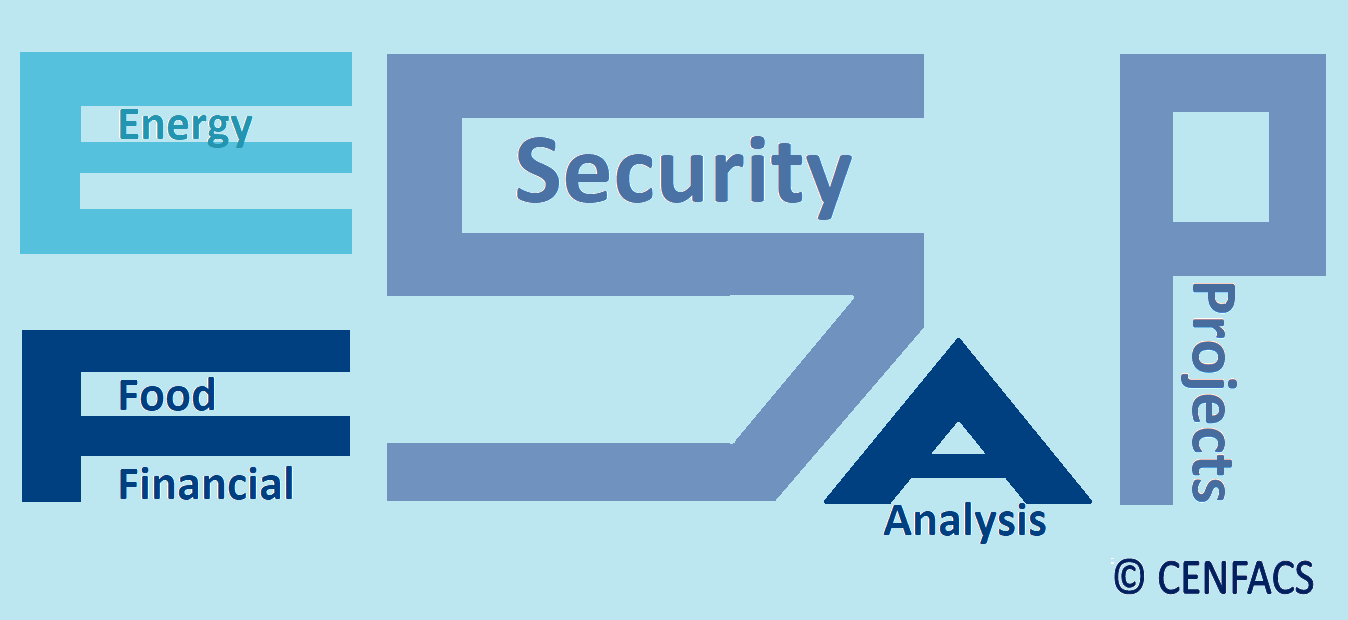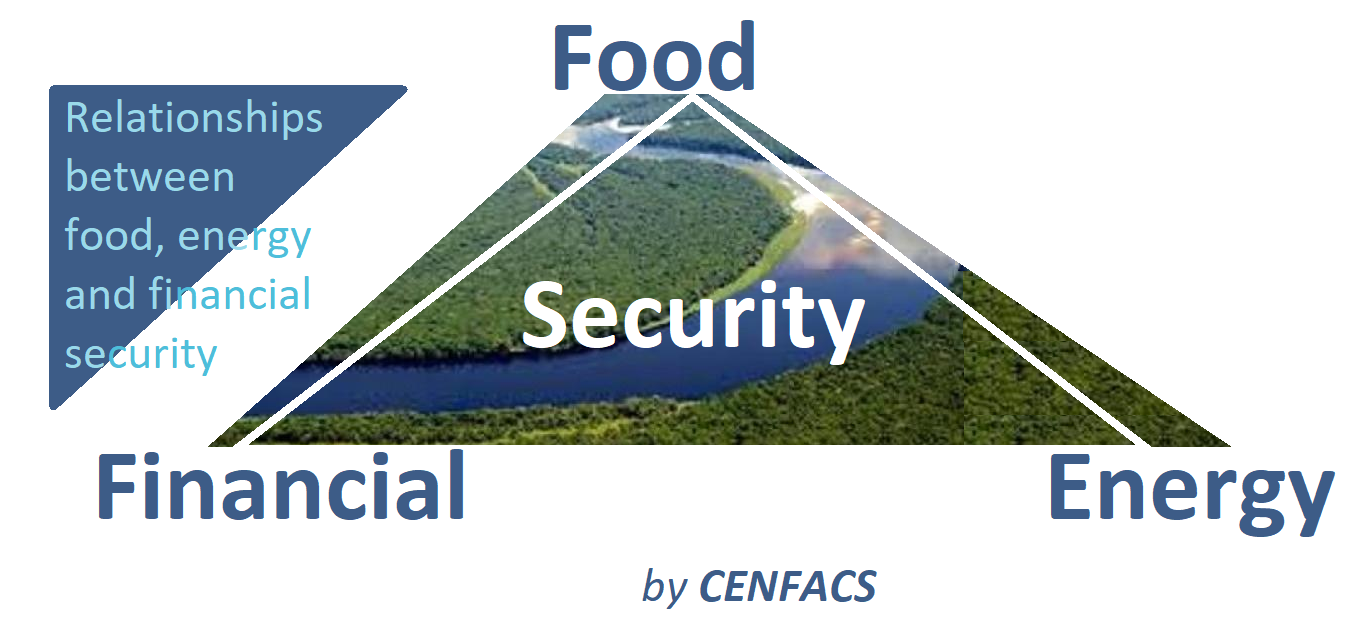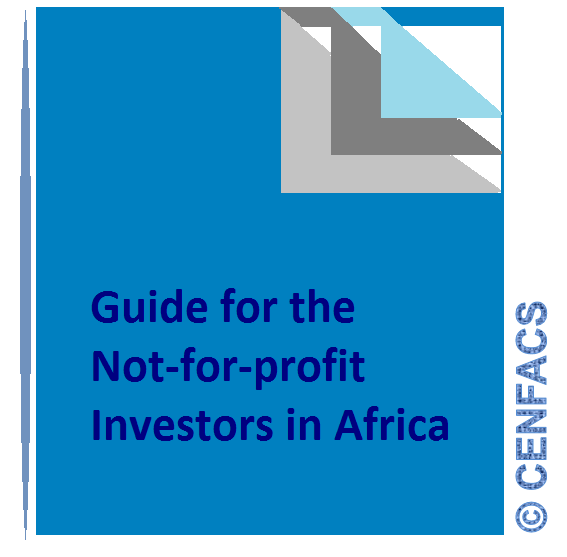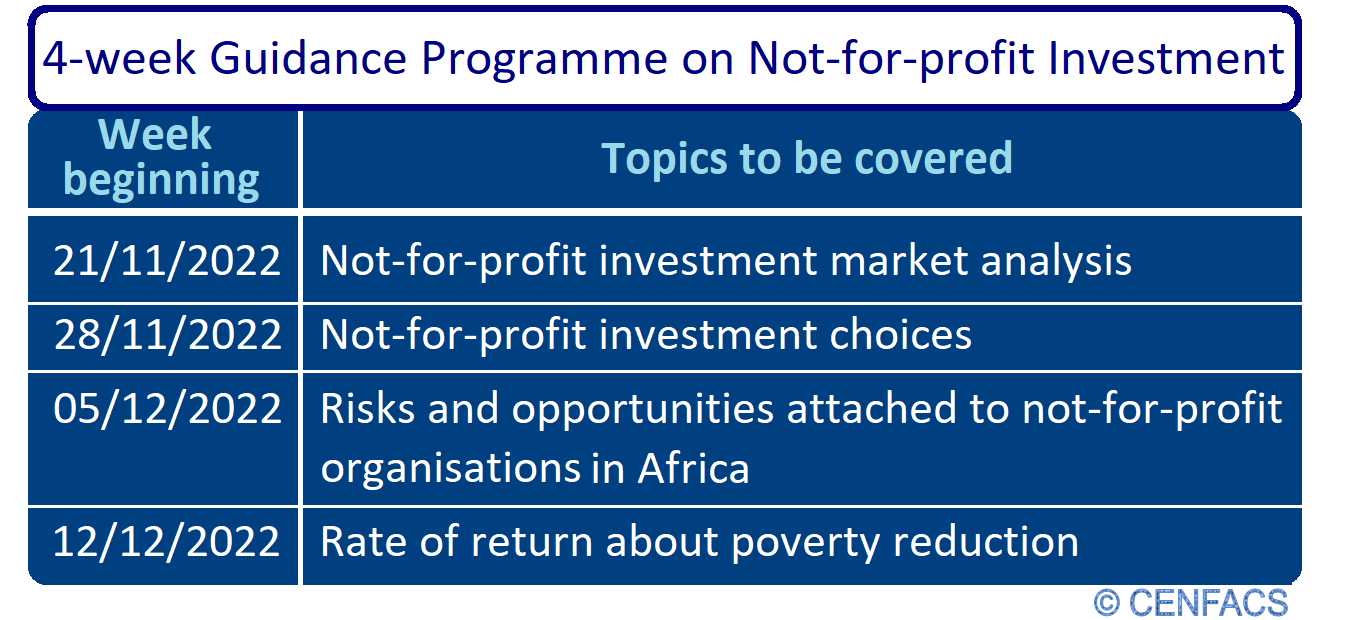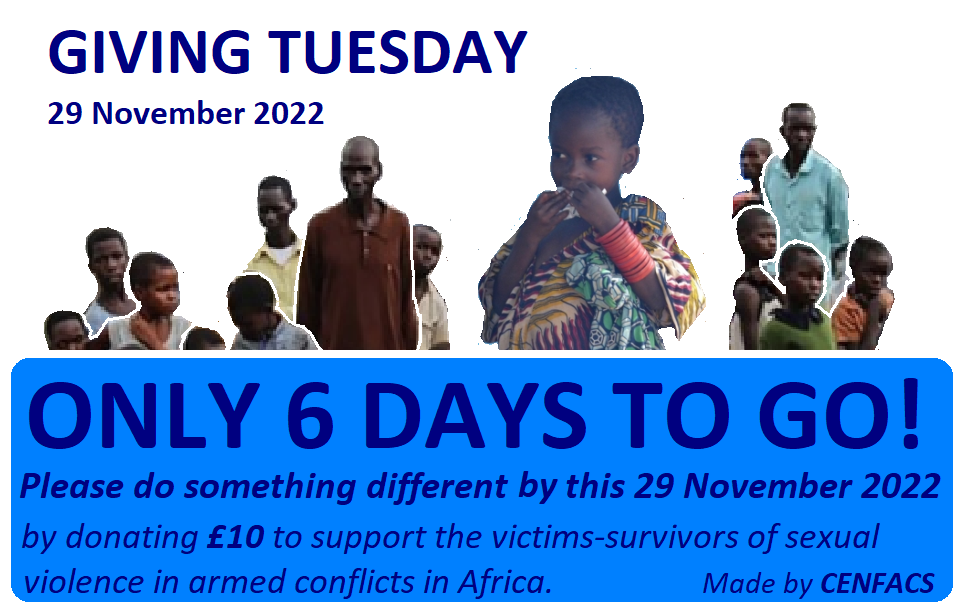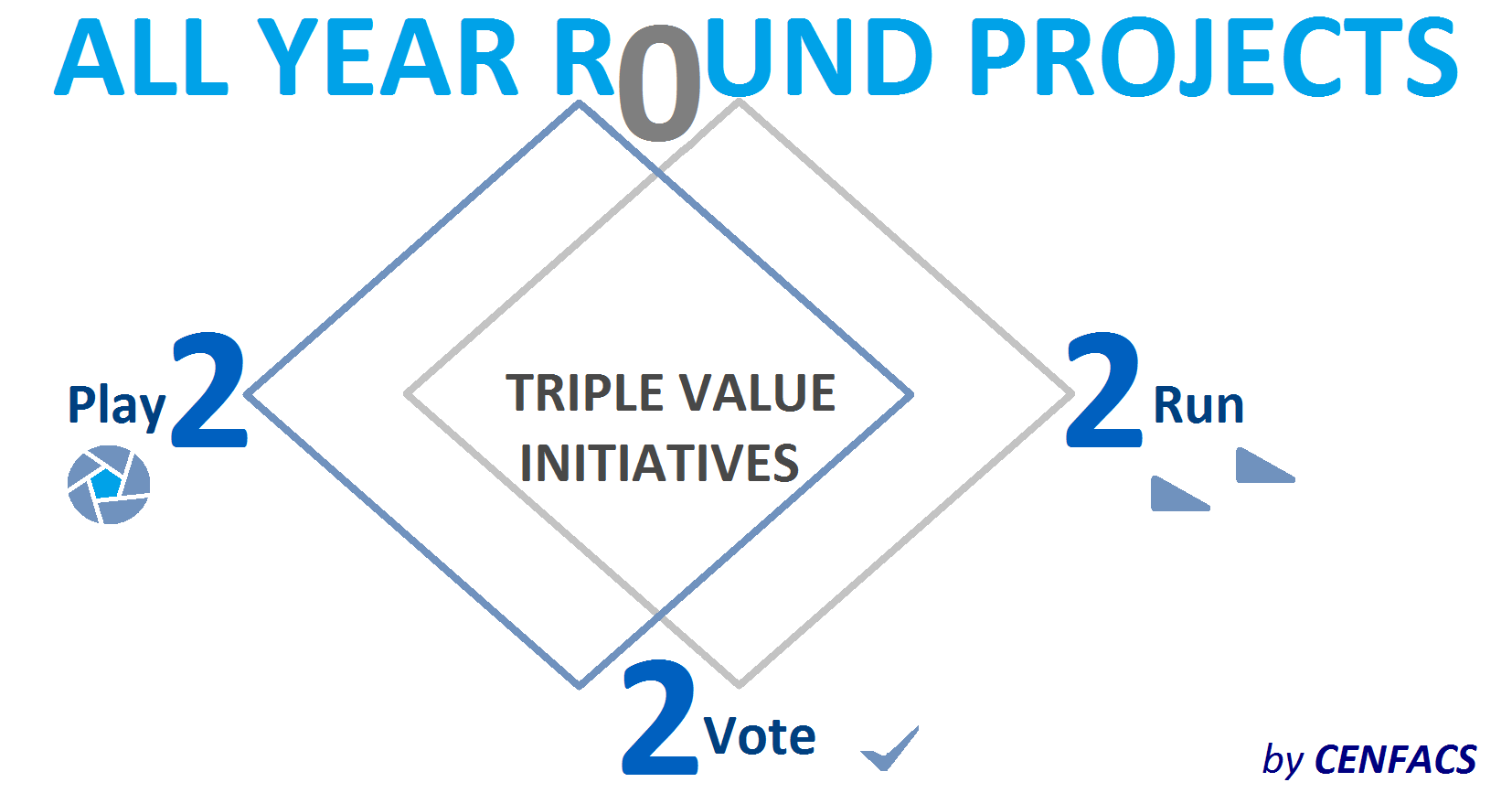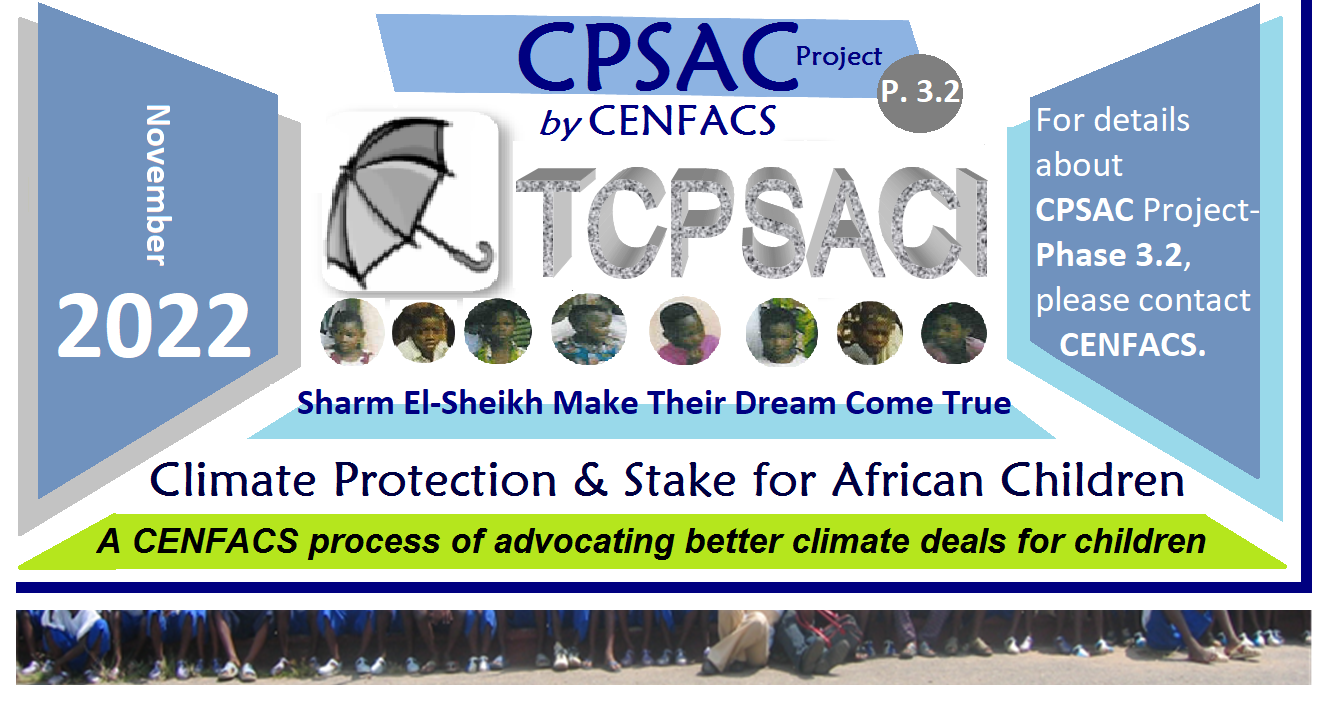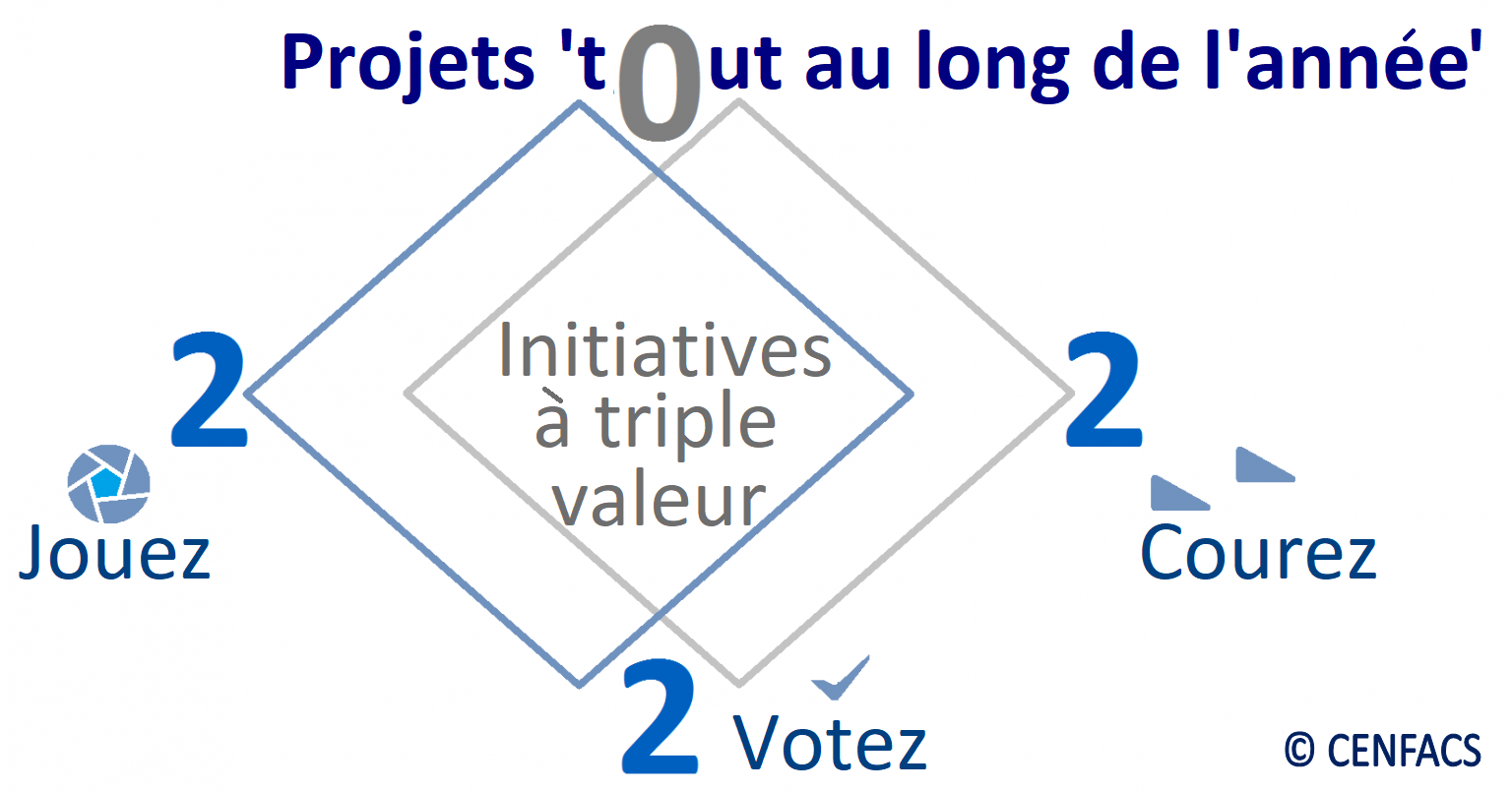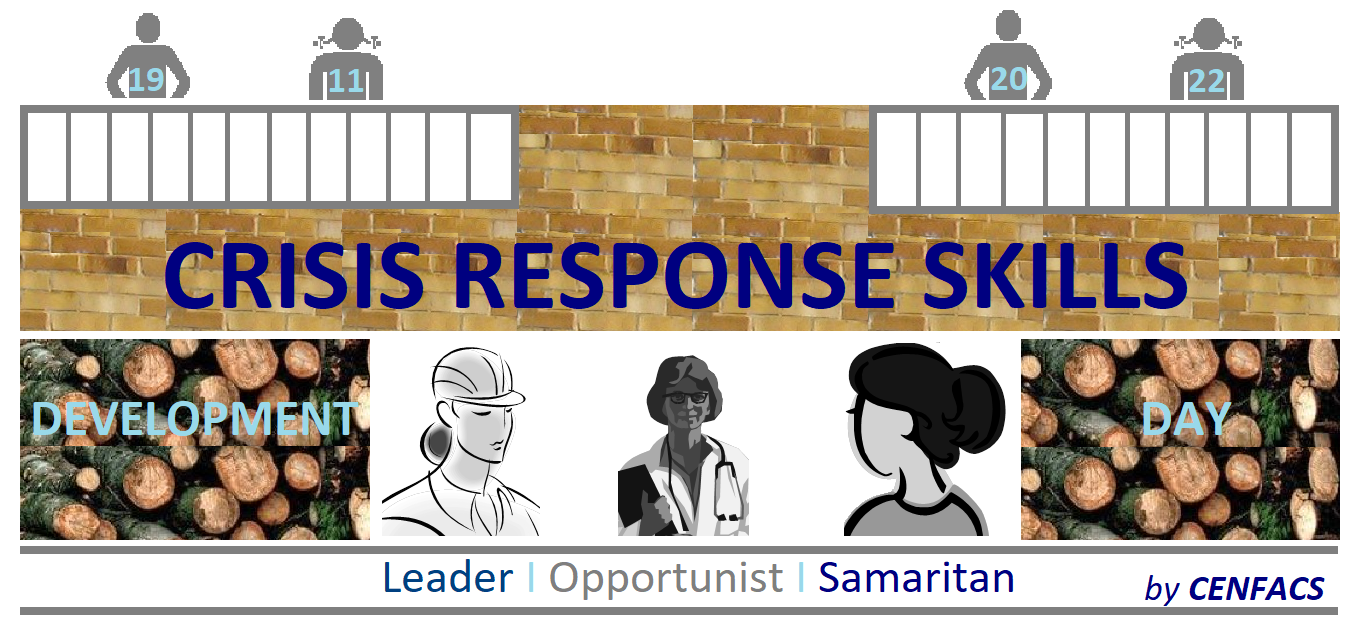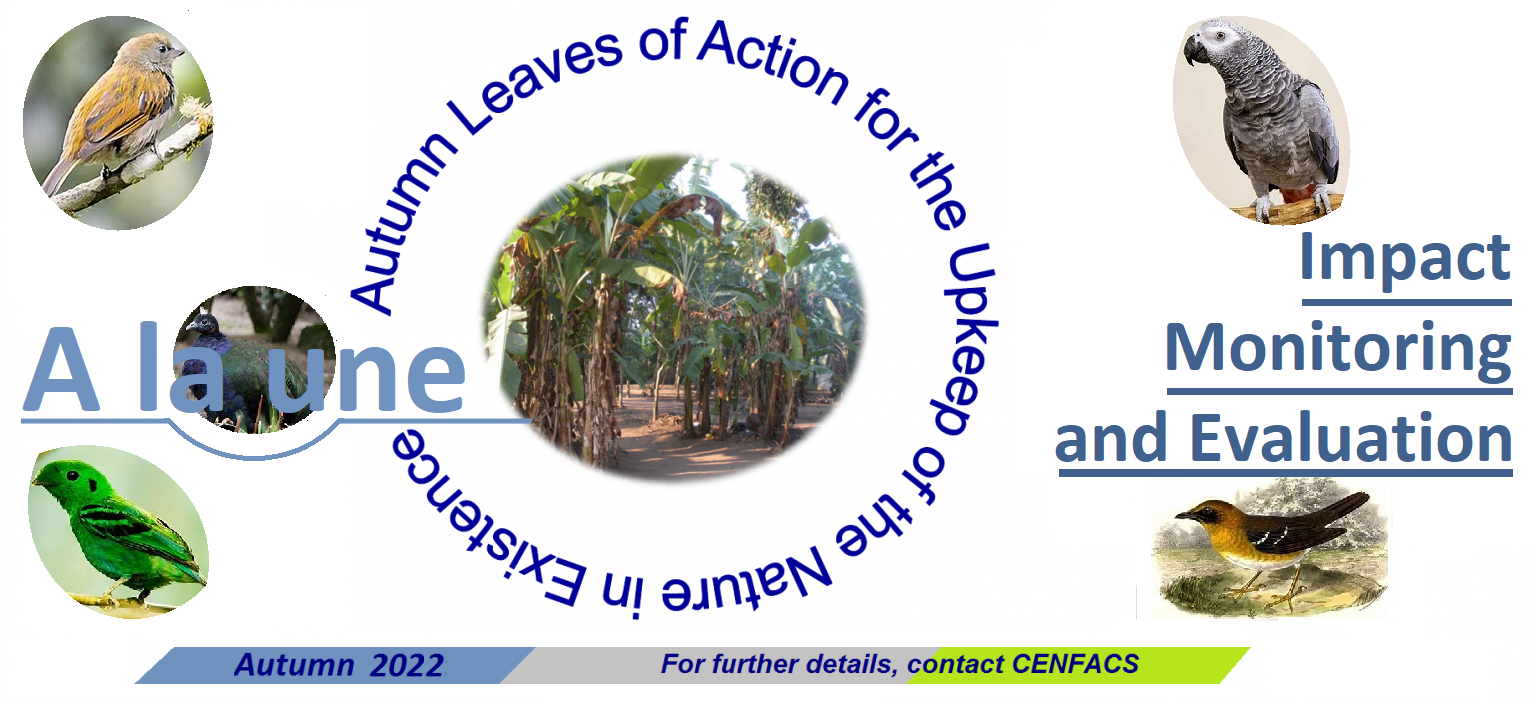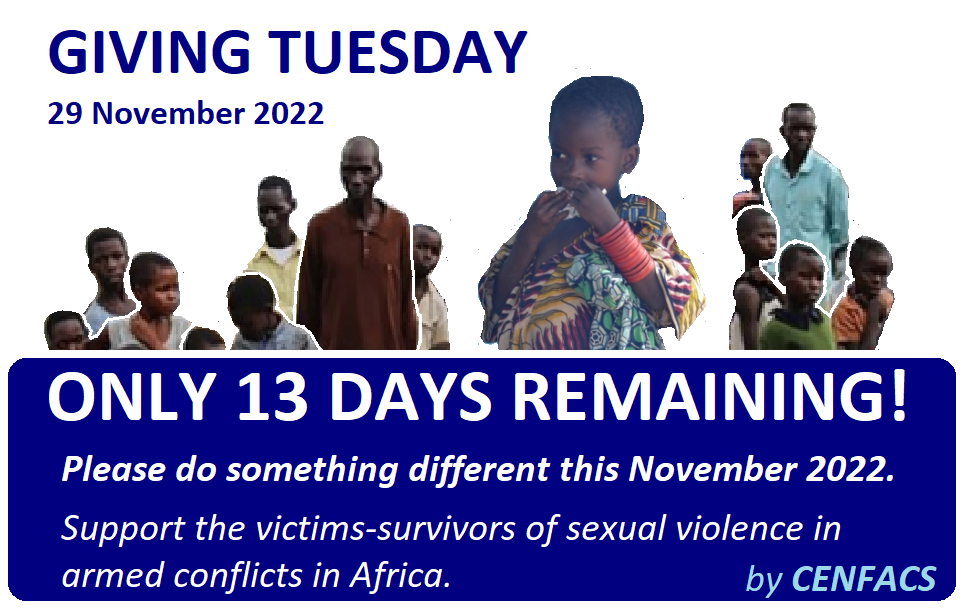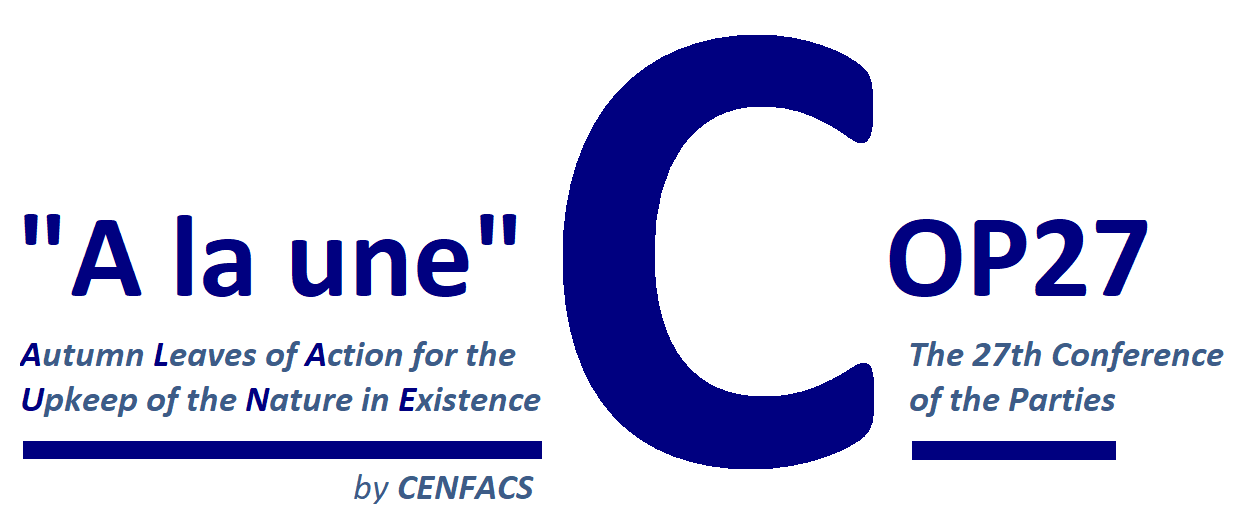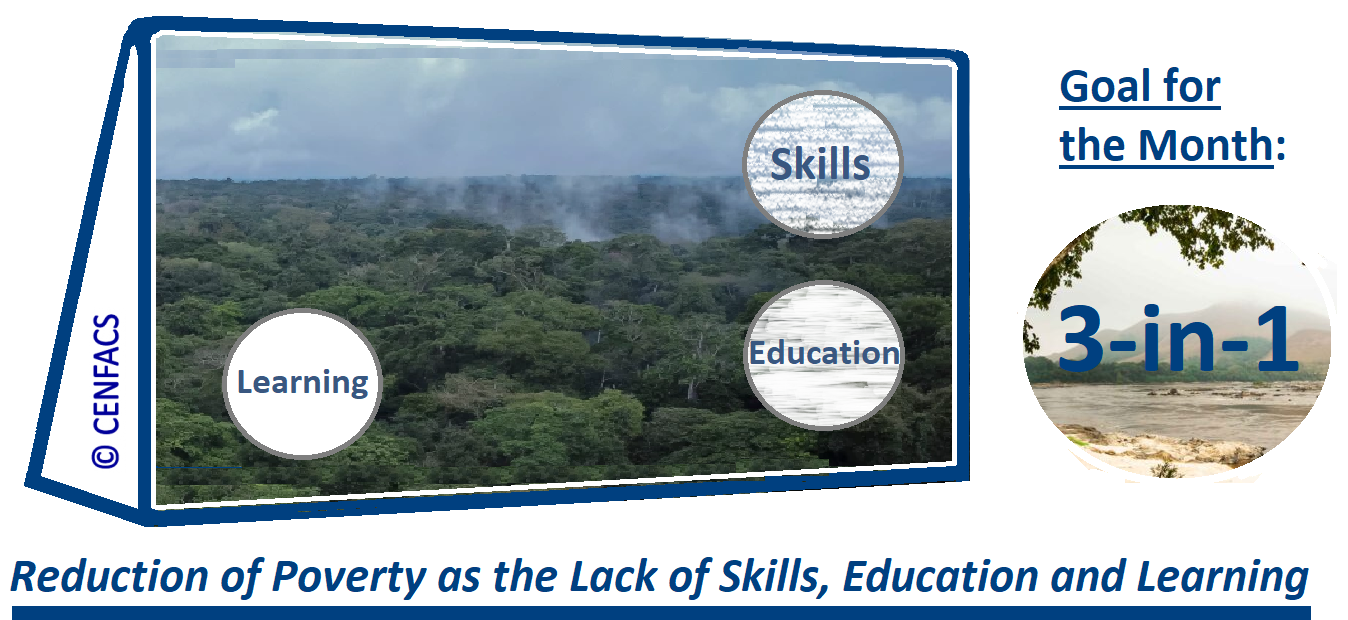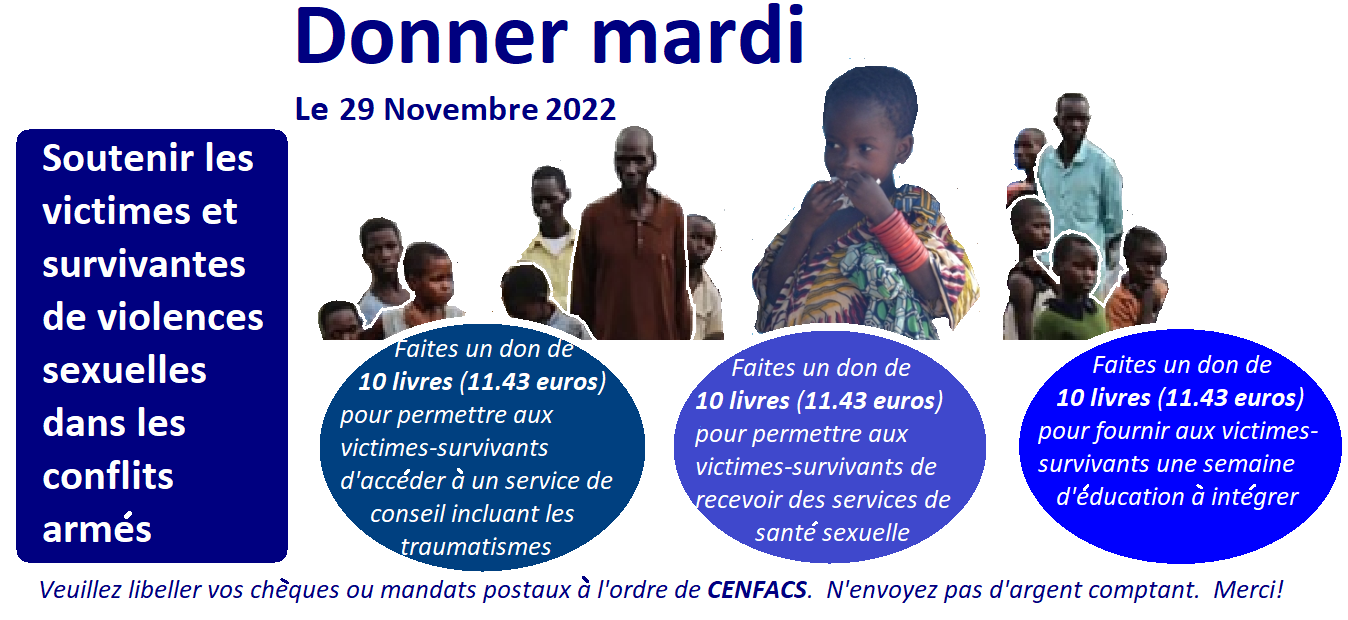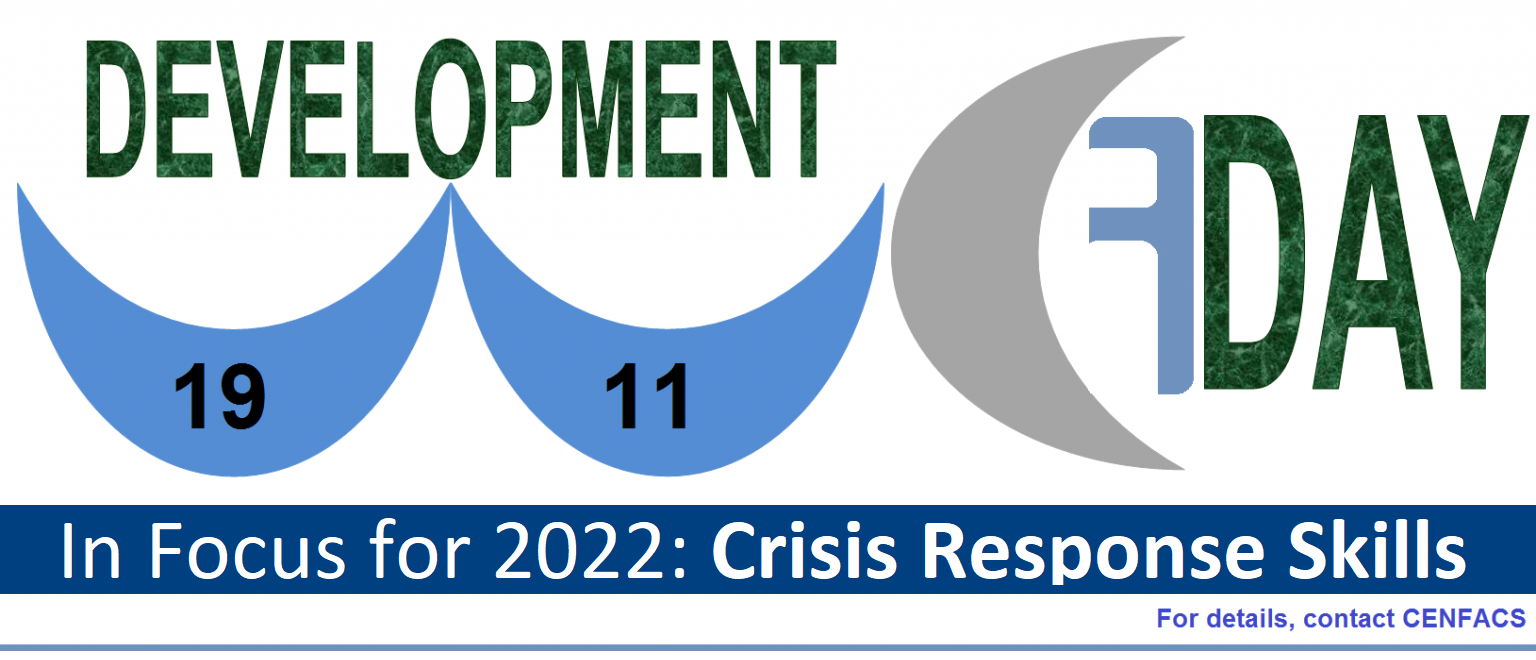Welcome to CENFACS’ Online Diary!
18 January 2023
Post No. 283
The Week’s Contents
• FACS, Issue N0. 78, Winter 2022/2023: Promoting the Culture of Insurance Amongst Those in Need to Reduce Poverty in Africa
• 2023 as a Year of Positive Influence to Poverty Reduction
• 2023 as a Year of Opportunities, Openings and Operations to Reduce Poverty by Africa-based Sister Organisations
… And much more!
To donate or fund on 30 and 31 January 2023 as well as to share the Joy of Giving, please contact CENFACS on these days.
Key Messages
• FACS, Issue N0. 78, Winter 2022/2023: Promoting the Culture of Insurance Amongst Those in Need to Reduce Poverty in Africa
The key message of this New Year’s Issue of FACS, our bilingual newsletter, is that promoting the culture of insurance can help reduce poverty amongst the people in need in Africa in 2023 and beyond.
In this promotional effort to help the people in need master the culture of insurance and work for them, culture of insurance is approached from the perspective of the insured rather than from the insurance professionalism and companies. The culture of insurance is also treated at the level of micro-insurance.
Culture is looked at from the point of view of social science or social scientists. Our analysis of culture draws its inspiration from what John Scott and Gordon Marshall (1) argue in their Oxford Dictionary of Sociology when referring to cultural anthropology. They argue that
“The analysis of culture [can be undertaken] at three levels: learned patterns of behaviour; aspects of culture that act below conscious levels; and patterns of thought and perception” (p. 153)
By applying this perception of culture to insurance applicants on low or modest incomes, we can argue that it is possible to introduce and develop the idea of insurance to become a cultural resource or capital for those in need who may be insurance applicants. It is possible for the needy to learn patterns of behaviour, thought and perception to help themselves by deciding by themselves how much insurance to buy for a well-defined risk.
This shared set of beliefs, attitudes, values, assumptions and rules for insurance behaviour and which are held by those using insurance services and products is what can be called the culture of insurance. People in need can be included in that part of the society sharing this set of beliefs.
A good cultural transmission or education and distribution of insurance as a cultural resource or capital amongst those in need can help reduce poverty in Africa or elsewhere. Poverty here is interpreted in absolute or subsistence terms as the poverty line, that is a threshold below which those in need are unable to meet their necessities for subsistence. When people lack resources to buy a basic insurance policy, this could suggest that they are experiencing insurance poverty.
Promoting a culture of insurance amongst those lacking necessities in Africa can help to cross this line of poverty for an improved and advanced position of life. It is about helping to enhance the poor’s experiences, perceptions, knowledge, attitude and understanding of insurance concepts, products and service providers.
To find out how this can be done, please read under the Main Development section of this post the key summaries and highlights making the 78th Issue of FACS.
• 2023 as a Year of Positive Influence to Poverty Reduction
To get good or expected outcomes from any efforts to reduce poverty does not necessarily mean one should heavily rely on financial means. There are other means such as a positive influence that can add value to humanitarian aid for example. We say positive influence as we all know that influence can also be negative.
So, 2023 will be dedicated as a Year of Positive Influence to Poverty Reduction within CENFACS. From this dedication, we hope that the needs of our users can be satisfied via the use of a positive influence to mobilise support and resources towards the meeting of their needs.
It is the year we are looking forward to working with the members of our community and Africa-based Sister Organisations via influencing skills, styles and models to help reduce poverty and enhance sustainable development. Influencing skills, styles and models will assist to approach crises and challenging situations to get the best outcomes for poverty reduction.
It is a year of using the fundamental principles of influencing others, especially those in the position of power, to better change things so that poverty reduction can be achieved for those who need it. Poverty reduction does not always come by itself, unless those who are holding the key to it feel that positive influence is coming to them. But, what do we mean by influence?
• • Understanding influence
There are many ways in which influence can be approached. Concerning the dedication of this year as of Positive Influence to Reduce Poverty within CENFACS, we are referring to what the ‘Center for Creative Leadership’ (2) argues, which is:
“Influence is the ability to personally affect the actions, decisions, opinions, or thinking of others. Ultimately, influence allows you get things done and achieve desired outcomes”.
The same ‘Center for Creative Leadership’ differentiates three key influencing tactics or ways to influence, which are: logical appeals (head), emotional appeals (heart) and cooperative appeals (hands).
• • Applying the 3 Hs (i.e., head, heart and hands) to appeal to influential figures
Throughout 2023, we shall use both our head, heart and hands to appeal to those who can (i.e., influential figures) to help us help reduce poverty and enhance sustainable development. It will be about positively influencing (that is, inspiring and motivating) these influential people by getting things done and achieve poverty reduction outcomes.
By the end of January 2023, there will be a project to implement this dedication. The project will be a one-year initiative starting from week beginning 23 January to the end of December 2023. However, for those who would like to know more about this dedication, they are free to enquire from CENFACS. Likewise, for those who would like to support it, they are welcome to do so.
We hope you will work with us or be with us as we take journey in influencing influential people to get poverty reduced throughout 2023 and beyond.
• 2023 as a Year of Opportunities, Openings and Operations to Reduce Poverty by Africa-based Sister Organisations
Every year brings along with it challenges and opportunities. 2023 does not make any exception as it brings both challenges and opportunities. Africa-based Sister Organisations can do their own SWOT analysis to identify and determine the internal Strengths and Weaknesses of their organisations as well as the external Opportunities and Threats they may come across throughout 2023.
By focusing on opportunities and openings rather than on the other three elements of SWOT analysis, they can appraise their external environment and their presence in African markets of poverty reduction as well as formulate a strategy and develop their services to work with those in need in a new or improved direction.
2023 is also a year of getting back on track operations to reduce poverty after the three of the coronavirus pandemic. In the last three years, many operations were scaled down or closed or simply abandoned because of the coronavirus. Now that many of the activities and services have been curated across Africa after the coronavirus disaster, Africa-based Sister Organisations can seize the momentum of the New Year to resume or increase their operations.
For example, they can use the following possibilities to help further reduce poverty in Africa in 2023 by:
√ Helping to sensitize people to get COVID-19 vaccine since Africa has largely COVID-19 unvaccinated people
√ Assisting disease sufferers to gain access to medical treatments as far as the management of other diseases (like HIV-Aids, malaria, TB and diabetes) are concerned
√ Advocating for the end of violence in order to contain violence in conflict hotspots like in African Sahel and others
√ Campaigning for technology transfer to back up energy transition
√ Helping to cut down risks of worsening humanitarian crises like in the Democratic Republic of Congo, Burkina Faso, Central African Republic, Mali, Niger, Cameroon, and so on
√ Supporting urban poor in terms of their demand for land use, housing, consumer goods and services regarding urbanisation
√ Accompanying poor people in their recovery efforts from the lingering effects of the coronavirus, the cost-of-living crisis and natural disasters (like in the flood-impacted people in the Democratic Republic of Congo)
√ Working with poor people to develop their digital skills via education and training in order to keep pace with digital revolution
√ Supporting indebted and income deficit poor people to restructure their income deficits and debts as far as the management of income deficits and debts are concerned
√ Assisting in African Diaspora’s money remittances or transfer schemes to those in need in Africa in the areas of international payments, travel and tourism
√ Working with more than 20 million people touched by famine and drought in East Africa
√ Helping poor people to formulate their human rights request/demand to make 2023 elections and transitions in Africa as processes that leave none, no need and no place behind
Etc.
The above possibilities show that Africa-based Sister Organisations can cautiously grab the opportunities and openings of the 2023 year in order to operate and further up their poverty reduction work and regain the lost hard-won poverty reduction results; lost results because of economic crises, climate change and armed conflicts in Africa.
For those Africa-based Sister Organisations wanting to operate and work on these opportunities and openings but finding some difficulties to operate; they can discuss the matter with CENFACS so that together we can plan a 2023 market development strategy.
Need a market development strategy or plan in order to operate and better engage with the 2023 opportunities and openings; please do not hesitate to contact CENFACS.
Extra Messages
• The Season of Giving Continues with SHOPPING and DONATIONS
• Looking for Help and Support about Ways of Reducing Food Waste and Over Consumption
• Gifts of Peace Still Running
• The Season of Giving Continues with SHOPPING and DONATIONS at http://cenfacs.org.uk/shop/
Every season or every month is an opportunity to do something against poverty and hardships. January is too a good and great month of the year to do it.
You can donate or recycle your unwanted and unneeded goods gifts you received over the festive days to CENFACS’ Charity e-Store, the shop built to help relieve poverty and hardships.
You can as well buy second hand goods and bargain priced new items and much more.
CENFACS’ Charity e-Store needs your support for SHOPPING and GOODS DONATIONS.
You can do something different this Season of Goods Donations by SHOPPING or DONATING GOODS at CENFACS Charity e-Store.
You can DONATE or SHOP or do both:
√ DONATE unwanted Festive GOODS GIFTS and PRODUCTS to CENFACS Charity e-Store this January and Winter
√ SHOP at CENFACS Charity e-Store to support noble and deserving causes of poverty relief this January and Winter.
Your SHOPPING and or GOODS DONATIONS will help to the Upkeep of the Nature and to reduce poverty and hardships.
This is what the Season of Giving is all about.
• Looking for Help and Support about Ways of Reducing Food Waste and Over Consumption
The month of Responsible or Sustainable Consumption within CENFACS continues through our Advice-giving Service.
For those who are looking for support to reduce food waste and over consumption, they can get in touch with CENFACS’ Advice-giving Service.
Support under this service can be given in hybrid fashion by making an appointment with CENFACS.
To book an appointment, you can text, phone, e-mail and complete the contact form.
After making and agreeing an appointment, one of CENFACS volunteers will get in touch and assist those in need of support in terms of reducing food waste and over consumption.
• Gifts of Peace Still Running
Our Season of Giving through the Gifts of Peace has not yet finished. The Gifts of Peace are nonetheless running. We still have almost 1 week and 6 days to go until the end of this month. We are making a plea to those who have not yet managed to support to keep these gifts and our agenda for peace in their mind.
Although the deadline for the Season of Donation for these gifts is 31 January 2023, we will nevertheless accept any donations made after this deadline as there are always pressing needs that desperately request support.
Please do not wait for the expiration of the deadline as the needs are pressing and urgent.
For further details about these Gifts of Peace and or to support, go to http://cenfacs.org.uk/supporting-us/
We look forward to your support. Thank you!
Message in French (Message en français)
Vient de paraître cet hiver 2023:
Le 78e numéro de FACS dont le titre est…
Promouvoir la culture de l’assurance parmi les nécessiteux (ses) pour réduire la pauvreté en Afrique.
Le message clé de ce premier numéro de FACS, notre bulletin bilingue, du Nouvel An est que la promotion de la culture assurantielle peut aider à réduire la pauvreté parmi les personnes dans le besoin en Afrique en 2023 et au-delà.
Dans cet effort promotionnel d’ensemble pour aider les personnes dans le besoin à maîtriser la culture de l’assurance, la culture de l’assurance est abordée du point de vue de l’assuré(e) plutôt que du professionnalisme et des compagnies d’assurance.
La culture est ainsi considérée du point de vue des sciences sociales ou des scientistes sociaux. Notre analyse de la culture s’inspire de ce que John Scott et Gordon Marshall (1) soutiennent dans leur Dictionnaire de Sociologie d’Oxford lorsqu’ils se réfèrent à l’anthropologie culturelle. Ils font valoir que
« L’analyse de la culture [peut être entreprise] à trois niveaux : les modèles de comportement appris; les aspects de la culture qui agissent en dessous des niveaux conscients; et les schémas de pensée et de perception » (p. 153)
En appliquant cette perception de la culture aux demandeurs(ses) d’assurance, nous pouvons soutenir qu’il est possible d’introduire et de développer l’assurance pour qu’elle devient une ressource culturelle ou un capital pour ceux ou celles qui en ont besoin et qui peuvent être des demandeurs(ses) d’assurance. Il est possible pour ceux ou celles qui en ont besoin d’apprendre des modèles de comportement, de pensée et de perception pour s’aider eux-/elles-mêmes en décidant d’eux/elles-mêmes du montant d’assurance à acheter pour un risque bien défini.
Une bonne transmission culturelle ou une bonne éducation et la distribution de l’assurance en tant que ressource culturelle ou capital parmi ceux ou celles qui en ont besoin peuvent aider à réduire la pauvreté en Afrique. La pauvreté est ici interprétée en termes absolus ou de subsistance comme le seuil de pauvreté, c’est-à-dire un seuil en dessous duquel ceux/celles qui sont dans le besoin sont incapables de subvenir à leurs besoins de subsistance. Quand les gens manquent de ressources pour acheter une police d’assurance de base, cela peut suggérer qu’ils sont en train de connaître une pauvreté assurantielle.
La promotion d’une culture de l’assurance parmi ceux/celles qui manquent de biens de première nécessité en Afrique peut aider à franchir cette ligne de pauvreté pour une position de vie meilleure et avancée.
Ceux ou celles qui sont intéressé(e)s à lire en détail la version entière en français de ce nouveau numéro de FACS peuvent contacter le CENFACS à notre adresse habituelle sur ce site internet.
Main Development
• FACS, Issue N0. 78, Winter 2022/2023: Promoting the Culture of Insurance Amongst Those in Need to Reduce Poverty in Africa
The contents and key summaries of the 78th Issue of FACS are given below.
• • Contents and Pages
I. Key Concepts Relating to the Promotion of the Culture of Insurance to the Needy (Page 2)
II. Key Theory Used in the 78th Issue of FACS: Theory of Insurance Demand (Page 2)
III. Insurance as Poverty Reducer or Alleviator (Page 3)
IV. Africa-based Sister Organisations (ASOs) and their Advocacy for Affordable Insurance (Page 3)
V. Africa-based Sister Organisations and their Anti-insurance Poverty Work in Africa (Page 4)
VI. Africa-based Sister Organisations and their Beneficiaries’ Perception of Insurance (Page 4)
VII. Les catastrophes naturelles et la culture assurantielle des nécessiteux locaux in Africa (Page 5)
VIII. Téléphones portables, assurance et réduction de la pauvreté en matière d’assurance (Page 5)
IX. La corrélation entre le taux de pénétration de l’assurance pour les nécessiteux et le taux de réduction de la pauvreté parmi ces mêmes nécessiteux (Page 6)
X. La promotion de la culture de l’assurance des nécessiteux comme effet démultiplicateur des inégalités liées au manque d’accès à l’assurance (Page 6)
XI. Survey, Testing Hypotheses, E-questionnaire and E-discussion on the Culture of Insurance (Page 7)
XII. Support, Top Tool, Information and Guidance on the Culture of Insurance (Page 8)
XIII. Workshop, Focus Group and Enhancement Activity about Culture of Insurance (Page 9)
XIV. Giving and Project (Page 10)
• • Key Summaries
Please find below the key summaries of the 78th Issue of FACS from page 2 to page 10.
• • • Key Concepts Relating to the Promotion of the Culture of Insurance to the Needy (Page 2)
There are three essential concepts that will help the readers of FACS to better understand the contents of the 78th Issue. These concepts are the culture of insurance, the needy and insurance poverty. These concepts will help readers of this Issue of FACS to better understand and identify the matters raised within it. Let us look at each of these concepts.
• • • • Culture of insurance
It is the customs, ideas and art of deciding how much insurance to buy for a well-defined risk. In this respect, the culture of insurance is approached from the perspective of the buyer of insurance rather than from that of those offering insurance products and services.
A deep understanding of the culture of insurance will make us to dig deep into the notion of culture in social science. As we mentioned it in the key messages of this post, John Scott and Gordon Marshall (op. cit.) argue that
“The analysis of culture [can be undertaken] at three levels: learned patterns of behaviour; aspects of culture that act below conscious levels; and patterns of thought and perception” (p. 153)
These learned patterns can be applied in the area of insurance.
The culture of insurance does not stay the same. It can change from traditional to modern depending on the state of development of societies. Since we are in the digital age, the culture of insurance has shifted from non digital to digital one, from people using papers to mobile phones to deal with their insurance policy and payment problems.
• • • • The needy
They are potential retail insurance consumers who are lacking insurance necessities such as an insurance policy cover, money to buy insurance policy, money to change insurance provider or service, the power to claim their insurance rights, etc.
They are the under insured or uninsured segments of societies in Africa.
They are as well those who are vulnerable to insurance services and products and are looking forward to sustainable solutions to their insurance problems.
• • • • Insurance poverty
In order to understand insurance poverty one may need to know both insurance and poverty. According to John Scott and Gordon Marshall (op. cit.),
“Poverty is a state in which resources, usual material but sometimes cultural, are lacking” (p.588)
As to insurance, we can refer to what Christopher Pass and others (3) state in their Collins Dictionary of Economics, which is
“Insurance is a method of protecting a person or business against the financial consequences of loss of, and damage to, ASSETS through fire, theft, etc. (general insurance), and loss of life and limb (life and accident insurance)” (p. 254)
The two definitions can be put together to understand insurance poverty as the lack of resources to protect yourself against financial consequences of losses and damages. Insurance poverty is also the inability to pay a basic insurance policy to cover yourself and or your belongings or injuries to other people or properties to reduce financial loss or hardship.
• • • Key Theory Used in the 78th Issue of FACS: Theory of Insurance Demand (Page 2)
To highlight this theory, let us briefly look at what Ulrich Schmidt thinks about it. Ulrich Schmidt argues that
“The standard theory of decision making under risk, expected utility (EU) theory, is a subject will buy full insurance if and only if premiums are fair, i.e. equal expected losses”.
Ulrich Schmidt distinguishes EU theory from prospect theory.
Like in any theorisation process, there are those who agree with this theory, just as there are others who disagree.
For example, John A. Nyman (5) disagrees by saying that
“Expected utility theory holds that the demand for insurance is a demand for certainty, because under the conventional specification of the theory, it appears as if buyers of insurance prefer certain losses to actuarially equivalent uncertain ones. Empirical studies, however, show that individuals actually prefer uncertain losses to actuarially equivalent certain ones”.
In one of its papers, John A. Nyman tries to reconcile expected utility theory with this empirical evidence by suggesting that insurance is demanded to obtain an income payoff in the ‘bad’ state. As an example, he gives the theory of consumer demand for health insurance.
Despite some disagreements around the Expected Utility Theory, this theory stands up in many circumstances of life. We are going to use it in the 78th Issue of FACS as it is a normative theory of decision making under risk management.
• • • Insurance as Poverty Reducer or Alleviator (Page 3)
Evidence across the world suggests that insurance can contribute to poverty reduction or alleviation. In developing countries of Africa, medical and agricultural insurance programmes can help people avoid the risk of falling into poverty. Insurance can protect farmers and other poor people from poor health and natural events such floods, torrential rain, drought, etc.
There could be correlation between insurance cover and poverty reduction. However, the causality and redirection of this relationship can only be proofed using data in a particular context and time period.
Briefly speaking, with insurance cover there is a high probability that there would be less sufferings from financial loss due to life events.
• • • Africa-based Sister Organisations (ASOs) and their Advocacy for Affordable Insurance (Page 3)
It may not feasible for ASOs to determine how much insurance those in need, who are their beneficiaries, can pay. This will be the job or task of insurance brokers or professionals. What is possible is that ASOs can advocate so that insurance contribution of their needy to be affordable.
Such advocacy will require working together with those who need affordable insurance to put their cases to insurance services providers and other players. By advocating in this way, there could be a possibility for those who are excluded from the insurance world because of the lack of financial resources to be included in the insurance process in the future.
• • • Africa-based Sister Organisations (ASOs) and their Anti-insurance Poverty Work in Africa (Page 4)
Besides advocating for affordable insurance for their beneficiaries, there are other areas of work that ASOs can undertake in order to reduce insurance poverty in Africa. These other areas of work include the following:
√ Working with local insurers to adapt local needs and the needs of their beneficiaries in their insurance development agenda
√ Provide local insights and capacities to create insurance solutions for the needy
√ Help improve the risk management insight for the locals and local needs
√ Assist in the innovation of insurance solutions for the needy
√ Study the risk transfer mechanisms of their beneficiaries’ households
√ Support the closing of insurance or protection gap between the needy and the wealthy
√ Help in capturing metrics relating to insurance consumed by their beneficiaries
√ Search for potential insurance development within beneficiaries’ community
√ Contribute in the agenda to protect the needy from natural events like flooding, torrential rain, drought, etc.
The above mentioned ways of supporting will help to shake the boundaries of insurance poverty to make it come down.
• • • Africa-based Sister Organisations and their Beneficiaries’ Perception of Insurance (Page 4)
Insurance services are fundamental to people’s existence, whether these people are poor or rich. Because of this fundamental feature of insurance, ASOs can work with their beneficiaries in a number of initiatives or activities to improve their perception of insurance services within their living area.
For instance, they can investigate the level of insurance-awareness within the community they serve. In doing so, this could help bring or develop the culture of insurance to them. What are other these initiatives they can undertake?
• • • • Initiatives or activities to improving insurance perception within the locals
They include the following:
√ Speaking and reporting about good practice of the use of insurance within their community
√ Developing insurance events to steer the culture of insurance within their community and to popularise insurance subjects
√ Training and educating volunteers in insurance education who could become ‘community insurance messengers‘
√ Developing practical activities to change the bad image and perception of insurance, if any, amongst their beneficiaries
√ Building the insurance capacity of those making their community to understand insurance services and products
√ Creating small activities or programmes for developing insurance investment skills
√ Running events to improve trust and confidence in insurance
√ Translating and interpreting insurance products (including insurance literacy and terminology) in local languages
√ Looking at the viability of insurance products and solutions for those in need
√ Setting up a strategic plan to improve the insurance perception within their community
Etc.
By working together with their beneficiaries in this way or other one, they can help to make progress regarding their beneficiaries’ image and perception of insurance.
• • • Les catastrophes naturelles et la culture assurantielle des nécessiteux locaux in Africa (Page 5)
Les catastrophes naturelles (telles que les pluies torrentielles et diluviennes avec inondations et dégâts matériels) se produiront toujours en Afrique dans des régions avec un climat propice aux phénomènes climatiques aléatoires. Le problème épineux est celui de pallier aux conséquences parfois tragiques de ces événements désastreux, alors qu’on sait que les pays africains ont des ressources très limitées en la matière.
La vraie réponse à ce genre d’événements est d’améliorer les prévisions climatiques et climatologiques, sans oublier de réduire l’intensité des dommages qu’ils peuvent causer s’ils ne peuvent pas être évités ou prévus.
L’un des moyens d’y arriver est de développer des polices d’assurance disponibles, accessibles et abordables pour les sinistrés potentiels de ces événements.
Par exemple, à la mi-décembre 2022, Kinshasa (en République démocratique du Congo) a connu des pluies torrentielles avec une énorme inondation qui a fait environ 170 morts, selon les sources locales congolaises. Bien que l’on puisse souligner le manque de politique et de pratique d’urbanisation pour faire face à ce type de catastrophe naturelle dans l’une des mégapoles africaines; il n’en reste pas moins que de nombreuses victimes ou victimes de cette catastrophe environnementale n’ont pas de couverture d’assurance pour faire face à ces dommages naturels. Et pourtant, les gens peuvent souscrire une assurance contre les catastrophes ou les inondations.
À cet égard, travailler avec des personnes vulnérables aux catastrophes pour développer leur culture de l’assurance peut leur permettre à l’avenir de s’engager avec des produits et des instruments d’assurance pour répondre à leurs besoins en fonction de leurs moyens dans le temps.
• • • Téléphones portables, assurance et réduction de la pauvreté en matière d’assurance (Page 5)
Les téléphones mobiles peuvent aider à résoudre le problème de la communication dans le processus de réduction de la pauvreté en matière d’assurance afin d’atteindre les personnes difficiles à atteindre là où elles sont localisées.
Les téléphones mobiles peuvent aider les personnes pauvres qui en détiennent ou qui en ont à gérer le risque de tomber dans la pauvreté en raison du manque d’accès aux services et produits d’assurance.
À cet égard, un téléphone portable est un outil de gestion des risques et un réducteur de pauvreté d’assurance. L’assurance, qui est un outil de transfert ou de répartition des risques naturels et financiers pour réduire les pertes ou les difficultés financières, peut avoir besoin d’un autre outil comme un téléphone mobile.
• • • La corrélation entre le taux de pénétration de l’assurance pour les nécessiteux et le taux de réduction de la pauvreté parmi ces mêmes nécessiteux (Page 6)
Il est possible de mesurer les progrès de la pénétration de l’assurance dans les régions modestes et pauvres d’Afrique par rapport aux efforts visant à réduire la pauvreté dans ces contextes. Cette mesure peut être traduite en une corrélation entre le taux de croissance ou de pénétration de l’assurance dans ces contextes et le taux de réduction de la pauvreté.
Une telle mesure permettra de déterminer l’efficacité ou l’inefficacité d’une politique visant à promouvoir l’assurance auprès des personnes dans le besoin. Cependant, pour y parvenir, cela nécessitera la collecte et le traitement de données numériques pour une population et une région données faisant l’objet d’une telle étude.
• • • La promotion de la culture de l’assurance des nécessiteux comme effet démultiplicateur des inégalités liées au manque d’accès à l’assurance (Page 6)
La promotion de la culture d’assurance des nécessiteux(ses) peut avoir des effets bénéfiques dans le processus de réduction des inégalités; les inégalités liées à l’accès, à la disponibilité et à l’abordabilité de l’assurance.
Cependant, pour que ce type de prestations soit réalisé, cela dépendra de nombreux éléments tels que le degré de couverture d’assurance et le type d’assurance. L’activité de promotion peut également encourager l’allocation de ressources aux mêmes conditions nécessaires à son succès. Car, pour éliminer une forme d’inégalités , cela peut demander une approche holistique prenant en compte d’autres facteurs déterminants.
Au fond, si l’on reste dans le domaine de l’assurance, il faut dire qu’encourager l’engagement des nécessiteux/ses pour se couvrir contre les accidents, les risques et les événements de la vie peut leur permettre de combler progressivement le vide en termes d’égalité.
• • • Survey, Testing Hypotheses, E-questionnaire and E-discussion on the Culture of Insurance (Page 7)
• • • • Survey on the impact of insurance on households’ vulnerability to poverty
The purpose of this survey is to collect information from a sample of our user households regarding the impact of insurance on their vulnerability to poverty. Participation to this survey is voluntary.
As part of the survey, we are running a questionnaire which contains some questions. Two of these questions are:
√ How vulnerable are you to poverty as a result of the insurance cover you bought?
√ How vulnerable are you to poverty as a result of not having insurance cover?
You can respond and directly send your answer to CENFACS. For instance, you could say you are not vulnerable or averagely vulnerable or highly vulnerable to any of the above two questions.
To help people respond, they can think of any household items they recently or long ago bought (like TV, washing machine, mobile phone, etc.) which led them to buy an insurance policy.
• • • • Testing Hypotheses about the impact of insurance on poverty reduction
For those of our members who are studied insurance or working on it and who would like to dive deep into the impact of insurance on poverty reduction, we have some insurance educational activities for them. They can test the following assumptions:
a) Null hypothesis (Ho): Insurance does reduce vulnerability to poverty
b) Alternative hypothesis (H1): Insurance does not reduce vulnerability to poverty.
In order to conduct these tests, one needs data on the degrees of coverage and forms of insurance products of any particular population or community.
• • • • E-questionnaire on Actionable Information about the Culture of Insurance
Do you have enough information on the culture of insurance? Please tick (√) as appropriate.
YES [ ]
NO [ ]
If your answer is NO, CENFACS can work with you via its Advice-giving Service (service which we offer to the community for free) to help you find the information you need on the culture of insurance.
• • • • E-discussion on the Effects of Insurance on Household Assets
Many households or families have to buy insurance policies to cover their assets or belongings. These policies can affect these household assets
For those who may have any views or thoughts or even experience to share with regard this matter, they can join our e-discussion to exchange their views or thoughts or experience with others.
To e-discuss with us and others, please contact CENFACS.
• • • Support, Top Tool, Information and Guidance on the Culture of Insurance (Page 8)
• • • • Ask CENFACS for Support regarding the Culture of Insurance
We do not run insurance services. However, to support some members of our community who are experiencing some difficulties in dealing or choosing their insurance policies, we can work with them to direct them to support services available on the market that can respond to their insurance needs or just assist them.
We are/will doing it since we are in CENFACS‘ month of Responsible or Sustainable Consumption. Also, we are currently dealing with insurance as a new topic of the first Issue of FACS in this New Year.
We try to seize every opportunity or moment of life to help reduce poverty. In this particular context of the 78th Issue of FACS, we are exploring ways of helping our members to reduce risk or insurance poverty. In doing so, we hope to increase and improve insurance-linked poverty reduction outcomes for our members.
If you are a member of our community and/or a retail insurance consumer, you can ask us for basic support regarding your insurance consumption problems.
Under CENFACS’ Advice-giving Service, you can ask for basic support to deal with the struggle you are having to meet your insurance consumption matters.
• • • • Top Tool of the 78th Issue of FACS: Confidence Index of Insurance
One of the tools we find that could be useful for our Africa-based Sister Organisations working with their beneficiaries in trying to find out how confidence they are in their journey to developing a culture of insurance in their life is Confidence Index of Insurance. What is it?
A Confidence Index of Insurance is a barometer or gauge that provides people’s perceptions and expectations of the insurance services, products and industry. It is based on people’s confidence survey made of a responding sample of a sizeable amount of questionnaires. The index can help determine if the surveyed people are happy (optimistic) or unhappy (pessimistic) to buy insurance services provided or offered to them.
For example, this tool can help find the experiences of surveyed people regarding insurance matters such as raising queries, complaints and dispute resolutions when dealing with a particular insurance services provider or product.
Those of ASOs that would like to dive into this index, they can go ahead. Those who would like to discuss the relevancy of this tool and its application, they can feel free to contact CENFACS.
• • • • Information and Guidance on Culture of Insurance and Insurance for the Poor
Information and Guidance include two types areas of support via CENFACS, which are:
a) Information and Guidance on insurance training and education
b) Tips and hints to improve users’ insurance experience.
• • • • • Information and Guidance on ways of improving and developing via training and education of the ideals and practice of using insurance services and products
Training and education in the field of insurance can enhance beneficiaries’ interpersonal skills. Both training and education can help improve the following:
√ Communication and negotiation skills
√ Problems solving and analytical abilities
√ Relationship skills with insurance services providers
√ Statistical literacy ability to understand basic insurance maths and jargon
Etc.
Training and education can enable to know if insurance is available, accessible and affordable for the insurance poor.
• • • • • Tips and hints to improve users’ experience with insurance services providers
How to be satisfied with insurance services providers
There are ways that any of the members of our community can use to improve their experience when dealing with insurance services. They include the following:
√ Avoid difficult claims processing insurance services
√ Check for free support since you are looking for affordable service
√ Search for insurance provider with a good conversational reputation
√ Find insurance services provider who deals with people with similar problems like yours
√ Look for service providers who have a policy renewal that is friendly to the people in need
Etc.
More tips and hints relating to the matter can be obtained from CENFACS‘ Advice-giving Service.
Additionally, you can request from CENFACS a list of organisations and services providing help and support in the area of insurance for the poor, although the Issue does not list organisations and institutions that provide insurance cover. Before making any request, one needs to specify the kind of organisations they are looking for.
To make your request, just contact CENFACS with your name and contact details.
• • • Workshop, Focus Group and Enhancement Activity about Culture of Insurance (Page 9)
• • • • Mini Themed Workshop
Boost your knowledge and skills about culture of insurance via CENFACS. The workshop aims at supporting uninsured or inadequately insured to gain the skills to make their own choices between affordable insurance services and high out-of-pocket cost ones. It will help to plan and check their insurance decision making policy.
To enquire about the boost, please contact CENFACS.
• • • • Focus Group on the Promotion of Insurance Culture
You can take part in our focus group on whether or not enough has been done to encourage needy people to learn and know about insurance products available for them and adopt them as their way of living as they would do with their banking customs.
To take part in the focus group, please contact CENFACS.
• • • • Winter Insurance Confidence Activity
How confident are you in making your coverage choices to buy insurance products to cover any aspects of your life?
You can use the Confidence Index of Insurance to help you find out your risk-aversion and vulnerability to insurance products and services offered to you.
To take part in this activity, please contact CENFACS.
• • • Giving and Project (Page 10)
• • • • Readers’ Giving
You can support FACS, CENFACS bilingual newsletter, which explains what is happening within and around CENFACS.
FACS also provides a wealth of information, tips, tricks and hacks on how to reduce poverty and enhance sustainable development.
You can help to continue its publication and to reward efforts made in producing it.
To support, just contact CENFACS on this site.
• • • • Insurance Skills Development Project (ISDP)
ISDP is a basic literacy and numeracy project to build and develop skills and capacities in the form of training and education relating to the culture of insurance for the uninsured poor people and communities in Africa.
This insurance project aims at reducing insurance poverty and hardships due to the lack or inadequacy of insurance policy cover or to the lack of understanding of insurance services and products offered to them..
The skills, knowledge and capacities to be acquired will help the uninsured or inadequately insured to understand insurance services and products offered to them, make informed choices regarding their own insurance coverage and improve risk management insights for themselves.
To support or contribute to ISDP , please contact CENFACS.
For further details including the implementation plan of the ISDP, please contact CENFACS.
The full copy of the 78th Issue of FACS is available on request. For any queries and comments about this Issue, please do not hesitate to contact CENFACS.
_________
• Reference for readers of FACS Bilingual Newsletter
Issue Title: Promoting the Culture of Insurance amongst the Needy to Reduce Poverty in Africa in 2023/ Issue No.: 78 / Month & Year of Publication: January 2023 / Publisher: CENFACS.
_________
• References for the post No. 283
(1) Scott, J. & Marshall, G. (2009), Oxford Dictionary of Sociology, Oxford University Press, Oxford & New York
(2) https://www.ccl.org/articles/leading-effectively-articles/three-ways-to-influence-people (Accessed in January 2023)
(3) Pass, C., Lowes, B. & Davies, L. (1988), Dictionary of Economics, HarperCollins Publishers, Collins London & Glasgow
(4) Schmidt, U. (2012), Insurance Demand under Prospect Theory: A Graphical Analysis, in Kiel Working Papers, Kiel Institute for the World Economy, Hindenburgufer 66, 24105 Kiel, Germany (www.ifw-kiel.de)
(5) Nyman, J. A. (2001), The Demand for Insurance: Expected Utility Theory from a Gain Perspective, Discussion Paper No. 313, Department of Economics, University of Minnesota, Minneapolis, MN55455
_________
• Help CENFACS keep the Poverty Relief work going this year
We do our work on a very small budget and on a voluntary basis. Making a donation will show us you value our work and support CENFACS’ work, which is currently offered as a free service.
One could also consider a recurring donation to CENFACS in the future.
Additionally, we would like to inform you that planned gifting is always an option for giving at CENFACS. Likewise, CENFACS accepts matching gifts from companies running a gift-matching programme.
Donate to support CENFACS!
FOR ONLY £1, YOU CAN SUPPORT CENFACS AND CENFACS’ NOBLE CAUSES OF POVERTY REDUCTION.
JUST GO TO: Support Causes – (cenfacs.org.uk)
Thank you for visiting CENFACS website and reading this post.
Thank you as well to those who made or make comments about our weekly posts.
We look forward to receiving your regular visits and continuing support in 2023 and beyond.
With many thanks.
